

Tuesday, June 11th, 2024
10 -11:30am PDT
Experimental Visualizaton Lab (room 2611 Elings Hall)
Abstract
The complexity of meshing physical design requirements with data-driven logic has long been the focus and vexation of artists and engineers wanting to build kinetic sculptural and data display artifacts. Traditional shape displays require high complexity, as previous models require a one to one ratio between actuator number and data resolution. We present SILICONE DREAMS, an open-source system for building soft shape display devices which can convey trends about continuous data as well as function in artistic installations. SILICONE DREAMS utilizes a silicone top layer over a grid of actuator controlled shafts in order to interpolate between data values without added design complexity. We have added programmable LED lighting underneath the silicone layer to extend the possibilities of data representation. Soft Shape Display also functions as a kinetic sculptural object which can be positioned either horizontally or vertically and has been designed for live collaboration with performing artists and as a self-contained system for generating changing 3D shapes. Because the SILICONE DREAMS system is modular, it can easily expand to incorporate other forms of media such as screen-based visuals and generative audio. Soft Shape Display is controlled by an embedded system with custom software, and contributes a generalizable system for future shape display design for both artistic and scientific use cases.
Speakers: Tina Dolinšek and Uroš Veber
Monday, June 3rd, 2024 at 1pm PST via Zoom.
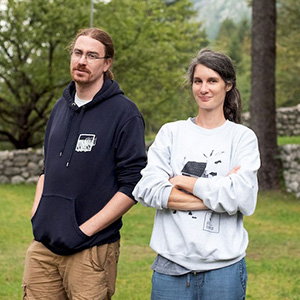
Abstract
PIFcamp is a week-long international summer art, technology and hacking camp, located in the Trenta valley in the Slovenian Alps. At PIFcamp, art, technology, and knowledge converge in a maelstrom of intense activity. Camp participants take the lead in conducting workshops, practical field trips, lectures, fieldwork and on-sight briefings. They actively participate in the development of various DIY/DITO/DIWO projects while collaborating in a creative working environment.
This summer, the 10th edition of the camp will take place in the picturesque Triglav National Park. Within the presentation Tina and Uroš from the Projekt Atol team, key organisers of the camp, will share its history, core principles, art and technology collaborations, community initiatives, and related networks.
Bio
Tina Dolinšek is Ljubljana based new-media art producer, education curator, and cultural facilitator, who has been working at Projekt Atol Institute since 2019 and collaborating with it since 2015. She has collaborated with numerous Slovenian cultural organisations, including LJUDMILA, Ljubljana Digital Media Lab and contributed articles to various Slovenian media. Since 2015 she has been the main engine behind PIFcamp and its success.
Uroš Veber is a cultural organizer, producer, and editor who develops and leads projects and programmes that transcend the boundaries between art, technology and science. Most of his work involves international productions in contemporary art, international networking and informal education and in his role as the main producer at the non-profit Projekt Atol Institute, he has been involved in numerous productions of a large number of young slovenia based media and conceptual artists. He is an active advocate for NGOs and the self-employed in the cultural sector and also co-leads two small music labels, rx-tx and kafana.
Projekt Atol Institute is a non-profit cultural and research organization, founded in 1992 by Marko Peljhan and formally established in 1994 in Ljubljana, Slovenia, as only the second cultural NGO in the country. Atol’s activities range from art and research art production, music events and exhibitions to technological development. Atol also started its music label rx:tx in 2002 and established a strong international network that enables its organization of transnational events, such as Changing Weathers, Resilients, Feral labs and Re-wilding culture. Over the past 10 years, Projekt Atol has primarily focused on developing new artworks and education setups with both local and international guest artists and developing a strong ecosystem of local creative communities. . Together with the Delak Institute and Ljudmila, ATOL runs an artist-led venue with studios, development laboratories, and workshops called osmo/za, located in Ljubljana.
For more information about the MAT Seminar Series, go to: seminar.mat.ucsb.edu.
For previous seminars, please visit our MAT Seminars Video Archive.
Thursday, May 30th, 2024
1 - 2:30pm PST.
Experimental Visualizaton Lab (room 2611 Elings Hall)
Abstract
This thesis presents the design and outcomes of SketchPath, a system that uses hand-drawn toolpaths to design for clay 3D printing. Drawing, as a direct manipulation technique, allows artists to design with the expressiveness of CAM-based tools without needing to work with a numerical system or constrained system. SketchPath works to provide artists with direct control over the outcomes of their form by not abstracting away machine operations or constraining the kinds of artifacts that can be produced. Artifacts produced with SketchPath emerge at a unique intersection of manual qualities and machine precision, creating works that blend handmade and machine aesthetics. In interactions with our system, ceramicists without a background in CAD/CAM were able to produce more complex forms with limited training, suggesting the future of CAM-based fabrication design can take on a wider range of modalities.
Wednesday, May 29, 2024
9am PDT
Experimental Visualizaton Lab (room 2611 Elings Hall)
Abstract
Recent machine learning research has demonstrated that many task-specific AI models now surpass human performance on static benchmarks. However, in real-world applications where human users collaborate with, or rely on AIs, key questions remain: Do these advancements in AI models inherently improve the user experience or augment users' capabilities? When and how should we partner users with AI to form effective human-AI teams? This dissertation explores new forms of human-AI collaboration in the context of real-world computer vision tasks. We shape a research space where users play different roles in diverse AI-assisted workflows -- from passive recipients of AI model outputs to active participants who steer the shaping of the model. 1) We developed intuitive user interfaces to help users, in this case astrophysicists, leverage deep-learning segmentation models in different scenarios. The end-to-end model enhances the accuracy of automated processing of daily space observations from 20+ telescopes globally. The AI-integrated GUI tool injects confidence into researchers' manual analysis of scientific imagery. 2) We proposed the concept of "restrained and zealous AIs" to harness the complementary strength in human-AI teams. Insights from a month-long user study involving 78 professional data annotators suggest that recommendations from ill-suited AI counterparts may detrimentally affect users' skills. 3) Finally, we brought a novel concept of "in-situ learning" to augmented reality, where the user interacts with physical objects to train spatially-aware AI models that can remember the personalized environment and objects for various tasks. Each project elevates the end user to a more active and engaged role in the inference, training, and evaluation processes of human-in-the-loop machine learning. In summary, this dissertation provides insights into the optimal times and methods for teaming humans with AI for real-world collaboration, informing the design of future AI-assisted systems.
Speaker: Daniel Bolojan
Monday, May 13th, 2024 at 1pm PST via Zoom.
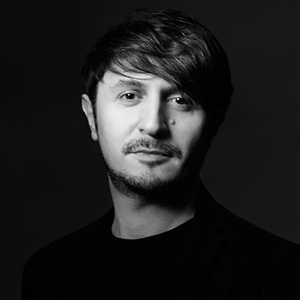
Abstract
The lecture will explore the evolution of Creative AI, particularly in the context of design, creative industries, shifting from singular, general-purpose models to a diverse ecosystem of specialized, interconnected systems. This transition highlights Creative AI's transformative impact in various design domains, signaling a new era of innovation and creativity in design. The focus will be on forward-looking projects that illustrate this paradigm shift, demonstrating how AI is becoming an essential, collaborative partner in the design process. The discussion will address the unique challenges and strategies for integrating AI into the complexities of design, emphasizing the importance of a multimodal approach. Implications of this shift will be considered, exploring how Creative AI can be effectively tailored to the specific needs of design contexts.
Bio
Daniel Bolojan is the Director of the Creative AI Lab and an Assistant Professor of AI and Computational Design at FAU, a Ph.D. candidate at Die Angewandte Vienna and Creative AI and Computational Design Specialist at CoopHimmelblau. Recognized as a leading voice in Creative AI, Deep Learning, and computational design within architectural realms, his research delves into the creation of deep learning strategies tailored for architectural design. This research addresses the complexities of shared-agency, designer creativity, and augmentation of design potency.
As a Creative AI and Computational Design Specialist at Coop Himmelb(l)au, Daniel pioneered the development of the award winning DeepHimmelblau Neural Network. This innovative project was developed with the aim of augmenting design processes and designers’ abilities. In 2013, he founded his own research studio Nonstandardstudio, a research studio that operates at the confluence of several crucial domains, including creative AI, deep learning, computation, multi-agent systems, generative design, and algorithmic techniques.
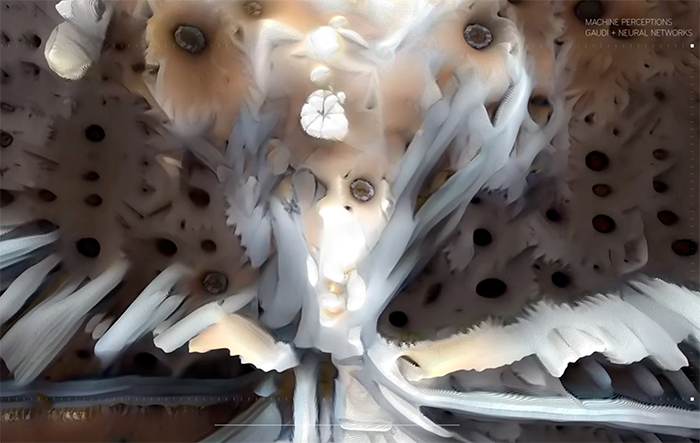
For more information about the MAT Seminar Series, go to: seminar.mat.ucsb.edu.
For previous seminars, please visit our MAT Seminars Video Archive.
Speaker: Deniz Çağlarcan
Monday, May 6th, 2024 at 1pm PST. Elings Hall room 1605 and via Zoom.
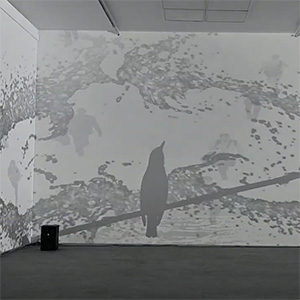
Abstract
While multidisciplinarity, interdisciplinarity, and transdisciplinarity have become new trends in the artistic field, the methodology and creative process of artwork differ according to the artist's primary disciplinary background. As a composer, I am exploring how music compositional techniques can inform the visual compositional process across various art disciplines. Specifically, I aim to investigate how understanding the connection between sound and image can enhance our comprehension of visual art and the creation of visual music compositions, as well as how these techniques can be utilized for artistic creativity. By examining the similarities and differences in the structure and meaning of sound and image in visual music composition, I seek to gain a better understanding of how these elements interact and can be utilized to inform visual composition. Ultimately, this approach can inspire artists to establish connections among different artistic disciplines.
In this research, my goal is to provide guidelines based on translating musical compositional techniques and concepts, such as tape music techniques, the relationship between syntactic structure and semantic discourse of the original material, and its role in gestural, textural, and formal structure, counterpoint, orchestration, spatialization, and music analysis methods such as Pierre Schaeffer’s “sound objects,” “TARTYP,” and reduced listening; R. Murray Schafer’s “signal,” “keynote,” “soundmark,” and “symbol”; François Bayle’s Image-Sound relation; and Simon Emmerson’s “language grid” scheme into visual arts, enabling the audience to apply the same principles to other artistic disciplines. I will investigate this relation into two main subjects; translation of the compositional techniques into visual arts in the concept of visual music and the relation of the meaning to the source material.
Bio
Deniz Çağlarcan is a Los Angeles-based composer, violist, conductor and transdisciplinary artist initially from Istanbul, Turkey. He investigates the sonic quality of "electronic music" by any means and realizes this idealized environment as a model for his musical language. Çağlarcan's works explore the interaction among acoustic instruments, electronic sounds, visuals, and other art disciplines within their morphological attributes. Besides, he is intrigued to create an environment by utilizing various immersive audio techniques as well as visuals and spatial elements that surround the audience. He performs interdisciplinary works collaborating with painters, media artists, computer graphics developers, and machine learning engineers.
His works include solo instrumental pieces, chamber music, large ensembles, tape/electroacoustic works, live-electronic, mixed works, audio/visual compositions, and site-specific sound installations. Besides his composition career as a violist, he performs in solo concerts, chamber music, new music ensembles, and popular music. He is also co-founder of the ADE Duo ensemble. He studied orchestral conducting for over eight years, and the lastest at Central Michigan University, he continued very in- depth study with José-Luis Maúrtua. He holds a Master of Music in Viola Performance from Central Michigan University and a Master of Arts in Composition from Bilkent University.
Çağlarcan is currently a Ph.D. student in Composition studying with João Pedro Oliveira and Master of Science in Media Arts and Technology with Curtis Roads at the University of California, Santa Barbara. He has studied with notable composers and performers; Mark Andre, Beat Furrer, Annette Vande Gorne, Tolga Yayalar, Bruno Mantovani, Ken Ueno, Pierluigi Billone, Clara Iannotta, Alberto Posadas, Isabel Mundry, Ulrich Kreppein, Laura San Martin, Jay C. Batzner, Alicia Valoti, Sheila Browne, Scott Woolweaver, Yuri Gandelsman, Tatjana Masurenko, Walter Küssner, Hartmut Rohde, Alexander Zemtsov, Ulrich Mertin, Christine Ruthledge.
For more information about the MAT Seminar Series, go to: seminar.mat.ucsb.edu.
For previous seminars, please visit our MAT Seminars Video Archive.
Speaker: Liam Young
Monday, April 29th, 2024 at 1pm PST. Elings Hall room 1605 and via Zoom.
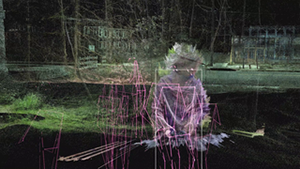
Abstract
Following centuries of colonization, globalization, and never-ending economic extraction, we have remade the world from the scale of the cell to the tectonic plate. The dystopias of science fiction that previously read as speculative cautionary tales are now the stage sets of the everyday as many of us live out our lives in a disaster film playing in real-time. In this seemingly futureless moment, the storytelling performance 'Planetary Imaginaries' will take us on a sci-fi safari through a screenscape of alternative and hopeful worlds. Slipping between fiction and documentary, the journey will be both an extraordinary image of tomorrow, and an urgent illumination of the environmental questions that are facing us today.
Bio
Liam Young is a designer, director and BAFTA nominated producer who operates in the spaces between design, fiction and futures. Described by the BBC as ‘the man designing our futures’, his visionary films and speculative worlds are both extraordinary images of tomorrow and urgent examinations of the environmental questions facing us today. As a worldbuilder he visualizes the cities, spaces and props of our imaginary futures for the film and television industry and with his own films he has premiered with platforms ranging from Channel 4, Apple+, SxSW, Tribeca, the New York Metropolitan Museum, The Royal Academy, Venice Biennale, the BBC and the Guardian. His films have been collected internationally by museums such as MoMA New York, the Art Institute of Chicago, the Victoria and Albert Museum, the National Gallery of Victoria and M Plus Hong Kong and has been acclaimed in both mainstream and design media including features with TED, Wired, New Scientist, Arte, Canal+, Time magazine and many more. His film work is informed by his academic research and has held guest professorships at Princeton University, MIT, and Cambridge and now runs the ground breaking Masters in Fiction and Entertainment at SCI Arc in Los Angeles. He has published several books including the recent Machine Landscapes: Architectures of the Post Anthropocene and Planet City, a story of a fictional city for the entire population of the earth.
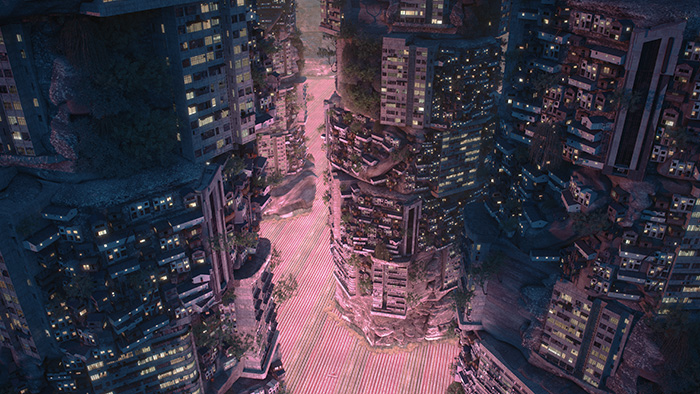
Planet City
For more information about the MAT Seminar Series, go to: seminar.mat.ucsb.edu.
For previous seminars, please visit our MAT Seminars Video Archive.
saccades (2002)
by Ted Moore (saxophone, electronics, and video) and Kyle Hutchins (saxophone)
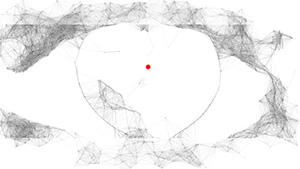
April 27th, 5pm - 8pm
CNSI AlloSphere, Elings Hall 2621
There will be multiple performances of the work starting at 5pm.
A "saccade" is a rapid movement of the eyeball between two fixed focal points.
During this brief moment, the brain hides this blurry motion from our perception. Once a saccade motion has begun, the destination cannot change, meaning that if the target of focus disappears the viewer won’t know until the saccade completes. If the field of vision is changing too quickly, the saccades may never be able to arrive at and focus on a target, instead, the objects in view are only perceived through peripheral vision. This phenomenon is imitated by the sound and video presented in the piece. It also serves as a metaphor for the density of information and high entropy experiences we constantly face. A scroll on social media, smartphone alerts, big data, technological advancements and predictions, the abundance of choices in the grocery aisle.
Ted Moore (he / him) is a composer, improviser, and intermedia artist whose work fuses sonic, visual, physical, and acoustic elements, often incorporating technology to create immersive, multidimensional experiences. After completing a PhD in Music Composition at the University of Chicago, Ted served as a postdoctoral Research Fellow in Creative Coding at the University of Huddersfield as part of the ERC-funded FluCoMa project, where he investigated the creative potential of machine learning algorithms and taught workshops on how artists can use machine learning in their creative music practice. Ted has continued offering workshops around the world on machine learning and creativity including at the University of Pennsylvania, Center for Computer Research in Music and Acoustics (CCRMA) at Stanford University, and Music Hackspace in London. Ted’s music has been presented by leading cultural institutions such as MassMoCA, South by Southwest, The Walker Art Center, and National Sawdust and presented by ensembles such as Talea Ensemble, International Contemporary Ensemble, the [Switch~ Ensemble], and the JACK Quartet. Ted has held artist residences with the Phonos Foundation in Barcelona, the Arts, Sciences, & Culture Initiative at the University of Chicago, and the Studio for Electro-Instrumental Music (STEIM) in Amsterdam. His sound art installations combine DIY electronics, embedded technologies, and spatial sound have been featured around the world including at the American Academy in Rome and New York University.
Kyle Hutchins is an internationally acclaimed performing artist and improviser. He has performed concerts and taught masterclasses across five continents at major festivals and venues in Australia, Belgium, Canada, Chile, China, Croatia, the Czech Republic, England, France, Germany, Ireland, Latvia, Mexico, Scotland, South Korea, and across the United States including Carnegie Hall, The Walker Art Center, World Saxophone Congress, Internationales Musikinstitut Darmstadt, International Computer Music Conference, among many others. He has recorded over two dozen albums on labels such as Carrier, Klavier, GIA, farpoint, Mother Brain, and his work has been recognized by awards and grants from DOWNBEAT, New Music USA, The American Prize, American Protégé International Competition, Music Teachers National Association, Mu Phi Epsilon Foundation, and others. As a specialist in experimental performance practice and electroacoustic new music, Kyle has performed well over 200 world premieres of new works for the saxophone. He has worked with some of the leading composers and performers of our time including Pauline Oliveros, George Lewis, Chaya Czernowin, Georges Aperghis, Richard Barrett, Steven Takasugi, Claire Chase, Douglas Ewart, Duo Gelland, and Zeitgeist. Over the past fifteen years, Kyle has built long standing collaborations and championed the music of many close collaborators such as Ted Moore, Tiffany M. Skidmore, Joey Crane, Emily Lau, Elizabeth A. Baker, Charles Nichols, Eric Lyon, and many more wonderful artists and dear friends. Kyle has served on the faculty of Virginia Tech since 2016 where he is Assistant Professor of Practice and Director of the New Music + Technology Festival at the Institute for Creativity, Arts, and Technology. Kyle has a Doctor of Musical Arts and Master of Music degree from the University of Minnesota, and Bachelors of Music in performance and Bachelors of Music Education degrees from the University of North Texas. His teachers include Eugene Rousseau, Eric Nestler, Marcus Weiss, and James Dillon. Kyle is a Yamaha, Légère, and E. Rousseau Mouthpiece Performing Artist.
Times
04:00 pm EST Fri, Mar 26, 2024 (New York, USA)
03:00 pm CDT Fri, Mar 26, 2024 (Chicago, USA)
01:00 pm PST Fri, Mar 26, 2024 (Los Angeles, USA)
08:00 pm UTC Fri, Mar 26, 2024 (Coordinated Universal Time)
Moderated by: Bhavleek Kaur, Virginia Melnyk, and Gustavo Rincon (PhD MAT)
Session Description
This survey of AI, Computation, Fabrication, Information (Data) & Robotics – Speculating on future trends of built form – looking at how research practice and experimentation come together to blur the lines between the creative imagination and the real. An Aesthetic Challenge to existing formal languages of material form – redefining New Mediated Architectures. While humans have built environments inspired by nature, what new research practices have contributed to extending the potential of A.I. & Robotics – imagining new ways of thinking from physical to virtualized paradigms as well as mixed paradigms. Information is intertwined with our states of humanity. We ask our community of artists, scientists and researchers to share visions as “proposals” for a better world by revealing their research as a paradigm shift engaging current technologies. This session will explore the conceptual implications of the potentiality of new visions for change in contemporary research practice combining the Arts, Design, and Sciences in A.I., (AR/VR/XR/Real) Worlds & Verses, Robotics, and Speculative Design/Arts Futures.
Presenters
For more information about the event: Anticipating the Architecture(s) of The Future
For more information about SPARKS: dac.siggraph.org
Speaker: Juan Escalante
Monday, April 22nd, 2024 at 1pm PST. Elings Hall room 1605 and via Zoom.
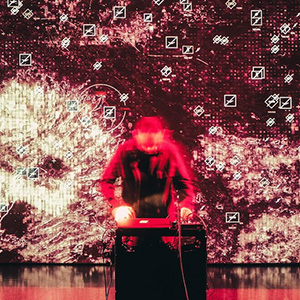
Abstract
My work relies on diagrams to parse the inner and outside world. These maps become machines of abstraction. They enable the translation of one medium, domain, or dataset into another. I use sound, drawings, and code to complete a process where computer programming occupies a central role, serving as an orchestration mechanism. Throughout most of my practice, source material, both empirical and speculative, is reinterpreted through a process of stochastic computation.
As a result, the work manifests through a wide range of outputs, such as performances, audiovisual work, graphic notation, print, and screen-based media. Over time, all of these forms rescript one another and keep the creative process in a state of flux. For the MAT Winter 2024 Seminar, I will discuss three recent software art projects using graphic scores, electronic sounds, and artificial intelligence.
Bio
Juan Manuel Escalante (b. Mexico City) is a Southern California-based artist and educator working with computer code, modular synthesizers, and analog drawings. His work has been shown in major festivals and exhibitions worldwide. He was a member of the National System of Art Creators (2017-2019 National Endowment for the Arts, MWX) and received the Corwin Award (1st prize) for Electronic-Acoustic Composition in 2016. Escalante holds an MFA in Architecture Design (UNAM) and a Ph.D. in Media Arts and Technology (University of California, Santa Barbara). He is currently an Assistant Professor in the Department of Art at the California State University, Fullerton.
For more information about the MAT Seminar Series, go to: seminar.mat.ucsb.edu.
For previous seminars, please visit our MAT Seminars Video Archive.
Friday, April 19th, 2024
7:30pm
The concert features works by Earl Howard (performing live on synthesizer and saxophone), Paris-based composer Horacio Vaggione, the late Corwin Chair Clarence Barlow, UCSB Music Composition graduate student Dariush Derekshani, and CREATE’s Associate Director Curtis Roads.
Event Details (PDF):
This event is free admission and open to the public.
Speaker: Andrés Burbano
Monday, April 15th, 2024 at 1pm PST via Zoom.
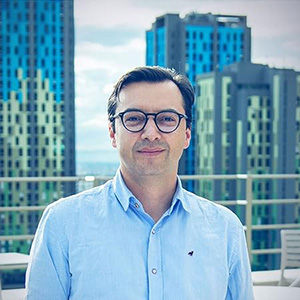
Abstract
"Machines, Imagination and Latin American Visions: A Panorama of Profound Contributions" investigates the emergence of technologies in Latin America to create images, sounds, video games, and physical interactions. The book contributes to the construction of a historiographical and theoretical framework for understanding the work of creators who have been geographically and historically marginalized through the study of five exemplary and yet relatively unknown artifacts built by engineers, scientists, artists, and innovators. It offers a broad and detailed view of the complex and sometimes unlikely conditions under which technological innovation is possible and of the problematic logics under which these innovations may come to be devalued as historically irrelevant. Through its focus on media technologies, the book presents the interactions between technological and artistic creativity, working towards a wider understanding of the shifts in both fields that have shaped current perceptions, practices, and design principles while bringing into view the personal, social, and geopolitical singularities embodied by particular devices. It will be an engaging and insightful read for scholars, researchers, and students across a wide range of disciplines, such as media studies, art and design, architecture, cultural history, and the digital humanities.
Bio
Andrés Burbano is Professor in the Arts and Humanities School at the Open University of Catalunya (Barcelona, Spain) and Visiting Lecturer at Donau-Universität (Krems, Austria). He holds a Ph.D. in Media Arts and Technology from the University of California at Santa Barbara (California, EEUU) and has developed most of his academic career in the School of Architecture and Design at Universidad de los Andes (Bogotá, Colombia). Burbano works as a researcher, curator, and interdisciplinary artist. His research projects focus on media history and media archaeology in Latin America and the Global South, 3D modeling of archaeological sites, and computational technologies' historical and cultural impact. Burbano has been appointed as ACM SIGGRAPH 2024 Chair.
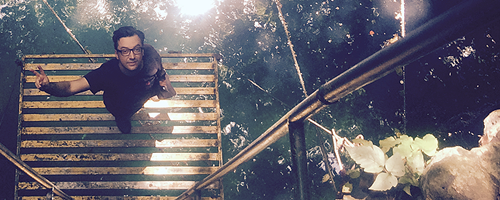
Professor Burbano's latest book:
Different Engines - Media Technologies From Latin America
For more information about the MAT Seminar Series, go to: seminar.mat.ucsb.edu.
For previous seminars, please visit our MAT Seminars Video Archive.
Speaker: Alberto Estevez
Monday, April 8th, 2024 at 1pm PST. Elings Hall room 1605 and via Zoom.
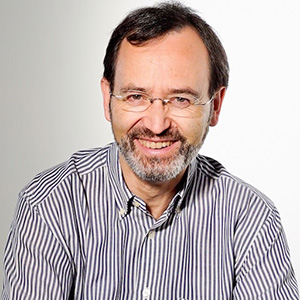
Abstract
The Modern Movement of the 20th century worked to design "from the spoon to the city." We, the inhabitants of the 21st century, can transcend working only on the surface of things, as has been done for millennia. Now it is time to design "from the DNA to the planet". From the cell and the bit, to beyond, to the entire Solar System. Thus, is shown here, on some ideas, multi-scalar and transdisciplinary works, around the fusion of the biological world and the digital world apply to architecture & design, genetics and computation, natural intelligence and artificial intelligence, bio-learning and machine-learning, biological techniques and digital techniques, bio-manufacturing and digital-manufacturing.
Bio
Alberto T. Estévez, architect, with a professional office of architecture and design in Barcelona since 1983. Chairman-professor, founder (in 1996) and first director of ESARQ, the School of Architecture of UIC Barcelona (Universitat Internacional de Catalunya), as an avant-garde school during its first 9 years. Founder (in 1998) and first director of UIC Architecture PhD and Masters. Director of iBAG-UIC Barcelona (Institute for BioDigital Architecture & Genetics), that includes the Genetic Architectures Research Group and Office (since 2000), and the Master’s Degree in Biodigital Architecture (since 2000). He has written more than 300 publications, participated in a large number of exhibitions, congresses, committees, and invited lectures around the world, presenting his ideas, projects and works.
geneticarchitectures.weebly.com
www.biodigitalarchitecture.com
For more information about the MAT Seminar Series, go to: seminar.mat.ucsb.edu.
For previous seminars, please visit our MAT Seminars Video Archive.
Speaker: Chris Kallmyer
Monday, March 11th, 2024 at 1pm PST. Elings Hall room 1605 and via Zoom.
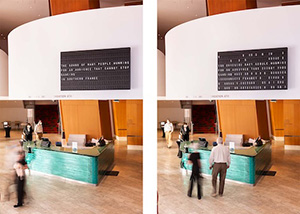
Abstract
The lecture will explore how sound and context transform the way we use technology to inspire meaning and change in listeners. Through this talk we will outline the strategies employed by mid-century experimentalists, pre-enlightenment collectivists, and the prospect of a post-industrial revolution. Chris will expand upon the generative work currently installed in Elings Hall, Song Cycle, and the emerging relationships between audience and performer – artist and community – technology and environment.
Bio
Chris Kallmyer is an artist working at the intersection of music, architecture, and design. Through his work, he creates collective experiences driven by his interests in listening, landscape, and community. His multi-disciplinary works have been exhibited and performed at the San Francisco Museum of Modern Art, Walker Art Center, Pulitzer Arts Foundation, Los Angeles Philharmonic, and STUDIO TeatrGaleria in Warsaw among other spaces in America, Europe, and Asia. His studio is located on the Silver Penny Farm in Petaluma, CA.
For more information about the MAT Seminar Series, go to: seminar.mat.ucsb.edu.
For previous seminars, please visit our MAT Seminars Video Archive.
Thursday, March 7, 2024
6 - 10pm
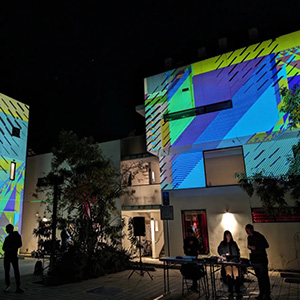
RARE_vol.02: Realities Altered Realities Emerging
Works by:
Synthux Hackathon projects:
"Vitrified Sounds"
"MYS"
"TouchPulse BitBox"
Guest Artist:
Professor George Legrady
The Santa Barbara Center for Art, Science and Technology (SBCAST) is located at 513 Garden Street in downtown Santa Barbara.
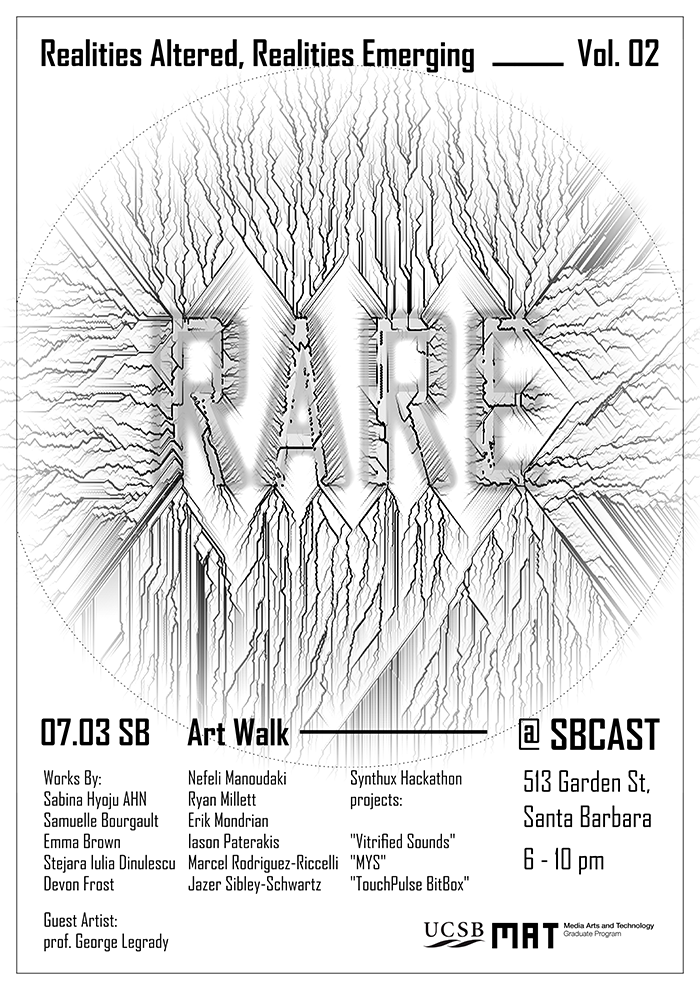
Speaker: Weidi Zhang
Monday, March 4th, 2024 at 1pm PST. Elings Hall room 1605 and via Zoom.
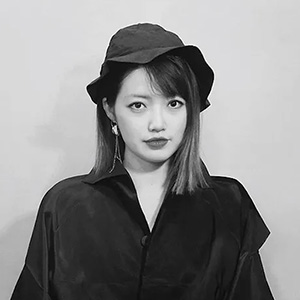
Abstract
Weidi will present her practice-based research on Speculative Assemblage. She'll introduce her recent experimental visualization artworks, including 'ReCollection,' 'Cangjie's Poetry,' 'Wayfarer,' and 'Astro.' Her discussion will delve into her practices at the intersection of immersive art, AI system design, and experimental visualization.
Bio
Weidi Zhang is a new media artist/designer based in Los Angeles and Phoenix. She is a tenure-track Assistant Professor of immersive experience design at the Media and Immersive eXperience (MIX) center of Arizona State University. Her interdisciplinary art and design research investigates A Speculative Assemblage at the intersection of immersive media design, experimental data visualization, and interactive AI art.
Her works are featured in international media art and design awards, such as the Best In Show Award in SIGGRAPH (2021,2022), Red Dot Design Award (2022), Honorary Mention in Prix Ars Electronica (2022), Juried Selection in Japan Media Arts Festival(2020), Lumen Prize shortlists (2020, 2021), and others. Her works have been exhibited internationally such as Times Art Museum (CN), Centre de Cultura Contemporània de Barcelona, Society For Arts and Technology (CA), SwissNex Gallery (USA), V2_Lab (NL), ISEA, CVPR, IEEE VISAP, Mutek (MX), Mira Fest (Spain), Zeiss Major Planetarium (GE), Planetarium 1 (RUS), and among others. She holds her Ph.D. degree in Media Arts and Technology at the University of California, Santa Barbara, an MFA degree in Art + Technology at the California Institute of the Arts, and a BFA degree in Photo/Media at the University of Washington, Seattle. She lectured at both UC Santa Barbara and The Ohio State University.
For more information about the MAT Seminar Series, go to: seminar.mat.ucsb.edu.
For previous seminars, please visit our MAT Seminars Video Archive.
Sunday, March 3rd, 2024
2-6pm
Modular Building 387 - 1015
Intro to Modular Synthesis
Hybrid In Person / Virtual Workshop
Description
CREATE and Media Arts & Technology present, an Intro to Modular Synthesis Workshop by Curtis Roads and Marcel Rodriguez-Riccelli. They'll be giving a retrospective of the history of synthesis and analog computing, before breaking down the basics with demonstration on a hardware eurorack system, and giving participants the foundational knowledge needed to delve further into creating music with modular synthesizers on their own. There will also be a practical portion, in which participants will be able to create their own eurorack synthesizers with the free virtual eurorack software VCV Rack 2.
We encourage anybody who’s curious to join, regardless of experience or skill level. Modular synthesis is a fun and engaging way for both people with no musical background to begin to understand musical concepts and for studied musicians to expand their practice. Foreknowledge of certain basic musical concepts is assumed in the lesson plan, but more time can be taken to go further in depth as is necessary at participant’s request.
The workshop will also be possible over Zoom.
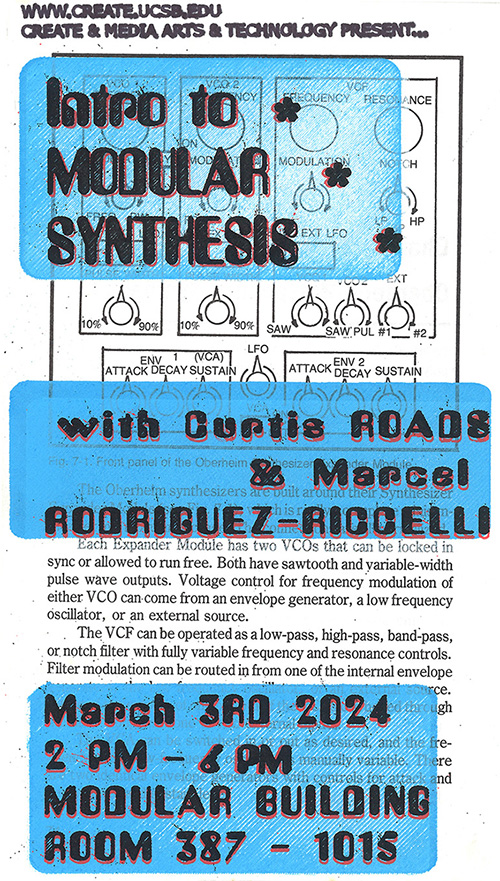
Friday March 1st, 2024
3:30pm PST
Experimental Visualizaton Lab (room 2611 Elings Hall)
Abstract
Virtual reality (VR) perspective-taking experiences focused on imagined intergroup contact with individuals from marginalized groups can increase prosocial behavior toward them (van Loon, Bailenson, Zaki, Bostick, Willer 2018). Intergroup contact theory hypothesizes that reducing anxiety, which is the cause of increased stereotyping against the outgroup, and permeating the social encounter with positive emotions (Miller, Smith, & Mackie, 2004) leads to prejudice mitigation (Pettigrew & Tropp, 2006). Beyond these insights from social psychology, sparse literature has explored how to design immersive story worlds to instill prosocial attitudes and behaviors, including the effectiveness of employing photorealistic techniques. This research fills this gap and challenges the assumption that human perceptions inside virtual and physical worlds are equal if digital assets are photorealistic.
Through the creation of a taxonomy of design for inclusive VR, developed from playtesting six state-of-the-art VR experiences, it identifies which affordances and methodologies are significant to inducing prosocial attitudes in immersive social encounters and contributes a pragmatic approach to the design of VR for bias reduction while considering the craft, ethical and humanistic dimensions of the medium.
Speaker: Dana Diminescu
Monday, February 26th, 2024 at 1pm PST. Elings Hall room 1605 and via Zoom.
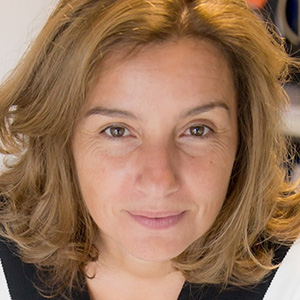
Abstract
In "Why I Came," which is also the title of her latest work, Prof. Dana Diminescu will showcase a series of "research / creation" projects she has undertaken. These projects involve experimental protocols, including surveys and prototypes, challenging the notion of a research world separate from the realms of art.
The session will culminate with "Why I Welcome," an interactive installation utilizing data from a refugee reception platform. Since 2015, the SINGA association's program "J’accueille!” (I welcome) has connected French families with refugees, resulting in thousands of hosts by the end of 2022. "Why I Welcome" has become a part of the permanent collection at the National Museum of Immigration History | Palais de la Porte Dorée, in Paris. It was also presented exclusively at the Gaîté Lyrique – Factory of the Time, an interactive art installation venue in Paris during its opening weekend in May, 2023, highlighting Dana Diminescu's research on hospitality and connected migrants.
Bio
Dana Diminescu is a social science researcher and artist, currently holding the position of Senior Lecturer/Associate Professor at the Télécom Paris engineering school, and is a member of Spiral, the art & science chair of the Institut Polytechnique de Paris. She serves as the Coordinator of the DiasporasLab. She is renowned for her work on the "connected migrant" and for introducing various epistemological and methodological innovations. Notably, she spearheaded the e-Diasporas Atlas project, which received recognition for the 2012 Digital Humanities Awards. Recently, Diminescu developed the JokaJobs application for jobseekers from Generation Y, designed specifically for smartphones.
For more information about the MAT Seminar Series, go to: seminar.mat.ucsb.edu.
For previous seminars, please visit our MAT Seminars Video Archive.
Wednesday, February 21st, 2024
12:30 - 2pm PST
Room 2003 (MAT Conference Room)
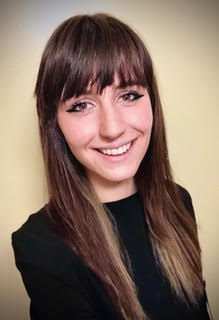
Abstract
Our feelings of being in control over our actions and their consequences are broadly referred to as the sense of agency, which is of importance within the disciplines of neuroscience, haptics, and human-computer interaction. However, each field defines and contextualizes agency with unique perspectives, considerations, and applications. This report begins by examining our sense of agency when performing hand movements — referred to throughout as kinesthetic agency — and subsequent sensorimotor consequences affecting our perception of touch. It further explores and contextualizes our sense of agency at the intersection of human-computer interaction, aesthetics, and creative collaboration, highlighting the importance of a user’s perceived agency throughout their interactions with systems, tools, or iterative processes.
While both perceived and kinesthetic agencies of interacting entities are important lenses through which we design and evaluate interactive systems, it is additionally useful to analyze how their intersections and couplings afford co-produced aesthetic outcomes. I distinguish between agency sharing, conceptualized as a continuous collaboration between two or more entities, and agency exchange, conceptualized as the hand-off of decision-making or control between entities. The nuances of – and degrees to which – perceived and/or kinesthetic agency is shared and/or exchanged between entities impact their interactions with the system as a whole, as well as the co-produced outcomes.
Through the presentation and critical analysis of four co-productive systems, tools, or pipelines developed in my own studio and research practice between 2020 and 2023, I impart my perspective and considerations for designing interactions and systems for artistic co-production. Metrics of evaluation include 1) schematic representations of how agency is shared and/or exchanged between agentic entities and systems or processes, 2) aesthetic critique of the outcomes (i.e. drawings, sculptures, live installations, etc.) as artworks in their own right, and 3) developer, user, and audience feedback during iteration and exhibition. Such an analysis, performed during the design and iteration stages of system development, can aid artists, researchers, and developers in engaging with unique co-design and co-productive processes.
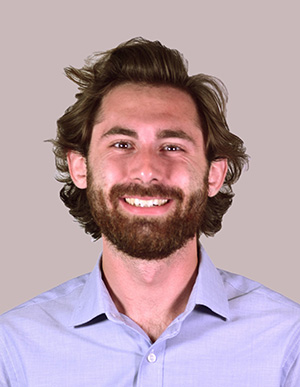
Tuesday, February 20, 2024
10am PST
Room 1601 Elings Hall and via Zoom
Abstract
A longstanding goal in haptics is to engineer high-fidelity displays for spatially distributed haptic feedback, specified as digital media. Such haptic displays would make it possible to touch, feel, and interact with dynamic scenes, objects, or information presented anywhere in a continuous display medium, such as an interactive surface or three-dimensional environment. They would thus represent the haptic analogs of two- or three-dimensional video displays. This dissertation advances knowledge in the design and operational principles of such haptic displays, focusing on emerging technologies that harness and control propagating mechanical waves to deliver spatiotemporally distributed haptic feedback. Central to the innovation of wave-mediated haptic display is that the spatial resolution of haptic feedback is governed by the control of wave transmission rather than by the number and density of actuators, as would be the case in conventional approaches. This wave-mediated strategy reduces complexity, enabling practical and scalable displays capable of reproducing dynamic haptic media. This Ph.D. dissertation contributes new display designs exploiting wave transmission, algorithms and methods for wave-mediated haptic display, experimental findings that mechanically and perceptually characterize the proposed display methods, and investigations of the influence of skin biomechanics on display fidelity.
Speaker: Spencer Lowell
Monday, February 12th, 2024 at 1pm PST. Elings Hall room 1605 and via Zoom.
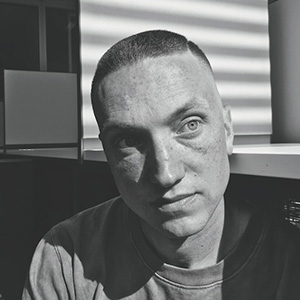
Abstract
Join internationally renowned technology photographer Spencer Lowell as he presents his practice and discusses his (in production) book The Nature of Things - about the complex and evolving relationship between humans and technology.
Bio
Spencer Lowell is an award-winning Los Angeles-based photographer whose work blurs the line between art and science.
His assignments for many of the world’s leading magazines have taken him from a research ship in the Mediterranean to a desalination plant in Dubai to Norway’s Global Seed Vault to the Fukushima Daiichi nuclear plant to Mark Zuckerberg’s office.
Drawn into the field at age 16 by his first job in a one-hour photo lab, Spencer studied at Art Center College of Design in Pasadena. His graduation project, which included platinum palladium prints of images taken by the Hubble Space Telescope, caught the eye of officials from NASA’s Jet Propulsion Laboratory, who commissioned him to document their work. The resulting photos of the construction of the Mars rover “Curiosity” wound up published in Time and several other magazines.
Since then, Spencer's images of scientific laboratories and industrial facilities, and portraits of leading researchers and corporate moguls, have appeared on the covers of the New York Times Magazine, Time, Wired, Fortune and Popular Science, as well as in the pages of GQ, The Atlantic, Esquire, Rolling Stone and many other publications. He has also created commercial work for clients ranging from IBM to Google to Budweiser to Christie’s to The San Francisco Symphony as well as companies he can’t name because of NDA's. He was named a “photographer to watch” by Photo District News in 2011, and his work has been honored by American Photographer, Communication Arts Photo Annual and PDN Photo Annual.
A video recording of the talk is available on Vimeo.
For more information about the MAT Seminar Series, go to: seminar.mat.ucsb.edu.
For previous seminars, please visit our MAT Seminars Video Archive.
Speaker: Márton Orosz
Monday, January 29th, 2024 at 1pm PST. Elings Hall room 1605 and via Zoom.
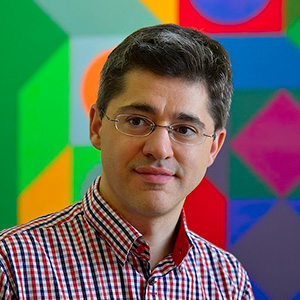
Abstract
Márton Orosz's presentation explores the life and work of György Kepes, an early pioneer of new media art. Kepes, a painter, designer, photographer, impresario, and polymath, founded the Center for Advanced Visual Studies (CAVS) at MIT in 1967, serving as a precursor to contemporary media art institutions and educational programs.
Kepes was among the first who suggested the intersection of art, science, and technology and the first one who established a program within the academic curriculum dedicated to this innovative pursuit. His significance lies in his cybernetic approach to crafting multisensory urban environments, exploration of novel theories on human perception evident in his 1944 textbook "Language of Vision," and the innovative repurposing of scientific images into aesthetic objects, showcased in his 1951 exhibition, "The New Landscape."
Orosz explores Kepes's contributions to visual aesthetics, his creative process, and visionary concepts that provided prosthetics to mimic nature, offering an avant-garde perspective in Post-War art history for building a sustainable world. The lecture introduces Kepes's realized and unrealized artworks, illustrating his mission to humanize science and cultivate ecological awareness through the creative use of technology.
The central question addressed is how to develop an agenda that bridges aesthetics and engineering, not merely as a gap-filling exercise but as a means to forge a human-centered ecology using cutting-edge technology. What were the chances in Kepes's time and what are the chances today to democratize our vision through the power of the (thinking) eye?
Bio
Dr. Márton Orosz serves as the founder and Curator of the Collection of Photography and Media Arts at the Museum of Fine Arts – Hungarian National Gallery in Budapest. Since 2014, he has held the position of Director at the museum dedicated to Victor Vasarely, which is part of the same institution. Dr. Orosz also holds the role of scientific advisor to the Kepes Institute in Eger and the Michèle Vasarely Foundation in Puerto Rico. He has curated numerous exhibitions across the globe, written books and articles on various art-related subjects, and delivered lectures in several locations, including Europe, the United States, and Asia. His research and publications encompass a wide range of fields, including light-based media, photography, avant-garde collecting, abstract geometric and kinetic art, computer art, motion picture, and animated film. His first documentary film, titled György Kepes – Interthinking Art + Science was completed in 2023 and garnered recognition and accolades at many international film festivals.
A video recording of the talk is available on Vimeo.
For more information about the MAT Seminar Series, go to: seminar.mat.ucsb.edu.
For previous seminars, please visit our MAT Seminars Video Archive.
Speaker: Leslie Garcia
Monday, January 22nd, 2024 at 1pm PST via Zoom
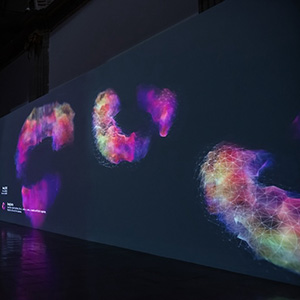
Abstract
In this seminar we will analyze the relationship and origins of cybernetics and its technological intersections. We will also address the evolution of AI from a historical context and some of its practitioners from artistic research.
Bio
Interspecifics is an international Independent artistic research bureau founded in Mexico City in 2013. We have focused our research on the use of sound and A.I., to explore patterns emerging from biosignals and the morphology of different living organisms as a potential form of non-human communication. With this aim, we have developed a collection of experimental research and education tools we call Ontological Machines. Our work is deeply shaped by the Latin American context where precarity enables creative action and ancient technologies meet cutting-edge forms of production. Our current lines of research are shifting towards exploring the hard problem of consciousness and the close relationship between mind and matter, where magic appears to be fundamental. Sound remains our interface to the universe.
A video recording of the talk is available on Vimeo.
For more information about the MAT Seminar Series, go to: seminar.mat.ucsb.edu.
For previous seminars, please visit our MAT Seminars Video Archive.
Sunday, January 21st from 5-6pm at SBCAST (531 Garden St, Santa Barbara) and via Zoom
The panelists for this presentation are Raphaël Bessette, T Braun, Amanda Gutierrez, Laura Magnusson.
Abstract
A research-creation panel with four Montréal-based PhD researchers (Concordia University) who will share their research-creation on the topics of Feminist/Queer/Trans* Research-Creation Methodologies. This will be an intimate setting with some light refreshments and snacks provided.
Bios
Raphaël Bessette
Raphaël was born and raised in Gatineau, on the unceded territory of the Algonquin-Anishinabeg Nation and is currently pursuing their PhD on the unceded lands of the Kanien’kehá:ka Nation in Tio'tiá:ke/Montreal. They hold a BA in political science (Université de Montréal), MA in Gender Studies (Université de Genève), an MA in Visual Anthropology (Université Paris Nanterre), and a DIU in research-creation (Université Paris-8/Université Paris Nanterre). Working across documentary and experimental film, their work has been shown at festivals such as Premier Regards - Festival International Jean Rouch (Paris), Festival International du Film Ethnographique du Québec and Festival de la Poésie de Montréal/Tio'tiá:ke.
Their current PhD research is situated at the intersections of trans* studies, critical disability studies, science and technology studies and research-creation and focuses on the parallel and connected practices of trans* embodiment and experimental filmmaking. They explore the relations between materials and bodies in their engagements with prosthetics (binders, breast forms, tucking underwear, packing, stand-to-pee devices, sex-toys, etc.) and in filmmaking techniques of frame-by-frame animation and process cinema.
T Braun
T Braun is an interdisciplinary artist who creates virtual worlds, drag performances, and interactive installations that challenge binary notions of gender. They are currently based in Tiohtià:ke (Montreal) and are pursuing a Ph.D. in Humanities at Concordia University. Their Ph.D. work explores how queer VR enthusiasts envision the metaverse, create gender-affirming content, and form virtual communities. They are currently conducting interviews and co-creating virtual worlds with trans* artists in the social VR platform VRChat.
Amanda Gutierrez
Amanda Gutierrez (b. 1978, Mexico City) explores the experience of political listening and gender studies by bringing into focus soundwalking practices. Trained and graduated initially as a stage designer from The National School of Theater, Gutiérrez uses a range of digital media tools to investigate everyday life aural agencies and collective identities. Approaching these questions from aural perspectives continues to be of particular interest to Gutiérrez, who completed her MFA in Media and Performance Studies at the School of the Art Institute of Chicago. She is currently elaborating on the academic dimension of her work as a Ph.D. candidate in Arts and Humanities at Concordia University in the Arts and Humanities Doctoral program. Gutiérrez has held numerous international art residencies such as FACT, Liverpool in the UK, ZKM in Germany, TAV in Taiwan, Bolit Art Center in Spain, and her artwork has been exhibited internationally in venues such as The Liverpool Biennale in 2012, Lower Manhattan Cultural Council, Harvestworks in NYC, SBC Gallery, Undefined Radio in Montreal, Errant Bodies Studio Press in Berlin, among other.
Laura Magnusson
Laura Magnusson is a Canadian interdisciplinary artist and filmmaker based in Tiohtià:ke/ (Montreal). Her current research-creation explores and elucidates felt experiences of violence and trauma through installation, sculpture, drawing, performance, and video. She is a trained scuba diver who has filmed underwater in Iceland and Mexico, using the medium water as a site for healing and reconnecting to the body. Magnusson holds an MFA in Interdisciplinary Art from the University of Michigan (2019), and is currently pursuing a PhD in Interdisciplinary Humanities at Concordia University.
For more information about the MAT Seminar Series, go to: seminar.mat.ucsb.edu.
For previous seminars, please visit our MAT Seminars Video Archive.
Speaker: Danielle Garrison
Monday, January 8th, 2024 at 1pm PST in room 1605 Elings Hall and via Zoom
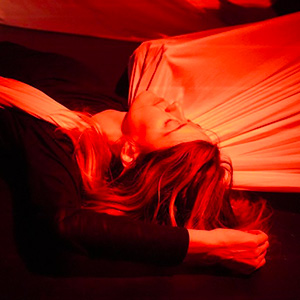
Abstract
In this gathering, you are invited to interact with my heart tethering research. We will sense our heartbeats somatically through sensorial guiding and biometrically (pulse oximeters that translate into sound, lights and haptics) in collaboration with Ryan McCullough. We will practice tethering with a horizontal aerial fabric loop, which acts as a touch conduit between our bodies. We will engage the heart as a gateway to sense our nervous system states, determining how we co-sense our spatial relation. Please wear comfortable clothes, socks, and bring a pen.
Danielle creates interactive aerial dance experiences to re-ignite embodied interaction in a post-touch era questioning what aerial arts can do. She has been creating an emergent aerial dance technique called tethering, which consists of a horizontal fabric that mediates touch to develop practices and guidelines around consent in artistic collaborations. Materializing as a research-creation project, heart tethering engages polyvagal theory as a language to co-sense and identify nervous system states in relational encounters by tuning into heart-based dynamics. This process hones awareness of the heartbeat by sensing the heart somatically (scanning layers from external proprioception to internal interoception called heartception) and biometrically (pulse oximeters that translate into sound, lights and haptics) in collaboration with Ryan McCullough. The event centers around the three phases of the heartbeat—contract, rest, release—as a guiding framework to explore movement, adapt spacing, slow timing, and experiment with a spectrum of response-abilities. This research asks what happens when we become more aware of our heart in each moment and how does it change our relation with another? What emerges when we prioritize co-sensing and communicating with creative methodologies that honor complexities and critically engage with the ever-evolving practice of consent within encounters? Danielle is an interdisciplinary humanities PhD student in research-creation at Concordia University (Montréal) directed by Angélique Willkie, Erin Manning, and VK Preston and the University of Montpellier (France) supervised by Alix de Morant, as well as a 4-year Fulbright Specialist (2021-2025).
Bio
While pursuing her MFA in Dance (somatics/aerial arts) from the University of Colorado-Boulder, Danielle was a Fulbright Scholar to France (2017-2018) where she created an interdisciplinary project weaving contemporary dance, circus, visual arts and film exploring the topic of grief in news media. Recent aerial residencies include SenseLab (Montréal), Milieux (Montréal), Nils Obstrat (Paris), Ecole Media Art du Grand Chalon (Chalon- sur- Saône), La Grainerie (Toulouse), the Circus Dialogues Project’s 4th encounter (Avallon), and SBCAST (Santa Barbara Center for Arts, Science and Technology). Danielle has performed and/or taught for Aerial Dance Chicago, Frequent Flyers Productions, Les Rencontres de Danse Aérienne, the Berlin Circus Festival, Frequent Flyers Aerial Dance Festival, Santa Barbara Floor to Air Festival, Aerial Greece, and the San Francisco Aerial Dance Festival. In 2020, she co-created Aerial Reflexionando (virtual aerial arts colloque) with Ana Prada to support critical exchange on contemporary aerial arts in the Americas.
A video recording of the talk is available on Vimeo.
For more information about the MAT Seminar Series, go to: seminar.mat.ucsb.edu.
For previous seminars, please visit our MAT Seminars Video Archive.
Tuesday, December 12th, 2023
11am PST
transLAB (Room 2615, Elings Hall) and via Zoom
Abstract
The coming wave of new media technologies relying on generative composition and Artificial Intelligence (AI) has introduced novel opportunities in transmodal synthesis and creative synergies within real-time composition networks. The term ‘perforated systems’ as proposed by Marcos Novak, is used to describe the collaborative systems that arise from dialogues between diversified environments operating through flowing fields of data. Such systems allow for the creation of complex artificial, physical, and hybrid environments in Extended Reality (XR) through real-time collaboration.
This master thesis delves into the intersection of XR technologies, transmodal environments, and generative AI in speculative architectural composition, unveiling paradigms of hybrid ‘perforated systems’ in the form of interior and urban installations. These installations propose alternative environments through a fusion of tangible artifacts, olfactory, audio, and visual components, and explore the interplay between dynamic and diverse data-driven compositions in XR.
Ranging from biodata-driven abstract worlds in Virtual Reality (VR), to Mixed Reality (MR) installations like the ‘Synaptic Time Tunnel’ presented in SIGGRAPH 2023, and AI-generated urban projection mapping performances, these endeavors fuse cutting-edge technologies with generative AI tools to achieve maximal complexity with minimal initial conditions.
In the age of data, networks, and AI, the potential for collaboration between different fields and creators is vast and profound. The present thesis aims to demonstrate how transdisciplinary ‘perforated’ networks can generate complex and abstract compositions that emerge from simple elements and expand into Extended Reality. The objective is to harness the potential of merging "perforated systems" with AI, XR technologies, and the built environment, to foster the development of immersive and collaborative experiences that push the boundaries of worldmaking.
Speaker: Jenni Sorkin
Monday, December 4th, 2023 at 12pm noon PST in room 1605 Elings Hall and via Zoom
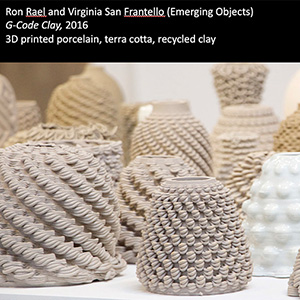
Abstract
In looking back to Arts & Crafts predecessors, this lecture argues for a historical framework for digital ceramics.
Bio
Jenni Sorkin is Professor of History of Art & Architecture at University of California, Santa Barbara, and is affiliated in the Art, Feminist Studies, and History Departments. She writes on the intersections between gender, material culture, and contemporary art, working primarily on women artists and underrepresented media. Her books include: Live Form: Women, Ceramics and Community (University of Chicago, 2016), Revolution in the Making: Abstract Sculpture by Women Artists, 1947-2016 (Skira, 2016) and Art in California (Thames & Hudson, 2021), as well as numerous essays in journals and exhibition catalogs. She serves on the University of California Press Editorial Board, as the Co-Executive Editor of Panorama: the Association of Historians of American Art, and is a member of the Editorial Board of the Journal of Modern Craft. She received her PhD in the History of Art from Yale University.
For more information about the MAT Seminar Series, go to: seminar.mat.ucsb.edu.
For previous seminars, please visit our MAT Seminars Video Archive.
Speaker: Anna Mansueti
Monday, November 27th, 2023 at 1pm PST via Zoom
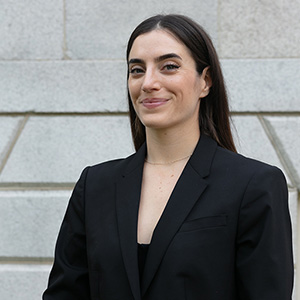
Abstract
In Demining Reimagined, I explore new ways to supplement and improve humanitarian demining practices, UXO mission planning and reporting procedures, and mine action campaigning. The project consists of a booklet containing Anna’s research on this topic, stories about landmines and cluster munitions, drawings, detailed maps, and a video performance titled ‘Hazardous Fragmentation Distance(s)’.
Bio
Anna Mansueti is an interdisciplinary artist and designer. She completed her BA in Studio Art from the University of Colorado Boulder in 2012, and upon graduating, commissioned in the US Navy as an Explosive Ordnance Disposal (EOD) officer. For the following ten years, she served as a bomb technician and diver, conducting humanitarian mine action missions and multinational training operations with foreign partner forces in Europe and Southeast Asia. During her time as a Master in Design Studies (MDes) candidate at the GSD, Anna focused on the aftermath of war, unexploded ordnance and environmental degradation, and post-conflict reconciliation. She has also worked on a series of projects about veteran mental health, post-traumatic stress, and gender equity in the con, and is currently interested in new ways to supplement and improve the demining space. She is passionate about using artistic intelligence to reimagine new ways in the face of sustained periods of violence.
For more information about the MAT Seminar Series, go to: seminar.mat.ucsb.edu.
For previous seminars, please visit our MAT Seminars Video Archive.
Speaker: Ralf Baecker
November 20th, 2023 at 1pm PST via Zoom.
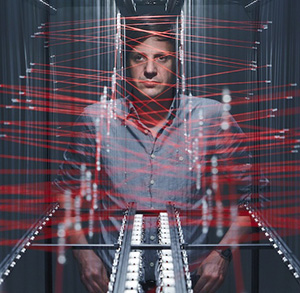
Abstract
After publishing his comprehensive book, Professor and artist and researcher Ralf Baecker is returning to the MAT Seminar to present his latest research and performance endeavor, Natural History of Networks in discussion with Professor Marko Peljhan and curators Daria Parkhomenko and Andreas Broeckmann.
Bio
Ralf Baecker (*1977 Düsseldorf, Germany) is an artist working at the interface of art, science, and technology. Through installations, autonomous machines, and performances, he explores the underlying mechanisms of new media and technology. His objects perform physical realizations of thought experiments that act as subjective epistemological objects to pose fundamental questions about the digital, technology and complex systems and their entanglements with the socio-political sphere. His projects seek to provoke new imaginaries of the machinic, the artificial and the real. A radical form of engineering that bridges traditionally discreet machine thinking with alternative technological perspectives and a new material understanding that makes use of self-organizing principles.
Baecker has been awarded multiple prizes and grants for his artistic work, including the grand prize of the Japan Media Art Festival in 2017, an honorary mention at the Prix Ars Electronica in 2012 and 2014, the second prize at the VIDA 14.0 Art & Artificial Life Award in Madrid, a working grant of the Stiftung Kunstfonds Bonn, the Stiftung Niedersachsen work stipend for Media Art 2010 and the stipend of the Graduate School for the Arts from the University of the Arts in Berlin and the Einstein Foundation.
His work has been presented in international festivals and exhibitions, such as the International Triennial of New Media Art 2014 in Beijing, Künstlerhaus Wien, ZKM | Center for Art and New Media in Karlsruhe, Martin-Gropius-Bau in Berlin, WINZAVOD Center for Contemporary Art in Moscow, Laboral Centro de Arte in Gijón, Centre de Cultura Contemporània de Barcelona (CCCB), NTT InterCommunication Center in Tokyo, Kasseler Kunstverein and Malmö Konsthall.
For more information about the MAT Seminar Series, go to: seminar.mat.ucsb.edu.
For previous seminars, please visit our MAT Seminars Video Archive.
November 18th, 1-5pm
Elings Hall room 2024
The workshop is part of a research project aimed at investigating the application of computer-aided design in drafting Macramé friendship bracelet patterns. It will start with a short crafting session to introduce participants to the basics of making friendship bracelets, a form of Macramé textile craft, as well as common design characteristics of friendship bracelet patterns. It will then present a node-based, visual programming design system as the main digital tool for participants to use to create their very own bracelet patterns. The workship aims to combine aspects of manual textile crafting, parametric design, and visual programming.
To learn more about the workshop and the work involved in the project, visit ecl.mat.ucsb.edu/events/parametricMacrame.
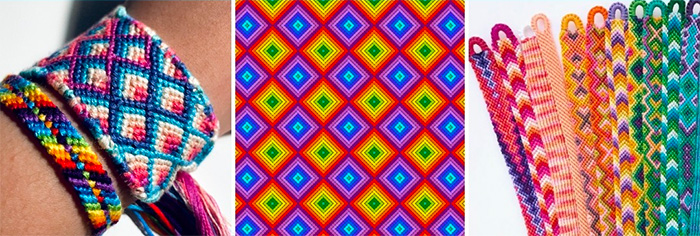
Speaker: Somayeh Dodge
Monday, November 6th, 2023 at 1pm PDT Room 1605 Elings Hall and via Zoom.
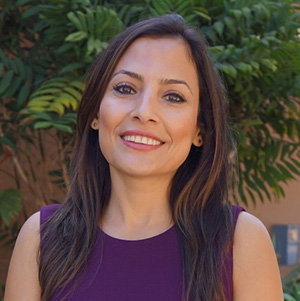
Abstract
Visualization is a key element in data-driven knowledge discovery and computational movement analysis. With the widespread increase in the availability and quality of space-time data capturing movement trajectories of individuals, meaningful representations and visualization techniques are needed to map and communicate movement patterns captured in the data. Proper representation of movement patterns and their dependencies grounded on cartographic principles and intuitive visual forms can facilitate scientific discovery, decision-making, collaborations, and foster understanding of movement. Using several use cases, this presentation discusses different approaches to mapping movement in static and dynamic displays to support knowledge discovery from human and animal movement data. I will also demo DynamoVis, an open-source software developed in Java and Processing to design, record and export custom animations and multivariate visualizations from movement data, enabling visual exploration and communication of animal movement patterns.
Bio
Somayeh Dodge is an Associate Professor of Spatial Data Science in the UCSB Department of Geography. She received her PhD in Geography with a specialization in Geographic Information Science from the University of Zurich in 2011. She is a recipient of the 2021 NSF CAREER award, and the 2022 Emerging Scholar Award from the Spatial Analysis and Modeling Specialty Group of the American Associations of Geographers. Her research focuses on developing data analytics, knowledge discovery, modeling, and visualization techniques to study movement in human and ecological systems. Somayeh is the Co-Editor in Chief of the Journal of Spatial Information Science, and a member of the editorial boards of multiple journals, including Geographical Analysis, and Cartography and Geographic Information Science, and the Journal of Geographical Systems.
For more information about the MAT Seminar Series, go to: seminar.mat.ucsb.edu.
For previous seminars, please visit our MAT Seminars Video Archive.
Thursday, November 2, 2023 from 6-10pm.
The University of California, Santa Barbara's Media Arts and Technology (MAT) program is a unique graduate program that combines computer science, engineering, digital art research, electronic music, and emerging media. On November 2nd, MAT will showcase its students' cutting-edge research and new media artworks at the Santa Barbara Center for Art, Science, and Technology (SBCAST).
Location: 513 Garden St, Santa Barbara
Date: Thursday, November 2, 2023
6-10pm
Participating Artists:
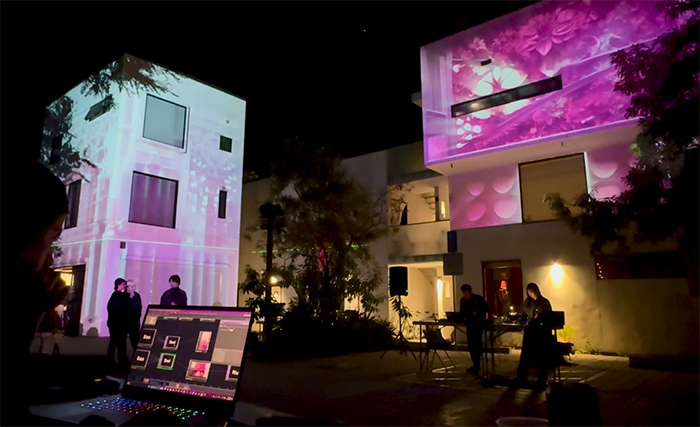
Speaker: Lev Manovich
Monday, October 30th, 2023 at 1pm PDT via Zoom.
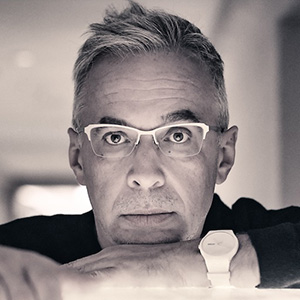
Dr. Lev Manovich is a Presidential Professor at The Graduate Center, City University of New York, and the founder and director of the Cultural Analytics Lab. In 2013 Manovich appeared in the List of 25 People Shaping the Future of Design (Complex). In 2014 he was included in the list of 50 most interesting people building the future (The Verge).
Manovich played a key role in creating four new research fields: new media studies (1991-), software studies (2001-), cultural analytics (2007-) and AI aesthetics (2018-). He is the author and editor of 15 books including Artificial Aesthetics (2022), Cultural Analytics (2020), AI Aesthetics (2018), Theories of Software Culture (2017), Instagram and Contemporary Image (2017), Software Takes Command, (Bloomsbury Academic, 2013), Black Box - White Cube (Merve Verlag Berlin, 2005), Soft Cinema (The MIT Press, 2005), The Language of New Media (The MIT Press, 2001), Metamediji (Belgrade, 2001), Tekstura: Russian Essays on Visual Culture (Chicago University Press, 1993) as well as 180 articles which have been published in 35 countries and reprinted around 700 times. He is also one of the editors of Quantitative Methods in Humanities and Social Science book series (Springer).
The Language of New Media is translated into 14 languages and is used a textbook in tens of thousands of programs around the world. According to the reviewers, this book offers "the first rigorous and far-reaching theorization of the subject"; "it places [new media] within the most suggestive and broad-ranging media history since Marshall McLuhan."
Manovich was born in Moscow where he studied fine arts, architecture, and computer programming. He moved to New York in 1981, receiving an M.A. in Visual Science and Cognitive Psychology (NYU, 1988) and a Ph.D. in Visual and Cultural Studies from the University of Rochester (1993). Manovich has been working with computer media as an artist, computer animator, designer, and developer since 1984.
His digital art projects were shown in 120 group and 12 personal exhibitions worldwide. The lab’s projects were commissioned by MoMA, New Public Library, and Google. "Selfiecity" won Golden Award in Best Visualization Project category in the global competition in 2014; "On Broadway" received Silver Award in the same category in 2015. The venues that showed his work include New York Public Library (NYPL), Google's Zeitgeist 2014, Shanghai Art and Architecture Biennale, Chelsea Art Museum (New York), ZKM (Karlsruhe, Germany), The Walker Art Center (Minneapolis, US), KIASMA (Helsinki, Finland), Centre Pompidou (Paris, France), ICA (London, UK), and Graphic Design Museum (Breda, The Netherlands).
In 2007 Manovich founded Software Studies Initiative (renamed Cultural Analytics Lab in 2016.) The lab pioneered computational analysis and visualization of massive cultural visual datasets in the humanities. The lab's collaborators included the Museum of Modern Art in NYC, Getty Research Institute, Austrian Film Museum, Netherlands Institute for Sound and Image, and other institutions that are interested in using its methods and software with their media collections. Since 2012 and 2016, Manovich directed a number of projects that present an analysis of 16 million Instagram images shared worldwide.
He received grants and fellowships from Guggenheim Foundation, Andrew Mellon Foundation, US National Science Foundation, US National Endowment for the Arts (NEH), Twitter, and many other agencies.
Between 1996 and 2012, Manovich was a Professor in Visual Arts Department at University of California San Diego (UCSD) where he was teaching classes in digital art, new media theory, and digital humanities. In addition, Manovich was a visiting professor at California Institute of the Arts, The Southern California Institute of Architecture (SCI-Arc), University of California Los Angeles (UCLA), University of Amsterdam, Stockholm University, University of Art and Design in Helsinki, Hong Kong Art Center, University of Siegen, Gothenburg School of Art, Goldsmiths College at the University of London, De Montfort University in Leicester, the University of New South Wales in Sydney, The University of Tyumen, Tel Aviv University and Central Academy of Fine Arts (CAFA) in Shanghai. Between 2009 and 2017, he was a faculty at European Graduate School (EGS). He was also the core faculty member at The Strelka Institute for Media, Architecture, and Design, Moscow (2016-2019) and a visiting faculty in School of Cultural Studies and Philosophy, Higher School of Economics, (Moscow, Russia (2020 - 2021).
Manovich is in demand to lecture on his research topics around the world. Since 1999 he presented over 750 invited lectures, keynotes, seminars, and master classes in North and South America, Asia, and Europe.
Topical writings: manovich.net
For more information about the MAT Seminar Series, go to: seminar.mat.ucsb.edu.
For previous seminars, please visit our MAT Seminars Video Archive.
Speaker: Aaron Hertzmann
Monday, October 23rd, 2023 at 1pm PDT. Room 1605 Elings Hall and via Zoom.
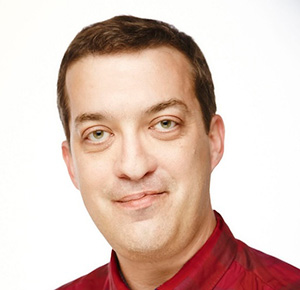
Aaron Hertzmann is a Principal Scientist at Adobe, and Affiliate Faculty at University of Washington. He received a BA in computer science and art/art history from Rice University in 1996, and a PhD in computer science from New York University in 2001. He was a Professor at University of Toronto for 10 years, and has also worked at Pixar Animation Studios and Microsoft Research. He has published over 100 papers in computer graphics, computer vision, machine learning, robotics, human-computer interaction, visual perception, and art. He is an ACM Fellow and an IEEE Fellow.
research.adobe.com/person/aaron-hertzmann
For more information about the MAT Seminar Series, go to: seminar.mat.ucsb.edu.
For previous seminars, please visit our MAT Seminars Video Archive.
Thursday, October 19th, 2023 at 5pm. Room 387-1015.
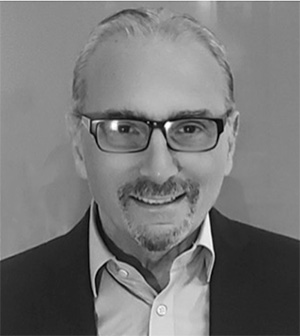
Abstract
Models for the interaction of the player with the instrument are fundamental to the accurate synthesis of sound based on physically inspired models. Depending on the musical instrument, the palette of possible interactions is generally very broad and includes the coupling of body parts, mechanical objects and/or devices with various components of the instrument. In this talk we focus on the interaction of the player with strings, whose simulation requires accurate models of the fingers, dynamic models of the bow, of the plectrum and of the friction of objects such as bottle necks. We also consider collisions and imperfect pressure on the fingerboard as important side effects and playing styles. Our models do not depend on the specific numerical implementation but are simply illustrated in the digital waveguide scheme.
Gianpaolo Evangelista is professor of Music Informatics at the University of Music and Performing Arts Vienna, Austria. Previously he was professor of Sound Technology at Linköping University, Sweden, researcher and assistant professor at the University “Federico II” of Naples, Italy and adjunct professor at the Polytechnic of Lausanne (EPFL), Switzerland. He received the Laurea in Physics from the University “Federico II” of Naples and the Master and PhD in Electrical and Computing Engineering from the University of California Irvine. He has collaborated with several musicians among including Iannis Xenakis (Paris) and Curtis Roads. His interests are in all applications of Signal Processing, Physics and Mathematics to Sound and Music, particularly for the analysis, synthesis, special effects and the separation of sound sources.
Speaker: Lydia Zimmermann
Monday, October 16th, 2023 at 1pm PDT via Zoom.
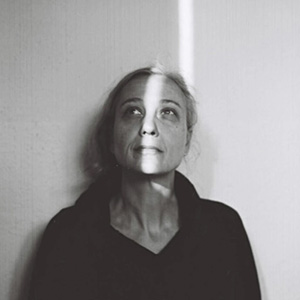
Bio
Lydia Zimmermann (Barcelona, 1966) has written and directed fiction films, TV movies, documentaries, video art and produced filmic installations. She has taught filmmaking at universities and NGOs. She has filmed in Spain, Australia, Mexico, Haiti, Burkina Faso and Colombia, combining humanitarian and teaching work. She has participated in the creation of Cine Institute, a school for young Haitian filmmakers (2011-2015), taught workshops at the Gambidi acting school in Ouagadougou, Burkina Faso (2017-2018), and supported the creation of the indigenous media collective Ñambi Rimai (2018-201).
In her filmography, she explores the hybrid combination of genres and acting naturalism. She currently lives between Zurich and Barcelona and is writing her next fiction film, a co-production between Eddie Saeta (SP) and Tilt Production (CH).
For more information about the MAT Seminar Series, go to: seminar.mat.ucsb.edu.
For previous seminars, please visit our MAT Seminars Video Archive.
Speaker: Garnet Hertz
Monday, October 9th, 2023 at 1pm PDT.
Room 1605 Elings Hall and via Zoom.
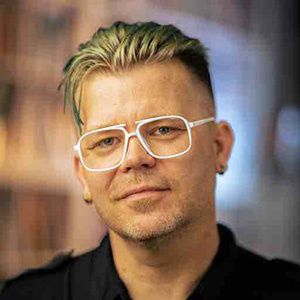
Abstract
Author of "Art + DIY Electronics" (MIT Press, 2023). A systematic theory of DIY electronic culture, drawn from a century of artists who have independently built creative technologies.
Since the rise of Arduino and 3D printing in the mid-2000s, do-it-yourself approaches to the creative exploration of technology have surged in popularity. But the maker movement is not new: it is a historically significant practice in contemporary art and design. This book documents, tracks, and identifies a hundred years of innovative DIY technology practices, illustrating how the maker movement is a continuation of a long-standing creative electronic subculture. Through this comprehensive exploration, Garnet Hertz develops a theory and language of creative DIY electronics, drawing from diverse examples of contemporary art, including work from renowned electronic artists such as Nam June Paik and such art collectives as Survival Research Laboratories and the Barbie Liberation Organization.
Hertz uncovers the defining elements of electronic DIY culture, which often works with limited resources to bring new life to obsolete objects while engaging in a critical dialogue with consumer capitalism. Whether hacking blackboxed technologies or deploying culture jamming techniques to critique commercial labor practices or gender norms, the artists have found creative ways to make personal and political statements through creative technologies. The wide range of innovative works and practices profiled in Art + DIY Electronics form a general framework for DIY culture and help inspire readers to get creative with their own adaptations, fabrications, and reimaginations of everyday technologies.
Bio
Garnet Hertz is Canada Research Chair in Design and Media Arts, and is Associate Professor of Design at Emily Carr University. His art and research investigates DIY culture, electronic art and critical design practices. He has exhibited in 18 countries in venues including SIGGRAPH, Ars Electronica, and DEAF and has won top international awards for his work, including the Oscar Signorini Award in robotic art, a Fulbright award, and Best Paper Award at the ACM Conference on Human Factors in Computing Systems (CHI). He has worked as Faculty at Art Center College of Design and as Research Scientist at the University of California Irvine. His research is widely cited in academic publications, and popular press on his work has disseminated through 25 countries including in publications like The New York Times, Wired, The Washington Post, NPR, USA Today, NBC, CBS, TV Tokyo and CNN Headline News.
For more information about the MAT Seminar Series, go to: seminar.mat.ucsb.edu.
For previous seminars, please visit our MAT Seminars Video Archive.
Suleyman will also give a lecture for the UCSB Arts and Lectures series in Campbell Hall on October 5th, 2023 at 7:30pm.
artsandlectures.ucsb.edu/events-tickets/events/23-24/mustafa-suleyman
Mustafa Suleyman CBE is a British artificial intelligence researcher and entrepreneur who is the co-founder and former head of applied AI at DeepMind, an artificial intelligence company acquired by Google and now owned by Alphabet. He is currently the CEO of Inflection AI, and author of the book "The Coming Wave: Technology, Power, and the 21st Century's Greatest Dilemma."
Suleyman recently was recently interviewed on MSNBC, and discussed the future of AI and it's impact on humanity.
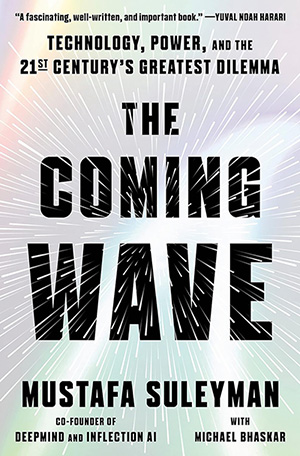
Speaker: Michael Candy
Monday, October 2nd, 2023 at 1pm PDT.
Room 1605 Elings Hall and via Zoom.
Bio
Michael Candy is an artist whose work reflects the socio-political currents of contemporary technologies. Acting as a witness to the nature of cybernetics and digital culture, Candy positions the viewer in a physical and moral confrontation with issues challenging post-industrial society.
His installations, sculpture, and video works often emerge as social experiments or ecological interventions in public space. This didactic practice is fuelled by the accelerated development of emerging technologies, creating work in immediate dialogue with new systems, theories, hardware and software.
Candy has been involved in many international exhibitions and residencies, notably: Water, (GOMA, Brisbane), Adelaide Biennial of Australian Art, (AGSA, Adelaide), Ars Electronica Festival, (Linz, Austria), The Kathmandu Triennale (Kathmandu, Nepal), The Forum of Sensory Motion (Athens, Greece), The Instrument Builders Project + Hackteria Lab (Yogyakarta, Indonesia), and Hawapi (Huepetuhe, Peru).
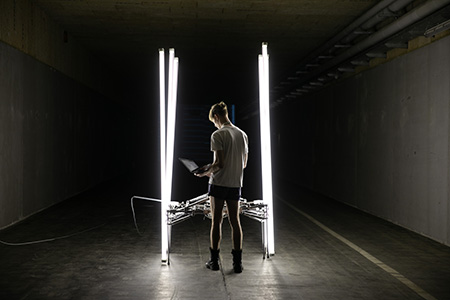
For more information about the MAT Seminar Series, go to: seminar.mat.ucsb.edu.
For previous seminars, please visit our MAT Seminars Video Archive.
Thursday, September 21st, 2023
1pm PDT
transLAB (Room 2615, Elings Hall) and via Zoom
Abstract
This master's project thesis delves into the dynamic intersection of human sensory perception, computational media, environmental design, and emerging technologies. Within this comprehensive inquiry, my contributions span several interconnected team projects. Notably, 'Hydnum' delves into the synthesis of olfactory stimuli and emotional states within the immersive realm of extended reality. 'Echoes' explores the enigmatic liminal space between perception and meaning, while 'Synaptic Time Tunnel' pays tribute to the evolutionary trajectory of computer graphics by delving into synaptic interconnections.
As my exploration unfolded, it became evident that each project built upon the lessons of the previous one, progressing from 'Hydnum,' a low-level interactive network translated into tangible forms, to 'Echoes,' an intermediate project that translates networks into both tangible artifacts and virtual environments with medium interactivity, and ultimately to 'Synaptic Time Tunnel,' where the focus shifts to a fully immersive virtual network experience with high-level interactivity.
These pivotal projects stand as the embodiment of my extensive explorations within the realm of worldmaking in Extended Reality (XR), the expressions of transmodal data in various formats, and the intricate nuances of interaction design. To delve into specifics, in Hydnum, my primary contribution revolves around the procedural design of physical and digital structures that emerge from biodata, with a particular emphasis on the role of olfactory stimuli in shaping spatial presence. In ‘Echoes’, my central involvement centers on the translation of biodata into an olfactory glass artifact. Lastly, in the case of ‘Synaptic Time Tunnel’, my contribution takes the form of an immersive interconnected system, serving as an expressive medium that bridges the gap between data and interaction.
In essence, the unwavering goal is to create innovative, immersive experiences that connect users with the natural world and explore its intricate traces, guided by the profound principles of morphology and cognition.
Wednesday September 20th, 2023
3pm PDT
Experimental Visualization lab (Room 2611, Elings Hall) and via Zoom
Abstract
In affective computing, there exist various interactive systems allowing users to easily express their emotion by adapting in real time to reflect the perceived emotional state of the viewer. For instance, “empathic painting” created by Maria Shugrina is a painter-rendering system that automatically creates digital paintings with parameterized painting features. The system can estimate the viewer’s purposefully displayed emotional state through facial expression recognition. However, almost no attempt has been made to provide materials for a painting application to allow users to easily express their emotions in their works. As artists use formal elements such as forms and colors to express desired emotions, we need tools that help the users to add emotional conditions for these elements while creating paintings.
Through the introduction of emotion-based brushes, the following research question was explored: how do we incorporate emotions into drawing/painting tools and enable users to control expression through the use of these tools? Especially since an immersive virtual reality (VR) environment is more effective in producing emotions than less-immersive displays, the application has been designed in the immersive VR environment. This dissertation examines how the incorporation of emotions into a VR painting application with a provided range of formal elements affects awareness and expression of human emotions and presents two contributions: design of prototype drawing/painting applications for incorporating emotion with an interactional approach, and an analysis of user evaluation results.
Monday, August 14th, 2023
1pm PDT via Zoom
Abstract
The rapid development of the current availability of advanced hardware and software is opening up new opportunities for digital creation every day. This circumstance provides great freedom for new artistic expressions with advanced audio, graphics, interface, and algorithms including machine learning. However, while our nature is multimodal, these modalities in the digital domain are genuinely separate, and the computational platform allows innumerable varieties of linkages among them. For this reason, the holistic multimodal experience is highly dependent on the design and connection of different modalities. This dissertation desires to explain the properties of coherent digital multimodal instruments and discuss their creative opportunity from the aspect of the process of music composition and performance. The chapters introduce the related projects with their design process demonstrating the role of crossmodal correspondence in scientific simulation and propose a numerical method to evaluate the crossmodal correspondences using the correlation coefficient between the modalities. This dissertation aims to contribute to reorganizing the design process of multimodal instruments beyond the old and recent customs.
Monday June 26th, 2023 at 3pm PDT.
In-person location TBD and via Zoom.
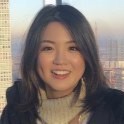
Abstract
Future haptic augmented reality systems could transform our interactions within many environments by furnishing haptic feedback that augments touch interactions with physical objects. However, most prior haptic technologies involve controllers, wearables, or devices that either impede free-hand interactions or make it impossible to directly touch physical objects with the skin. This Ph.D. presents several haptic design approaches and findings that can overcome these limitations, and that provide new methods for augmenting free-hand interactions with physical objects. The first part of the Ph.D. presents a new haptic augmented reality system for the hand. It introduces Tactile Echoes, a finger-wearable system that provides responsive haptic feedback that augments touch interactions with physical surfaces. It renders these effects by capturing touch-elicited vibrations in the skin and processing them in real time in order to enliven tactile experiences. Using computational and spatial tracking techniques, different haptic effects may be spatially painted onto different objects or surfaces. This chapter presents experiments characterizing how these novel haptic effects are perceived, demonstrations of several applications, and a user study showing how they can enhance augmented or mixed reality applications.
The second part of this Ph.D. was motivated by observations obtained using Tactile Echoes that indicate that the perceived strength of haptic feedback increases when it is supplied tens of milliseconds after a touch event. This observation is consistent with findings from prior perception research on tactile forward masking. However, prior studies of forward masking have been confined to passive conditions rather than active touch, as occurs in Tactile Echoes. This chapter presents research revealing prominent modulatory effects of the timing, amplitude, and perceptual similarity between the feedback and the transient skin oscillations elicited via touch contact. Forward masking produced a greater attenuation of the perceived intensity of feedback as delay time decreased, with the maximum attenuation reaching nearly 10 dB. These findings shed light on the interplay between perception and action in the haptic system and have important implications for the design of haptic interfaces.
The third part of this Ph.D. presents another method for augmenting touch interactions that exploit mechanical wave propagation in the skin. This method, called Beatactile, involves supplying vibrations on the finger and on the surface with slightly different frequencies. When a surface is touched, the two vibration sources interfere, producing beat frequencies between vibrations in the finger that cause a flat surface to feel coarsely textured. The BeaTactile hardware and software system enables parametric control over these novel effects.
The final part of this Ph.D. concerns thermal augmentations of touch interactions, based on the thermal grill illusion. It presents a newly developed thermal grill haptic interface that exploits juxtaposed warm and cool areas to render surprisingly intense thermal sensations. The results revealed perceived intensity to increase, and response time to decrease, monotonically with temperature differences. An augmented reality demonstration highlights potential applications of this technique haptic design and engineering. This research contributes to knowledge about thermal perception and suggests new design approaches for thermal interfaces.
Thursday, June 15, 2023, 2-4pm PDT.
MAT Conference Room, Elings Hall, room 2003 and via Zoom.
Abstract
Since the beginning of 2022 I have developed four audio plugins using the C++ framework JUCE. In doing so, I accumulated various strategies for enhancing the dependability and efficiency of my programs; for example, I learned to avoid memory allocation in the audio thread, refuse third party libraries, and refrain from invoking system calls. However, I also discovered specific circumstances where each of these principles was no longer desirable. Rather than relying on rules of thumb and general guidelines, I sought to develop a set of first principles for developing production-level audio software.
I argue that many good audio programming practices can be derived from the following fact: audio plugins are multi-threaded programs subject to a firm real-time constraint. With this framing in mind, I present The Template Plugin: a starting point for new plugin projects that integrates the best practices and creative solutions I have implemented in my own work. I justify the design of The Template Plugin by discussing effective strategies for thread synchronization, optimization, program state management, user interfaces, and build systems within the context of multi-threaded and real-time applications.
Thursday, June 15, 2023, 10:30am - 12pm PDT
Experimental Visualization Lab (Room 2611, Elings Hall) and via Zoom.
Abstract
Throughout the past year, the public has witnessed a multitude of high-performance text-to-image Generative AI models pushing the boundaries of image synthesis. These advancements have reshaped the art domain and sparked a great debate surrounding the role of artists and the nature of creativity in artwork created with Image Generative AI. This master's project aims to analyze artists' roles and their relationship with machines when creating artwork with Image Generative AI. Drawing inspiration from Rhodes' 4P model of creativity, an analytical framework of 5P+E (Purpose, People, Process, Product, Press, and Evaluation) has been developed to compare the art-creating processes of Conceptual Art and Image Generative AI. To exemplify this framework, a practical case study titled "Equivalence" has been conducted. Equivalence is a multi-screen interactive installation that converts users' speech input into continuously evolving paintings constructed with Natural Language Processing Algorithms and Stable Diffusion Model. Instead of just using users' text prompts, this installation analyzes the emotion, grammar structure, and word choice, converting this information into architectural structures to investigate the relationship between language and image. Through comprehensive analysis and the execution of the case study, this master's project aims to broaden the understanding of artists' roles and foster a deeper appreciation for the creative aspects inherent in artwork created with Image Generative AI.
Wednesday, June 14th, 2023, 3pm PDT.
MAT Conference Room, Elings Hall, room 2003.
Abstract
Music technology has opened up possibilities for highly sophisticated sound design and composition. Composers are able to build temporally dense and sonically eclectic phrases that are not feasible for humans to play in real time. How do we blend the world of offline, complex composition and performance? I look towards the paradigm of a DJ, where one becomes an expert at taking composed, static (typically grid-based) music and recontextualizing it in a live setting via chopping, filtering, remixing, etc. This idea can be taken a step further through deconstructing composed music via granulation. My contribution is the GDJ (Granular DJ); a granular synthesis tool with guard rails to keep sonic output on tempo, allowing for the liquid sound design associated with granulation while constraining it to a grid used in popular songwriting and dance music. The GDJ leverages the granular tool kit to completely transform source material, while also using systems of staying in time and key, as seen in DJ workflows, to keep the tool constrained enough for solo or multi-performer contexts. GDJ is written in Max/MSP and is currently being used in a live performance system with the author and friend.
Speaker: Meredith Sattler
Monday, June 5th, 2023 at 1pm PDT via Zoom.
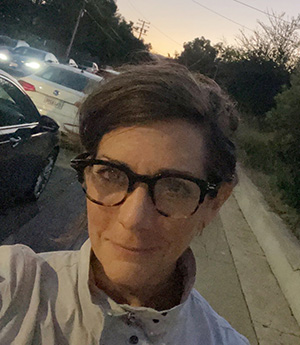
Abstract
Systems diagrams are powerful tools that may be employed in a multitude of ways to understand and actualize complex phenomena. But like their cousins, algorithms, their scripts contain concealed biases, often in the form of feedback loop logics that can evolve into circumstances and/or entities that catch their authors off guard. This research examines how the “Economic System of B2” diagram translated the Biospherians’ rarefied synthetic environmental epistemology into a mini-Anthropocene ontology, acted as a ‘Rosetta Stone’ that facilitated interdisciplinary and quantitative design processes, produced the tightest building envelope ever constructed at its scale, and ultimately scripted the life-support generating performances of the crews inside Biosphere 2’s [B2] enclosure missions. It draws parallels between the Biospherians’ “Human Experiment” design approaches, heavily informed by their training as environmental managers, explorers, and Thespians, and their performances within B2, which increasingly manifest through tensions between the technocratic tendencies of their ‘scripted’ and ‘rehearsed’ biogeochemical molecular economy, and the emergent circumstances that necessitated their ‘off-script’ ‘improvisations.’ Ultimately, I argue that Art, Engineering, and Life reconfigured within B2 in surprising ways, which may reveal and forecast our own performances within the increasingly circular and accelerating evolution of the Anthropocene.
Bio
Meredith Sattler is currently an Assistant Professor of Architecture at Cal Poly San Luis Obispo, a PhD candidate in Science and Technology Studies at Virginia Tech, and a LEED BD+C. Her current research and teaching interests include conceptualizations of dynamic sustainable architectural systems in historic and current contexts; interdisciplinary structure and practice within functional territories between design and the ecological sciences; and the designer’s influence on the health of natural environment-technology-human interactions. She is founder and lead designer of cambioform, a furniture and environmental design studio, received the Ellen Battel Stoeckel Fellowship at the Norfolk Yale Summer School of Art, and has exhibited and published internationally. She holds Masters of Architecture and Masters of Environmental Management degrees from Yale University, and a Bachelor of Arts from Vassar College.
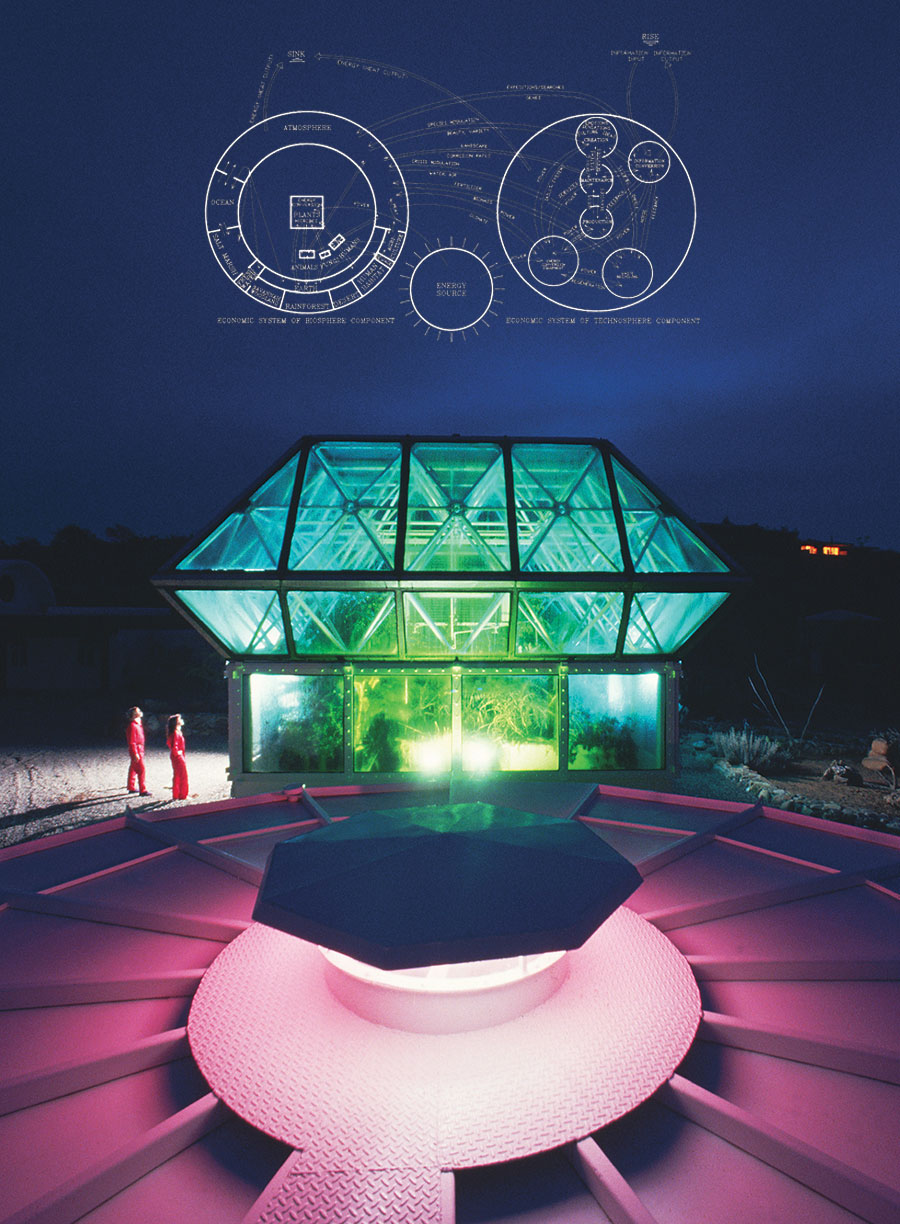
For more information about the MAT Seminar Series, go to: seminar.mat.ucsb.edu.
For previous seminars, please visit our MAT Seminars Video Archive.
Wednesday, May 31st, 2023
10:30am PDT via Zoom
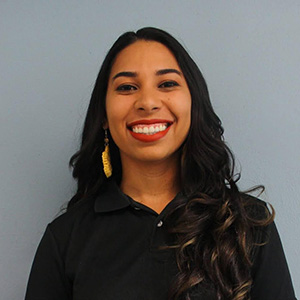
Abstract
New printing strategies have enabled 3D-printed materials that imitate traditional textiles. These filament-based textiles are easy to fabricate but lack the look and feel of fiber textiles. I seek to augment 3D-printed textiles with needlecraft to produce composite materials that integrate the programmability of additive fabrication with the richness of traditional textile craft. I present PunchPrint: a technique for integrating fiber and filament in a textile by combining punch needle embroidery and 3D printing. Using a toolpath that imitates textile weave structure, we print a flexible fabric that provides a substrate for punch needle production. I integrate our technique into a parametric design tool and produce functional artifacts that show how PunchPrint broadens punch needle craft by reducing labor in small, detailed artifacts, enabling the integration of openings and multiple yarn weights, and scaffolding soft 3D structures.
Wednesday, May 31, 2023
6pm in the UCSB AlloSphere Research Facility
This thirteen-minute digital surround-sound performance composed by James A. Moorer, a renowned composer, former Vice President of research and development at Lucasfilms Droid works and Academy of Motion Pictures Arts and Science Award winner. The librettist of this production, Donna Decker, is the gifted writer of the sound poem Man in the Mangroves. The producer of this production, Ralph Guggenheim, has decades of experience in the entertainment industry, and is the founder of PIXAR.
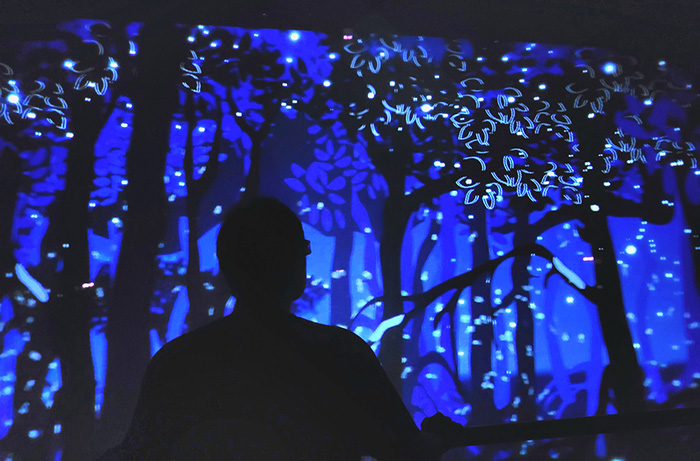
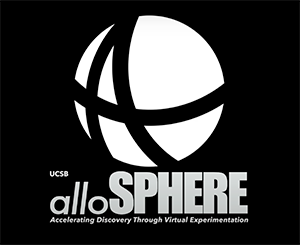
Speaker: Emily White
Monday, May 22nd, 2023 at 1pm PDT via Zoom.
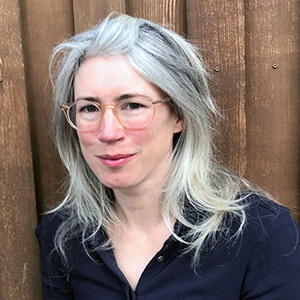
Abstract
Some contemporary thinkers argue that the image is supplanting the drawing as the currency of contemporary architectural practice. This is not just a theoretical position; as we are all well aware, it is possible to envision, detail, and build buildings from information extracted from digital models presented as pictures on a computer screen. But even as an architecture of digital objects and images is increasingly possible, there has been a recent resurgence of enthusiasm for drawing, and specifically for techniques of projection, in late 20th century and contemporary discourse. This talk is about drawing practices and how real and imagined material characteristics continue to inform architectural work- drawn, built, and modeled.
Bio
Emily White is an artist and architect who works with materials ranging from foam to inflatables to sheet metal. She has exhibited at the J. Paul Getty Museum, the Museum of Contemporary Art Los Angeles, and Materials & Applications and has a permanent project installed in the Fort Lauderdale International Airport. She teaches design studios in Architecture at Cal Poly, San Luis Obispo. She has a MARCH from the Southern California Institute of Architecture (SCI-Arc) and a BA from Barnard College, Columbia University.
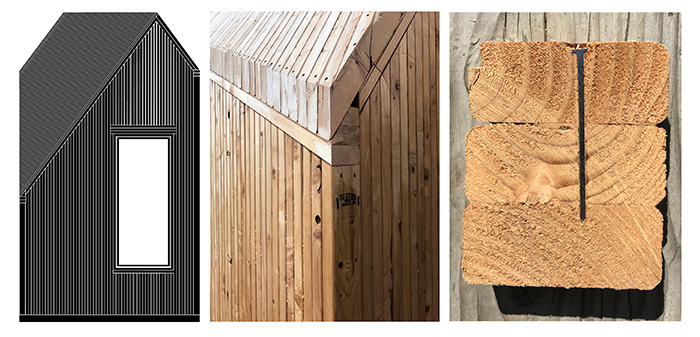
For more information about the MAT Seminar Series, go to: seminar.mat.ucsb.edu.
For previous seminars, please visit our MAT Seminars Video Archive.
Speaker: George Legrady
Monday, May 15th, 2023 at 1pm PDT via Zoom.
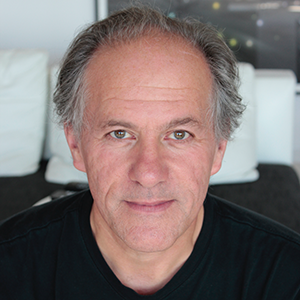
Abstract
This presentation will report on a selection of projects realized in a class exploring generative AI image synthesis in the fall of 2022 as softwares such as Dalle-2, MidJourney, and Stable Diffusion began to circulate within the image-making communities. The presentation will introduce the concept of the course, and follow with student work.
Bio
George Legrady is Distinguished Professor in the Media Arts & Technology PhD program at UC Santa Barbara where he directs the Experimental Visualization Lab. His research, pedagogy and artistic practice address the impact of computation on the veracity of data, specifically the photographic image. A pioneer in the field of digital media arts with an emphasis on digital photography, data visualization, interactive installation, machine-learning and natural language processing, his projects and research have been presented internationally in fine art digital media arts installations, engineering conferences and public commissions.
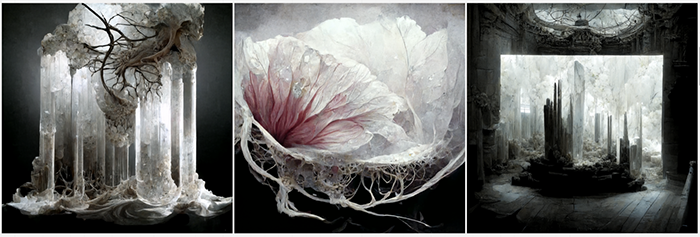
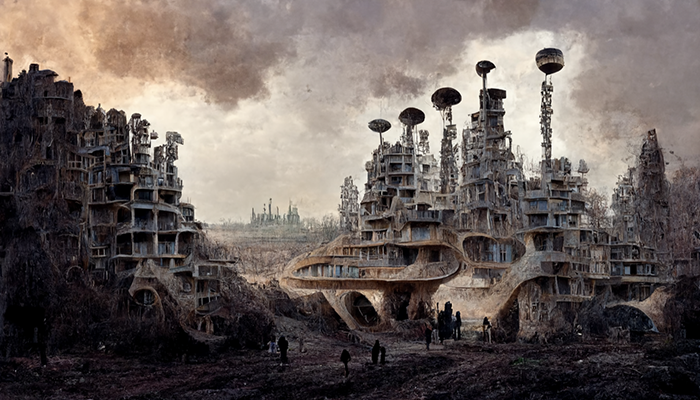
For more information about the MAT Seminar Series, go to: seminar.mat.ucsb.edu.
For previous seminars, please visit our MAT Seminars Video Archive.
Speaker: Rebecca Ruige Xu
Monday, May 8th, 2023 at 1pm PDT via Zoom.
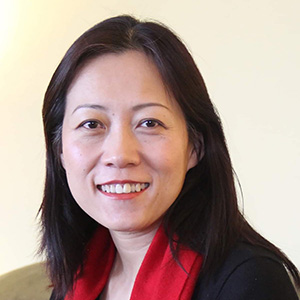
Abstract
The sublime, a long-sought artistic ideal, embodies grandeur that inspires awe and evokes deep emotional or intellectual responses. How do artists today employ data as a primary material to achieve this elusive quality while creating work that is both enigmatic and captivating? Additionally, how can they craft art experiences that resonate with audiences? By discussing a few of her recent projects, Rebecca Xu shares her exploration and insights on this subject, shedding light on how data-driven art pieces challenge traditional conventions of artistic expression and reshape the quest of the sublime in our digital era.
Bio
Rebecca Ruige Xu teaches computer art as a Professor in the College of Visual and Performing Arts at Syracuse University. Her research interests include artistic data visualization, experimental animation, visual music, interactive installations, digital performance, and virtual reality. Xu’s work has appeared at many international venues, including IEEE VIS Arts Program; SIGGRAPH & SIGGRAPH Asia Art Gallery; ISEA; Ars Electronica; Museum of Contemporary Art, Italy; Los Angeles Center for Digital Art, etc. Xu is the co-founder of China VIS Arts Program. Currently, she serves as the Chair of ACM SIGGRAPH Digital Arts Committee and IEEE VIS’23 Arts Program Co-Chair.
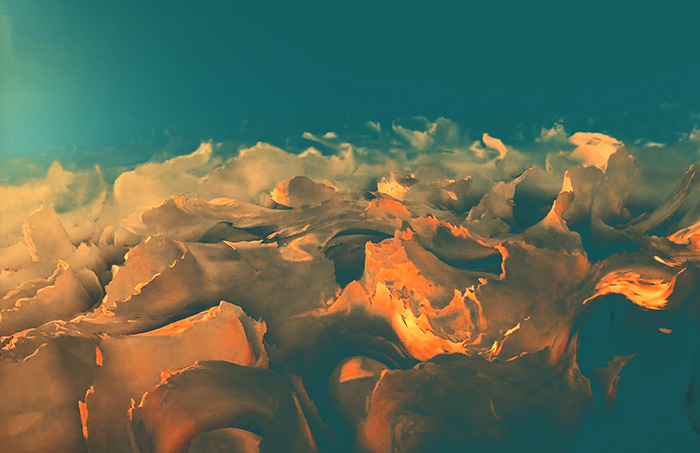
For more information about the MAT Seminar Series, go to: seminar.mat.ucsb.edu.
For previous seminars, please visit our MAT Seminars Video Archive.
Speaker: Robert Twomey
Monday, May 1st, 2023 at 1pm PDT via Zoom.
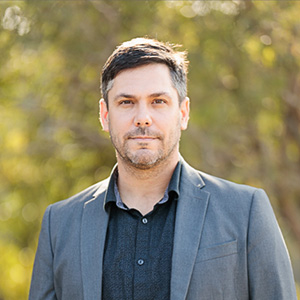
Abstract
Recent advances in generative and perceptive AI have radically expanded the breadth, scope, and sophistication of human-machine interactions. Whether through creative co-production, confessional communion, or quantified selves under machine observation—we have invited ML systems to participate in our innermost spaces. In this talk I discuss my research into machine cohabitation, exploring the ways that we share space with these technological others. Spanning smart environments, robotic automation, data science, and real-time performance, my projects explore emergent technological possibilities while centering human dynamics of the interactions. Are these acts of high tech ventriloquism, psychological self-stimulation, mediumistic extensions of a creative unconscious, or collaborations with computational others? However we decide these questions of autonomy and agency, the value of these systems lie in what they reveal about human imagination and desire.
Bio
Robert Twomey is an artist and engineer exploring the complex ways we live, work, and learn with machines. Particularly, how emerging technologies impact sites of intimate life: what relationships we engender with machines, what data and algorithms drive these interactions, and how we can foster a critical orientation in developing these possibilities. He addresses these questions through the Machine Cohabitation Lab (cohab-lab.net), as an Assistant Professor at the Johnny Carson Center for Emerging Media Arts, University of Nebraska-Lincoln.
Twomey has presented his work at SIGGRAPH (Best Paper Award), CVPR, ISEA, NeurIPS, the Museum of Contemporary Art San Diego, Nokia Bell Labs Experiments in Art and Technology (E.A.T.), and has been supported by the National Science Foundation, the California Arts Council, Microsoft, Amazon, NVIDIA, and HP. He received his BS from Yale with majors in Art and Biomedical Engineering, his MFA in Visual Arts from UC San Diego, and his Ph.D. in Digital Arts and Experimental Media from the University of Washington. He is an artist in residence with the Arthur C. Clarke Center for Human Imagination at UC San Diego.
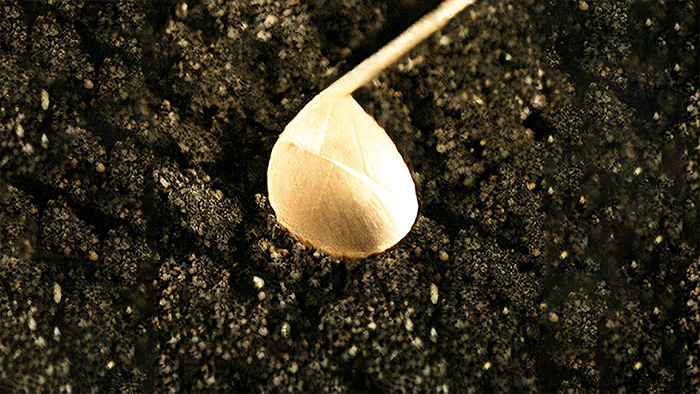
For more information about the MAT Seminar Series, go to: seminar.mat.ucsb.edu.
For previous seminars, please visit our MAT Seminars Video Archive.
Speaker: Nettie Gaskins
Monday, April 24th, 2023 at 1pm PDT via Zoom.
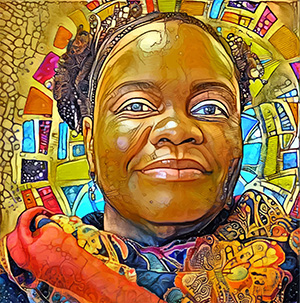
Abstract
Dr. Gaskins will discuss generative art and artificial intelligence or AI art, which are forms of art created using algorithms, mathematical equations, or computer programs to generate images, sounds, animations, or other artistic creations. Generative art can be seen as a collaboration between the artist and the machine, where the artist sets the framework, and the machine creates the artwork within those constraints.
Bio
Dr. Nettrice Gaskins earned a BFA in Computer Graphics with Honors from Pratt Institute in 1992 and an MFA in Art and Technology from the School of the Art Institute of Chicago in 1994. She received a doctorate in Digital Media from Georgia Tech in 2014. Currently, Dr. Gaskins is a 2021 Ford Global Fellow and the assistant director of the Lesley STEAM Learning Lab at Lesley University. Her first full-length book, Techno-Vernacular Creativity and Innovation is available through The MIT Press. Gaskins' AI-generated artworks can be viewed in journals, magazines, museums, and on the Web.
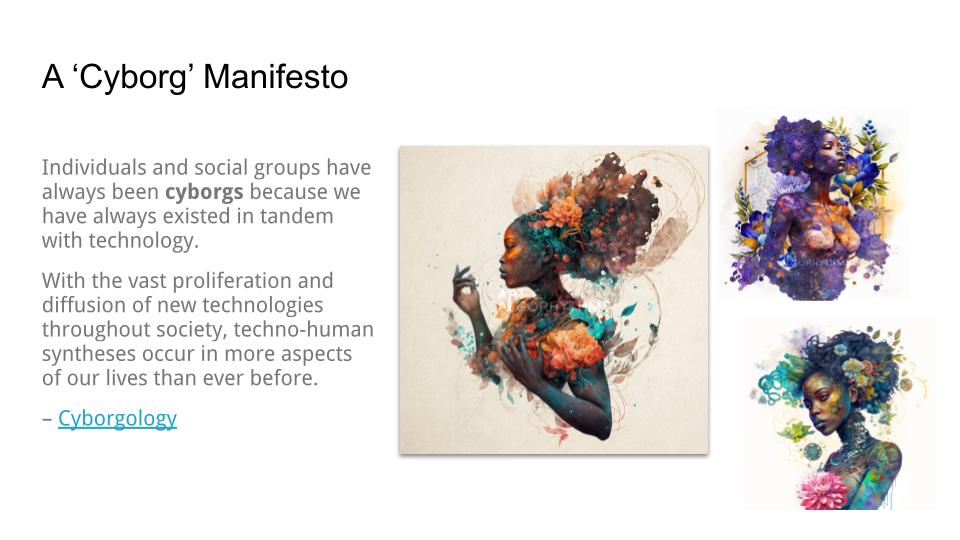
For more information about the MAT Seminar Series, go to: seminar.mat.ucsb.edu.
For previous seminars, please visit our MAT Seminars Video Archive.
Speaker: Bruce Damer
Monday, April 17th, 2023 at 1pm PDT via Zoom.
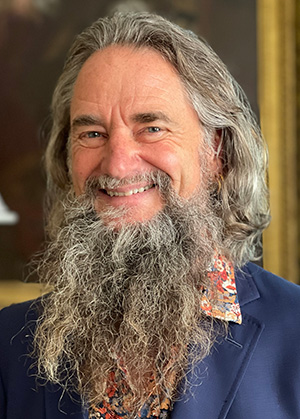
Abstract
How did life begin on the Earth approximately four billion years ago and how might it get started elsewhere in the universe? New science over the past decade suggests that life on Earth started not deep in the oceans but on land, in a 21st Century version of what Charles Darwin originally proposed: a "warm little pond." Our modern setting is a hot spring pool subject to regular cycles of wetting and drying. Feeding this pool is a mix of copious inputs of organics cooking up a proper "primordial soup" to stir populations of protocells into a living matrix of microbes. Can this scenario of our deepest ancestry inform us about the nature of life itself and provide insight into us humans, our technology and our civilizational future? This talk by Dr. Bruce Damer will take us on an end-to-end journey from the first flimsy proto-biological sphere to a possible future for the Earth's biosphere as it extends out into the cosmos.
Bio
Dr. Bruce Damer is Chief Scientist of the BIOTA Institute and a researcher in the Department of Biomolecular Engineering, UC Santa Cruz. His career spans four decades including pioneering work on early human-computer interfaces in the 1980s, virtual worlds and avatars in the 1990s, space mission design for NASA in the 2000s, and developing chemical and combinatorial scenarios for the origin of life since 2010.
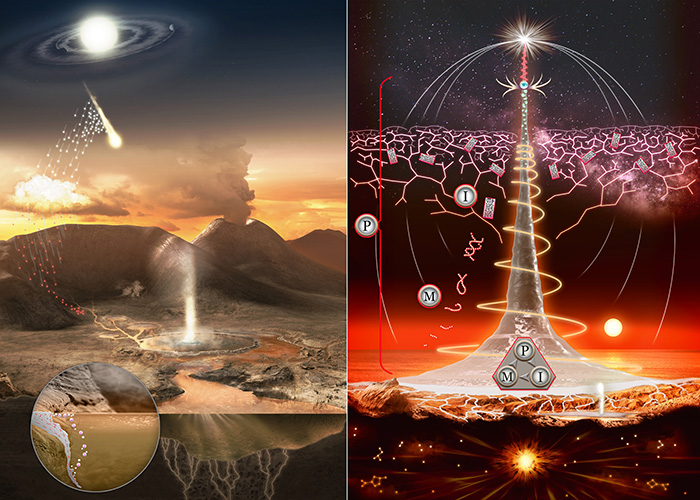
For more information about the MAT Seminar Series, go to: seminar.mat.ucsb.edu.
For previous seminars, please visit our MAT Seminars Video Archive.
Speaker: Timnit Bebru
Monday, April 10, 2023 at 1pm PDT via Zoom.
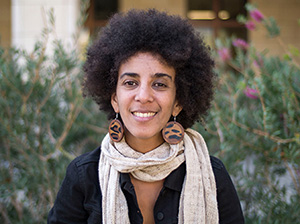
Abstract
The Distributed Artificial Intelligence Research Institute (DAIR) was launched on December 2, 2021, by Timnit Gebru as a space for independent, interdisciplinary community-rooted AI research, free from Big Tech’s pervasive influence. The institute recently celebrated its 1 year anniversary. Timnit Gebru will discuss DAIR's research philosophy consisting of the following principles: community, trust and time, knowledge production, redistribution, accountability, interrogating power, and imagination. She will discuss the incentive structures that make it difficult to perform ethical AI research and give examples of works at DAIR, hoping to forge a different path.
Bio
Timnit Gebru is the founder and executive director of the Distributed Artificial Intelligence Research Institute (DAIR). Prior to that, she was fired by Google in December 2020 for raising issues of discrimination in the workplace, where she was serving as co-lead of the Ethical AI research team. She received her PhD. from Stanford University and did a postdoc at Microsoft Research, New York City, in the FATE (Fairness Accountability Transparency and Ethics in AI) group, where she studied algorithmic bias and the ethical implications underlying projects aiming to gain insights from data.
Timnit also co-founded Black in AI, a nonprofit that works to increase the presence, inclusion, visibility and health of Black people in the field of AI, and is on the board of AddisCoder, a nonprofit dedicated to teaching algorithms and computer programming to Ethiopian high school students, free of charge.
For more information about the MAT Seminar Series, go to: seminar.mat.ucsb.edu.
For previous seminars, please visit our MAT Seminars Video Archive.
Speaker: Jakob Kudsk Steensen
Monday, April 3, 2023 at 1pm PDT via Zoom.
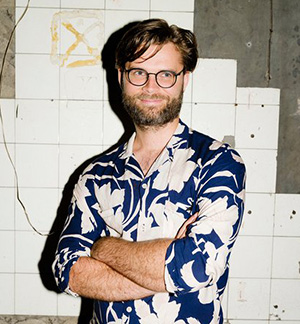
Abstract
Ecosystems are disappearing, but so are our ways of sensing, performing, singing, and expressing ourselves in relation to them. Artist Jakob Kudsk Steensen digitizes vanishing natural environments in collaboration with scientists, authors, artists, performers, and researchers as a way to rejuvenate lost sensibilities toward specific ecosystems. His artworks use advanced technology to create hyper-sensory recreations of natural environments, featuring real-time interactive technologies as a new spatial language for connecting and collaborating.
Bio
Jakob Kudsk Steensen (B. 1987, Denmark) is an artist working with environmental storytelling through 3d animation, sound and immersive installations. He creates poetic interpretations about overlooked natural phenomena through collaborations with field biologists, composers and writers. Jakob has recently exhibited with his major solo exhibition “Berl-Berl” in Berlin at Halle am Berghain, commissioned by LAS, and at Luma Arles with “Liminal Lands” for the “Prelude” exhibition. He was a finalist for the Future Generation Art Prize at the 2019 Venice Biennale. He received the Serpentine Augmented Architecture commission in 2019 to create his work The Deep Listener with Google Arts and Culture. He is the recipient of the best VR graphics for RE-ANIMATED (2019) at the Cinequest Festival for Technology and Cinema, the Prix du Jury (2019) at Les Rencontres Arles, the Webby Award - People’s Choice VR (2018), and the Games for Change Award - Most Innovative (2018), among others.
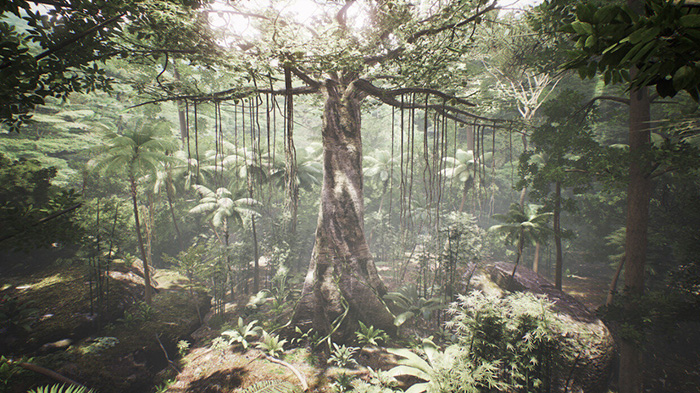
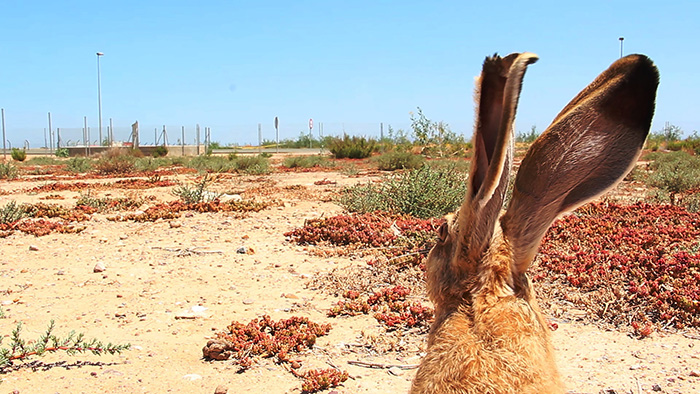
For more information about the MAT Seminar Series, go to: seminar.mat.ucsb.edu.
For previous seminars, please visit our MAT Seminars Video Archive.
Thursday, March 16th, 2023 at 1:30pm PT
transLAB (room 2615) Elings Hall
Abstract
The progress in electronic and computer sciences has transformed music, introducing new techniques and tools that have completely impacted the way we compose, perform, and distribute music. As creators and consumers, our experience with music has been shaped by these new technologies, resulting in a rapid evolution of the art form.
However, Western music theory has remained largely unchanged, with technology settling into the current system and formalizing its rules in each protocol and platform developed. Since Western music, and specifically its harmonic rules, were developed in a technological context that has since changed, it stands to reason that the theory should evolve as well. Several artists have expanded their artistic practice by exploring new systems, such as serialism, stochastic music, and microtonality. Composers such as Xenakis, Partch, Johnston, and Tenney have laid the foundation for a new computational system in music.
My goal is to organize and codify the principles and rules of harmony into a systematic and recognizable form that reflects the evolution of music and its relationship with technology. To address this issue, I propose a new theory for music harmony that offers a common mathematical formalization for harmonic structures in any tuning system. My proposal is based on the results of a music perception study that examines the relationship between mathematical structures and our perception of harmony.
Speaker: Gina Collecchia
Monday, March 13th, 2023 at 1pm PST via Zoom
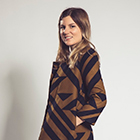
Abstract
The opportunities for machine learning to intersect with music are vast, with many ways to approach the transcription of polyphonic music. So what can—and should--artificial intelligence do with the transcription itself? In this talk, I will give a broad overview of some of the software libraries available to retrieve information from music, and we will speculate together on how machine learning might be able to aide music composition.
Bio
Gina Collecchia is an audio scientist specializing in music information retrieval, room acoustics, and spatial audio. She has worked as a software engineer at SoundHound, Jaunt VR, Apple, and most recently, Splice. She holds her bachelor’s degree in mathematics from Reed College, and a masters in music technology from Stanford University. Her senior thesis at Reed entitled The Entropy of Music Classification would lead to the publication of the book Numbers and Notes: An Introduction to Music Technology in 2012 by PSI Press, founded in 2009 by the physicist Richard Crandall. Though once a happy and enduring dweller of the Bay Area, she now lives in Brooklyn.
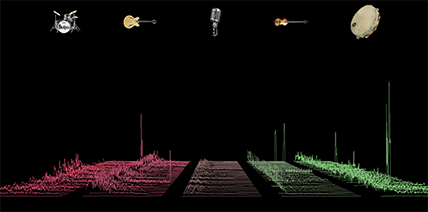
For more information about the MAT Seminar Series, go to: seminar.mat.ucsb.edu.
For previous seminars, please visit our MAT Seminars Video Archive.
Speaker: Jon Jenkins
Monday, February 27th, 2023 at 1pm PST via Zoom
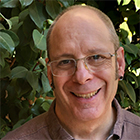
Abstract
The first planet outside our own solar system was discovered almost thirty years ago in an extremely unlikely place, orbiting a pulsar, and the first exoplanet orbiting a Sun-like star was discovered nearly 26 years ago. In the time since, we’ve detected over 5000 planets and over 75% of these have been detected by transit surveys. The Kepler Mission, launched in 2009, has found the lion’s share of these exoplanets (>3200), and demonstrated that each star in the night sky has, on average, at least one planet. Kepler’s success spurred NASA and ESA to select several exoplanet-themed missions to move the field of exoplanet science forward from discovery to characterization: How do these planets form and evolve? What is the structure and composition of the atmospheres and interiors of these planets? Can we detect biomarkers in the atmospheres of these planets and learn the answer to the fundamental question, are we alone? NASA selected the Transiting Exoplanet Survey Satellite (TESS) in 2014 to conduct a nearly all-sky survey for transiting planets with the goal of identifying at least 50 small planets (<4 Rearth) with measured masses that can be followed up by large telescopic assets, such as the upcoming James Webb Space Telescope. TESS has discovered 285 exoplanets so far, 104 of which are smaller than 2.5 REarth with measured masses. In this talk I will describe how we detect weak transit signatures in noisy but beautiful transit survey data sets and present some of the most compelling discoveries made so far by Kepler and TESS.
Bio
Jon Jenkins is a research scientist and project manager at NASA Ames Research Center in the Advanced Supercomputing Division where he conducts research on data processing and detection algorithms for discovering transiting extrasolar planets. He is the co-investigator for data processing for the Kepler Mission, and for NASA’s TESS Mission, launched in 2018 to identify Earth’s nearest neighbors for follow-up and characterization. Dr. Jenkins led the design, development, and operations of the science data pipelines for both Kepler and TESS. He received a Bachelor’s degree in Electrical Engineering, a Bachelor of Science degree in Applied Mathematics, a Master of Science degree in Electrical Engineering and a Ph.D. in Electrical Engineering from the Georgia Institute of Technology in Atlanta, Georgia.
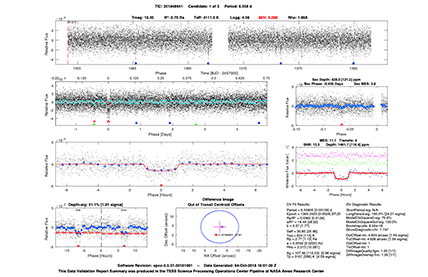
For more information about the MAT Seminar Series, go to: seminar.mat.ucsb.edu.
For previous seminars, please visit our MAT Seminars Video Archive.
Speakers: MAT alumni Aaron McLeran and Phillip Popp
Monday, February 13th, 2023 at 1pm PST. Elings Hall, room 2611 (Experimental Visualization Lab) and via Zoom.
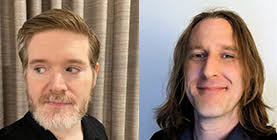
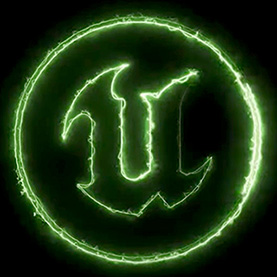
Abstract
Game audio is one of the most complex audio applications incorporating audio DSP, spatial and physical modeling, linear audio production and interactive sound design. The next generation of game audio engines offer a unique tool capable of creating distributable works of interactive audio alongside state-of-the-art animation, physics, visual effects, and graphics pipelines. In this talk we will explore the expressiveness of game audio engines and consider the problems they were designed to solve. We will also dive into MetaSound, a next generation interactive DSP graph tool for game audio. We will discuss its design including directed acyclic flow graphs, sample accurate timing, flexible subgraph composition and low latency interactivity from a perspective of computational performance and usability.
Aaron McLeran Bio
Aaron McLeran is a 2009 alumnus from MAT (2009) and has more background in physics and music. He was a sound designer and composer in video games before becoming an audio programmer. He's now the Director of the Audio Engine at Epic Games working on Unreal Engine 5. He's worked on game audio for Spore, Dead Space, Call of Duty, Guild Wars 2, Paragon, and Fortnite, as well as all of Epic's tech demos and many special projects since 2014.
Phillip Popp Bio
Phillip Popp works in the nexus of audio tools, DSP and machine learning. He has over a decade of professional experience researching and developing a wide variety of audio analysis, machine learning, personalization and real-time synthesis technologies. As a Principal Audio Programmer at Epic Games he advances the state-of-the-art in game audio by building flexible, expressive and performant tools to power the next generation of interactive audio experiences.
For more information about the MAT Seminar Series, go to: seminar.mat.ucsb.edu.
For previous seminars, please visit our MAT Seminars Video Archive.
Speaker: Erin Gee
Monday, February 6th, 2023 at 1pm PST via Zoom
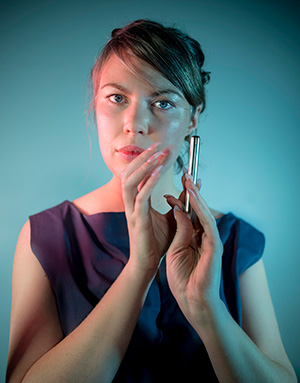
Abstract
Since the 1960s, composers have used technology to interrupt, amplify, and distort the relationship between music and its psychosomatic perception, seemingly dissolving Cartesian dualisms between mind/body while ushering in a new era of musical experience. At the borders of "new music" and "electronic music,” biofeedback music is often articulated through futurist, cybernetic, and cyborg theory. I argue that the revolutionary promise of biofeedback music is compromised by its situatedness in traditional systems of value typical to European art music, in which patriarchal, humanist, and colonial bias quietly dominate the technological imaginary through metaphor.
In this presentation I contextualize biofeedback music history through the work of feminist musicologists and art historians, and also share examples of my own work in affective biofeedback: the development of low-cost and accessible open-source technologies, as well as the development of performance methods influenced by hypnosis, ASMR, and method acting as applied to choral music, robotic instruments, and VR interfaces.
Articulating biofeedback composition through principles of emotional reproduction and emotional labor, I emphasize wetware technologies (body hacking, social connection, empathetic and affective indeterminacy, and psychosomatic performance practice) as crucial compliments to biofeedback hardware and software.
Bio
Canadian performance artist and composer Erin Gee ( TIO’TIA:KE – MONTREAL) takes inspiration from her experience as a vocalist and applies it to poetic and sensorial technologies, likening the vibration of vocal folds to electricity and data across systems, or vibrations across matter. Gee is a DIY expert in affective biofeedback, highlighting concepts like emotional labor, emotional measurement, emotional performance, and emotional reproduction in her work that spans artificial intelligence technology, vocal and electronic music, VR, networked performance, and robotics. Gee’s work has been featured in museums, new media art festivals, and music concert halls alike. She is currently a Social Studies and Humanities Research Council Canada Graduate Scholar at Université de Montréal, where she researches feminist methods for biofeedback music.
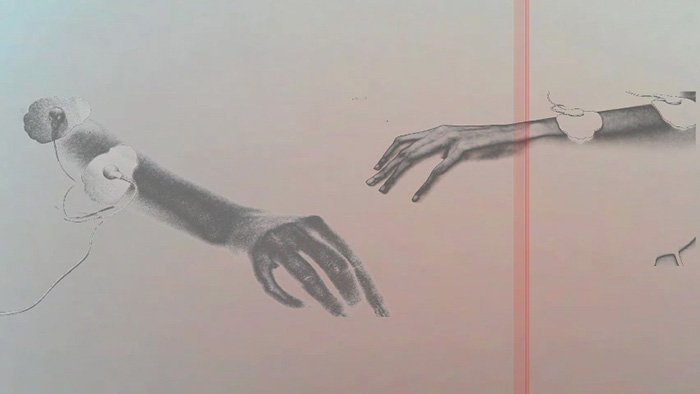
Presence (2020) by Erin Gee and Jen Kutler.
For more information about the MAT Seminar Series, go to: seminar.mat.ucsb.edu.
For previous seminars, please visit our MAT Seminars Video Archive.
Thursday, February 2nd 2023, 6 - 9pm
The current MAT students and alumni that will present their work are:
The event is organized by the MAT Student Reps (Nefeli Manoudaki, Iason Paterakis, and Pau Rosello Diaz).
SBCAST is located at 513 Garden St, Santa Barbara, 93101
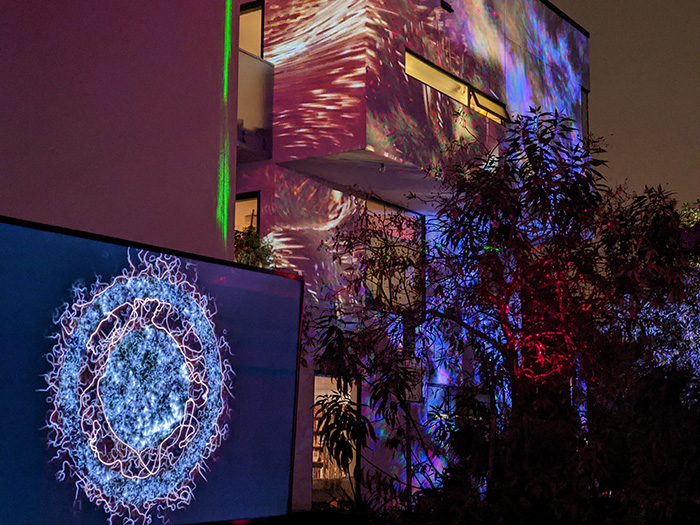
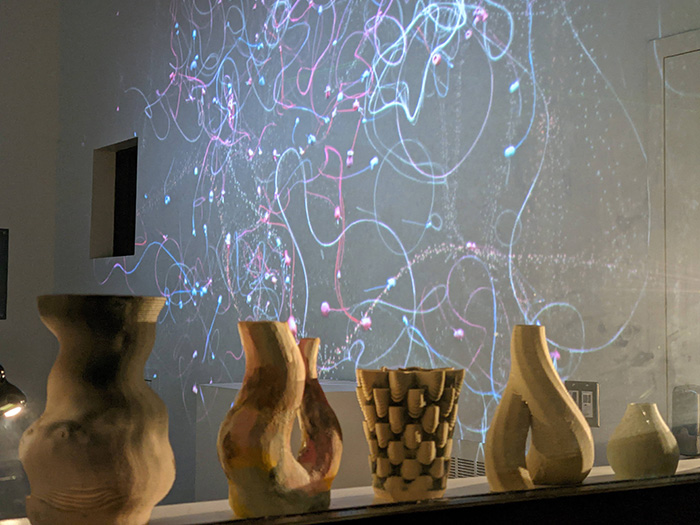
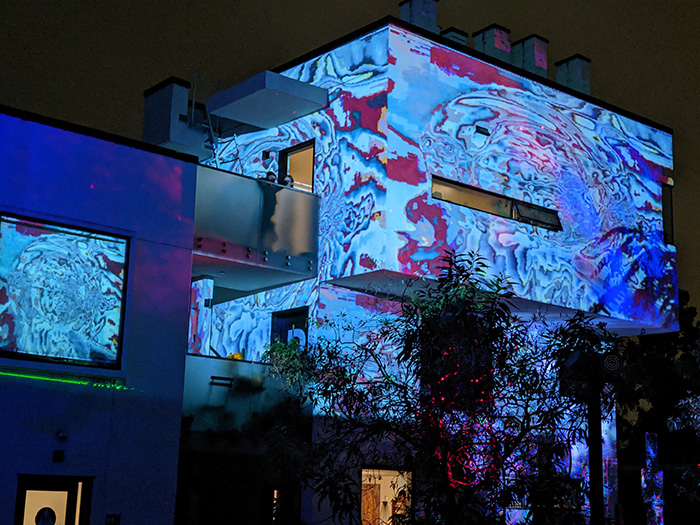
Speaker: Laura Devendorf
Monday, January 30th, 2023 at 5pm PST via Zoom
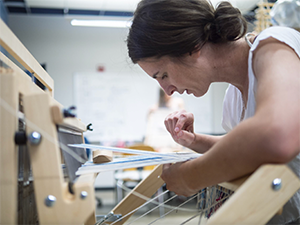
Abstract
This talk will present a speculation rooted in my experience weaving electronics and developing software for weaving electronics. I will introduce the basics of woven structure in terms of its mechanical properties as well as methods by which it is designed and manipulated. I will also present some of the exciting opportunities for design and interaction when we consider weaving as a method of electronics production: such as the ability for textile structures to unravel, mended, and to be continually modified. Each of these underlying discussions will frame a provocation about alternative ways we might build, use, and unbuild our electronic products.
Bio
Laura Devendorf, assistant professor of information science with the ATLAS Institute, is an artist and technologist working predominantly in human-computer interaction and design research. She designs and develops systems that embody alternative visions for human-machine relations within creative practice. Her recent work focuses on smart textiles—a project that interweaves the production of computational design tools with cultural reflections on gendered forms of labor and visions for how wearable technology could shape how we perceive lived environments. Laura directs the Unstable Design Lab. She earned bachelors' degrees in studio art and computer science from the University of California Santa Barbara before earning her PhD at UC Berkeley School of Information. She has worked in the fields of sustainable fashion, design and engineering. Her research has been funded by the National Science Foundation, has been featured on National Public Radio, and has received multiple best paper awards at top conferences in the field of human-computer interaction.
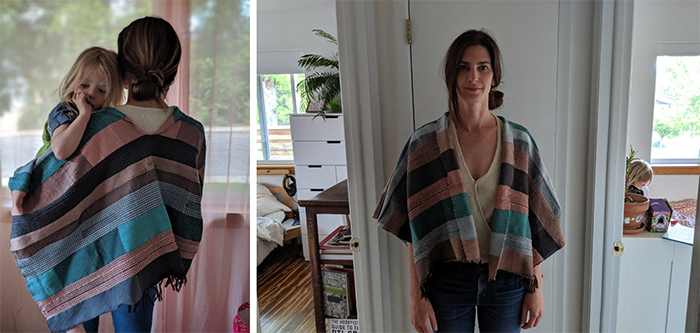
www.colorado.edu/atlas/laura-devendorf
For more information about the MAT Seminar Series, go to: seminar.mat.ucsb.edu.
For previous seminars, please visit our MAT Seminars Video Archive.
Speaker: Jeremy Kamal
Monday, January 23, 2023 at 1pm PST via Zoom
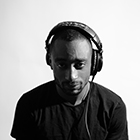
Abstract
In the context of the American landscape, the black body has historically been viewed as an “earth machine”. A technology used to lift the soil, root the flora, sow the seeds, break the stone, and pump the water. Before John Deers and Bob Cats, there were Black slaves. The till, plow, jackhammer, excavator, piston, and axe condensed into a single metric. In addition to an exploitative capitalistic enterprise, slavery was also a cruel geoengineering project.
This talk reframes the historic narrative of the Black identity as a landscape technology through the exploration of a fictional world entitled Mojo. Distinctions between blackness, landscape, and technology, are blurred allowing black creativity, expression, and spirituality to materialize on an ecological scale. What would our landscapes look like if shaped by the values of a different culture? We unpack this question through a collection of CGI Afrofuturist vignettes that engage storytelling and science fiction as critical means to envision new trajectories of black identity.
Bio
Visual artist Jeremy Kamal engages CGI storytelling to explore relationships between Blackness, technology, and ecology. He is a design faculty at the Southern California Institute of Architecture. He studied Landscape Architecture at Harvard GSD and received a Master of Arts in SCI-Arc’s postgraduate Fiction and Entertainment program. His work uses themes of landscape and fiction to envision speculative environments in which Black life is at the center of geological phenomena. Through fiction, Kamal is interested in making explicit the connection between cultural abstractions and ecological realities. His focus on landscape-centric narratives is the driving force behind the worlds he brings to life through animation, game engine technology, music, and storytelling. Kamal's work offers another perspective on the way we think about space and the cultural behaviors that shape it.
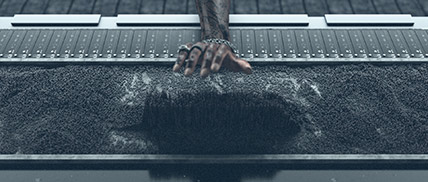
For more information about the MAT Seminar Series, go to: seminar.mat.ucsb.edu.
For previous seminars, please visit our MAT Seminars Video Archive.
Speaker: Mitchell Akiyama
Monday, January 9, 2023 at 1pm PST via Zoom
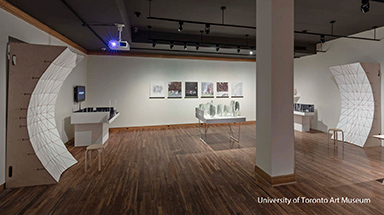
Abstract
This talk will explore my approach to working with technology in bad faith. The technologies we rely on are meant to provide frictionless solutions to problems, and when things work as they should, these tools are meant to recede from the user’s attention. But when we intend to break technological tools and processes, their logic and the ideologies that they conceal become more apparent or present to hand. I will discuss recent work, including work in progress, that brings my interest in the obtuse and the obstinate to AI, which has recently included an effort to create personal AI oracles for exploring the aesthetics of subjectivity after Machine Learning.
Bio
Mitchell Akiyama is a Toronto-based scholar, composer, and artist. His eclectic body of work includes writings about sound, metaphors, animals, and media technologies; scores for film and dance; and objects and installations that trouble received ideas about history, perception, and sensory experience. He holds a PhD in communications from McGill University and an MFA from Concordia University and is Assistant Professor of Visual Studies in the Daniels Faculty of Architecture, Landscape, and Design at the University of Toronto.
For more information about the MAT Seminar Series, go to: seminar.mat.ucsb.edu.
For previous seminars, please visit our MAT Seminars Video Archive.
Monday, December 19th, 2022
8am PDT
Room 2003, Elings Hall and via Zoom
Abstract
Immersive technologies are widely used in interactive media art and storytelling today. A high quality virtual environment and avatar can provide the audience a strong sense of presence and ownership of the virtual body, evoking empathetic outcomes from the experience. However, the majority of immersive art we encounter today shows a strong favoring of visual and auditory sensation over interactions. They provide the audience a limited number of ways to participate in an immersive narrative, leaving them a sense of being an “outsider” that breaks the connection between the audience’s virtual avatar and the virtual environment. Starting with Nicolas Bourriaud’s relational aesthetics for art creation and taking human relations and their social context as the main conceptual and practical point of departure for experience design, I develop artistic and technical strategies for creating immersive experiences that place the audience at the center to let them activate the narrative content and cultural meanings. My approach is to provide the user novel ways to relate themselves to what they see on a screen, and to allow for direct participation and engagement. Through an increased level of interactivity, co-presence and plausibility in immersive environments, my work aims to help the audience develop new relationships with other people, with virtual entities, and with AI agents. The hybrid systems introduced in this thesis describe novel ways for creating relational experiences by techniques learned from different domains such as soft robotics, quantum computing and social science. I also demonstrate authoring interface design that can be more widely adopted by the creative community to overcome the challenges often faced in immersive and interactive narrative compositions.
Saturday, December 3rd and Saturday, December 10th from 1-4pm
Elings Hall, room 2024
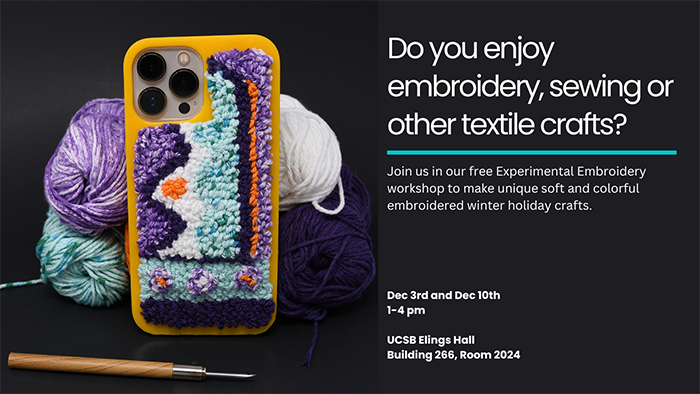
We’ll show you how to design and make 3D printed patterns to create soft 3D crafts like ornaments, decorations, and jewelry.
The workshop is free of charge and all materials will be provided. You must be 18 years or older, and available for both days of the workshop to participate.
Space is limited. To enroll complete and submit this form via the web: https://bit.ly/experimental-embroidery
For more information, please visit: https://ecl.mat.ucsb.edu/embroidery.

Speaker: Graham Wakefield
Monday, December 5th, 2022 at 1pm PST, Elings Hall room 2611 and via Zoom.
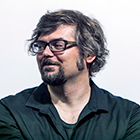
Abstract
The gen~ environment for Max/MSP lets us work on sonic algorithms down to sample and subsample levels. Written a decade ago during my doctoral research at MAT, UCSB, it has become a widely used platform for sonic experimentation, interactive arts, product design, and music making by artists such as Autechre, Robert Henke, and Jim O’Rourke. At its heart is the capacity to write whole algorithms that are processed one sample at a time, allowing unique access to filter, oscillator and other micro-level synthesis designs, and where each edit made while patching seamlessly regenerates optimized machine code under the hood (and which can be exported for use elsewhere). In this talk I will introduce the gen~ environment, including how and why it was developed, but also where and how it can be applied and what it has inspired. This will draw material from a new book about sonic thinking with signals and algorithmic patterns, with a gamut of synthesis and audio processing examples demystified through patching with gen~.
Bio
Graham Wakefield is an Associate Professor and Canada Research Chair in the department of Computational Arts at York University, where he leads the Alice Lab, dedicated to computational art practice and software development in mixed/hybrid reality. His ongoing research practice applies a deep commitment to the open-endedness of computation—as an art material—as expressed both in new software for artists and musicians (such as the gen~ environment for Max/MSP), as well as immersive artworks of biologically-inspired systems (working with Haru Ji as Artificial Nature). These installations have been exhibited in many international venues and events, including La Gaîté Lyrique/Paris and ZKM/Germany, and his research has been published in the Computer Music Journal, IEEE Computer Graphics & Applications, the International Journal of Human-Computer Studies, Leonardo, ICMC, NIME, SIGGRRAPH, ISEA, EvoWorkshops, and many more.
Graham Wakefield's new book (October 2022):
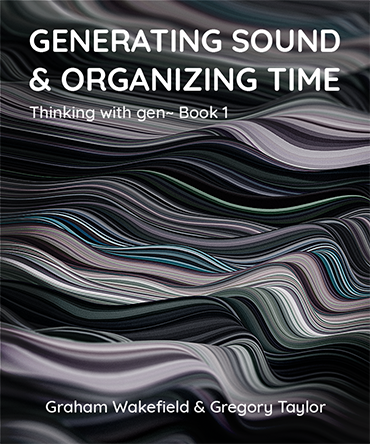
https://cycling74.com/books/go
For more information about the MAT Seminar Series, go to: seminar.mat.ucsb.edu.
For previous seminars, please visit our MAT Seminars Video Archive.
Friday, December 2nd, 2022 at 4pm PST
Music Building, Studio Xenakis, room 2215
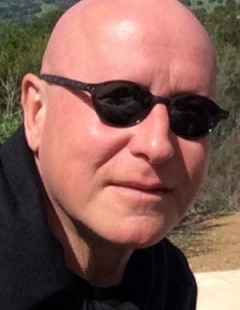
Abstract
In this talk, profesosor Roads will discuss past projects as well as current and planned projects in software development, music composition, and publishing.
Curtis Roads is professor and chair of Media Arts and Technology and affiliate faculty in Music at UCSB.
Friday, December 2nd, 2022 at 2pm PST
Music Building, Studio Xenakis, room 2215
Abstract
Dynamic Stochastic Synthesis (DSS) is a direct digital synthesis method invented by Iannis Xenakis that produces a wave of variable periodicity through regular stochastic variation of its wave cycle, resulting in emergent pitch and timbral features. While high-level parametric control of the algorithm enables a variety of musical behaviors, composing with DSS is difficult because its parameters lack basis in perceptual qualities. The Xenos virtual instrument plug-in implements DSS with modifications and extensions that enhance its suitability for general composition. Written in C++ using the JUCE framework, Xenos offers DSS in a convenient, efficient, and widely compatible polyphonic synthesizer that facilitates composition and performance through host-software features, including MIDI input and parameter automation. Xenos also introduces a pitch-quantization feature that tunes each period of the wave to the nearest frequency in an arbitrary scale. Custom scales can be loaded via the Scala tuning standard, enabling both xenharmonic composition at the mesostructural level and investigation of the timbral effects of microtonal pitch sets on the microsound timescale.
Speaker: Carmine Emanuele Cella
Monday, November 21, 2022 at 12pm PDT via Zoom.
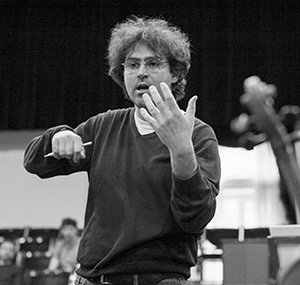
Abstract
The advancements in machine learning and, in particular, the recent breakthrough of artificial neural networks, has promoted novel art practices in which computers play a fundamental role to support & enhance human creativity. Alongside other arts, music and dance have also benefited from the development of machine learning and artificial intelligence to support creativity, for tasks ranging from music generation to augmented dance. This talk will present an overview of my research, focused on the intersection of artistic creation and performance, mathematical modelling, machine learning and human-computer interaction – and on their entwined co-evolution.
Bio
Carmine Emanuele Cella, is an internationally renown composer with advanced studies in applied mathematics. He is assistant professor in music and technology at CNMAT, University of California, Berkeley. He studied at Conservatory of Music G. Rossini in Italy getting diplomas in piano, computer music and composition and then studied composition with Azio Corghi at Accademia S. Cecilia in Rome; he also studied philosophy and mathematics and got a PhD in applied mathematics at the University of Bologna working on symbolic representations of music.
For more information about the MAT Seminar Series, go to: seminar.mat.ucsb.edu.
For previous seminars, please visit our MAT Seminars Video Archive.
Thursday, November 17th, 2022 at 11am PST.
Studio Xenakis, Music Building room 2215 and via Zoom.
Abstract
The use of space in music is a complex issue which involves several different, yet interrelated factors. The technical means of performance, the sonic material, and the overall musical aesthetic should all work together to produce a truly immersive experience and one which the listener can comprehend the spatial impression as independent and yet musically significant. Performances of spatial music typically involve a distributed audience and often take place in an acoustically reverberant space. This situation is quite different from the case of a single listener at home, or the composer in the studio or in a virtual reality setting with head mounted displays. As a result, spatial strategies which are effective in one context may not be transferable to another context. This thesis attempts to study the psychoacoustic factors or various music spatialization strategies in different contexts and in that process attempts to answer the question, What and how do psychoacoustic factors affect listening to music in non-virtual listening contexts and how could they transform when listening in a virtual listening context?
This question is answered through three psychoacoustic studies. The first one on Sound Source Distance, the second and third are comparative studies of music spatialization algorithms with different music genres – a loudspeaker study and a binaural analysis study. The last part of the thesis is to build a prototype of a virtual concert hall that uses some of the learnings of the aforementioned studies.
Monday, November 14th, 2022 at 2pm PDT
Elings Hall room 2003
Abstract
Live coding---the real-time procedural creation of audiovisual works---suggests opportunities to extend hand-drawn animation; however, existing live coding systems are incompatible with manual animation workflows. Manual input is not a primary datatype in existing live coding languages and live coding tools require using symbolic programming environments. I theorize that by applying direct manipulation to the domain of live coding, we can enable animators to create expressive mappings between hand-drawn animations and audio effects in real-time. I present Megafauna, a sketch-based system for audiovisual performance, informed by interviews with professional animators. Megafauna supports the integrated generation and control of hand-drawn animation and audio sequences by enabling animators to directly sketch mapping functions between animation frames and sound generators. I demonstrate the expressive potential of Megafauna by reproducing animated compositions from procedural and manual domains. I evaluate the opportunities of our approach for live production through an expert review of a performance piece created with Megafauna.
Speaker: Kurt Werner
Monday, November 14, 2022 at 1pm PDT via Zoom.
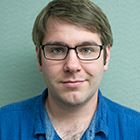
Abstract
In this talk, I present new designs for 1-bit synthesizers, audio effects, and signal mixers which transcend classical limitations of the (historically, very limited) format, creating new possibilities for musical expression. After reviewing some of the classical examples of 1-bit music, I will describe my novel approach to designing novel 1-bit musical tools. These include, e.g., 1-bit stochastic wavetables, resonant and comb "filters," artificial reverberation, advanced multiplexor- and digital-logic-based signal mixers, and advanced binary bitcrushers. Special emphasis will be placed on a new variant of sparse noise I developed called “Crushed Velvet Noise,” which is especially useful for 1-bit music.
Bio
Dr. Kurt James Werner conducts research related to virtual analog and circuit modeling, the history of music technology (especially drum machine voice circuits), 1-bit music, circuit bending, & sound synthesis more broadly, and sometimes composes too. As part of his Ph.D. in Computer-Based Music Theory and Acoustics from Stanford University's Center for Computer Research in Music and Acoustics (CCRMA), he wrote a doctoral dissertation “Virtual Analog Modeling of Audio Circuitry Using Wave Digital Filters.” This greatly expanded the class of circuits that can be modeled using the Wave Digital Filter approach, using the classic Roland TR-808 bass drum circuit as a case study. Currently based out of Somerville, MA, he was formerly an Assistant Professor of Audio at the Sonic Arts Research Centre (SARC) of Queen's University Belfast and a Research Engineer at iZotope, Inc.
For more information about the MAT Seminar Series, go to: seminar.mat.ucsb.edu.
For previous seminars, please visit our MAT Seminars Video Archive.
Friday, November 4th 2022 at 7:30pm at the Lotte Lehmann Concert Hall in the Music Building.
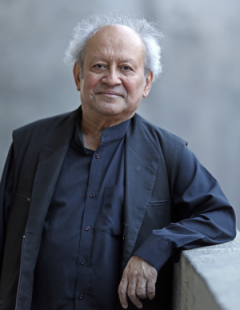
The CREATE concert Permutations and Combinations features the return from Barcelona of the UCSB Corwin Chair of Composition Emeritus Clarence Barlow. His algorithmically-composed music is both audiovisual and multichannel spatial.
Also featured is Dr. Rodney Duplessis, a recent UCSB graduate in music composition, and Drew Flieder, a current PhD student at UCSB. Professor Curtis Roads will also play a piece. The concert will conclude with a new ambisonic spatial work by the Paris-based composer Anne Sèdes. The duration of the concert is one hour.
Professor Barlow will also give a talk about the compositions he has worked on since 2019. Tuesday, November 8 2022 at 5pm, Studio Xenakis, Music Building room 2215.
The composition are:
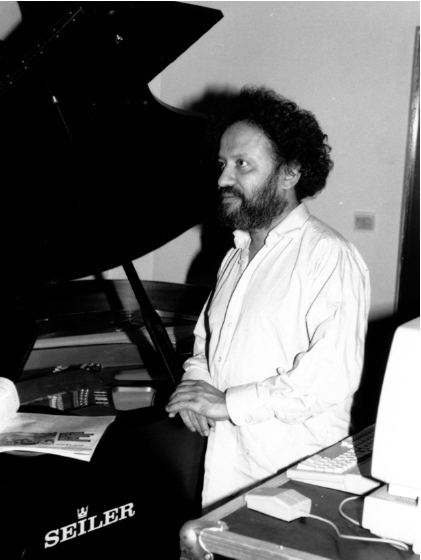
Clarence Barlow 1989
Friday, November 4th, 2022 at 3:30pm PDT.
Room 2003 Elings Hall and via Zoom.
Abstract
Before handheld cameras, most pictures and videos were taken in a carefully controlled professional setting and mainly produced for consumption beyond the individual. However, nowadays, the most significant portion of the world’s captured visual data are personal photos and videos taken by individual users. 3D content as a medium will go through this same recognizable phase. Most 3D experiences, video games, and movies are created by advanced users in professional settings. With the seemingly inevitable rise of Virtual and Augmented Reality, experiencing 3D content will no longer be limited to entertainment. We will be (and are beginning to be) able to see and share personal 3D content in everyday life.
In this dissertation, we address some of the open questions in the area of 3D content by studying user experiences in immersive environments and providing tools to create these environments from sparsely available building blocks more quickly using approachable user interfaces.
In our work PanoTrace, we introduce a 3D modeling platform for creating 3D scenes from 2D panoramas, and we measure the effects of added depth and degrees of freedom on various independent variables. Our results show higher immersion for 3D PanoTrace scenes when viewing in 6DOF. We also show that 6DOF tracked 3D panoramas lead to significantly better immersion, realism, and user comfort when compared to the original 3DOF panoramas.
In our second work, “Walking and Teleportation in Wide-area Virtual Reality Experiences,” we present the first VR study to understand the impact of natural walking versus teleportation in a large physical space on presence and user preference. Our results show that the participants overwhelmingly preferred walking, which tended to higher self-reported immersion, and that teleportation resulted in significantly higher self-reported simulator sickness.
We later discuss the application of intelligent systems in content creation and introduce DeepDive, a VR-ML installation that lets users infinitely dive into satellite images by incrementally increasing the resolution. As our next machine learning contribution, we present CASEIn, a Content-Aware Semantic Editing, and Inpainting system that generates state-of-the-art quality for image inpainting and image-to-image translation.
In the final chapter, we introduce Faded, a memory reconstruction system that extrapolates sparse information, like a handful of photos, into a cohesive 3D experience. Faded is a multi-component system that lets users create a layout of a 3D space from memory and place projected 2D images directly into the layout and extrapolate the missing areas using our previously introduced semantic editing and inpainting system: CASEIn.
Tuesday, November 1st, 2022. 7pm at the Pollock Theater, UCSB.

UCSB Music Professor Emeritus Clarence Barlow will join moderator Peter Bloom (Film and Media Studies, UCSB) for a post-screening discussion of Barlow's work on film.
The evening’s program will feature the following films: Uccelli Ungheresi (1988), Kuri Suti Bekar (1998), Estudio Siete (1995/2015), Zero Crossing (2001), )ertur( (2015) and Evanescent Evidence (2021).
An internationally recognized pioneer of electroacoustic, computer, and interdisciplinary music, Clarence Barlow has created exquisite algorithmic compositions for traditional instruments and electronic devices since the 1970s. Barlow’s interest in compositional technique has been adapted to a number of experimental films that he has made since 1988. In the six films presented as part of this program, his compositions are illustrated through visual media. Barlow’s compositional address to visual representation extends our understanding of his own unique compositional approach to tonality and metricism.
The event is free but reservations are recommended in order to guarantee a seat.
Tickets for the event can be reserved here: www.carseywolf.ucsb.edu/pollock-events/barlow
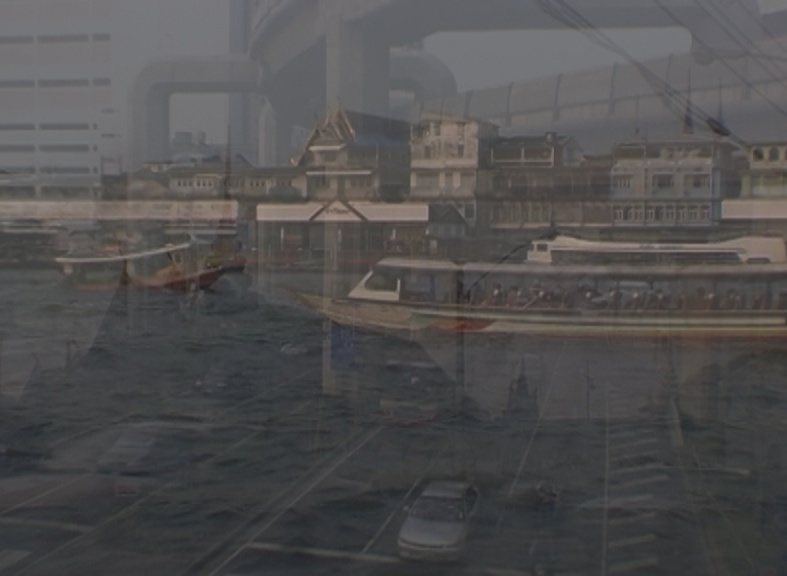
For more information about the MAT Seminar Series, go to: seminar.mat.ucsb.edu.
For previous seminars, please visit our MAT Seminars Video Archive.
Speaker: Haru Hyunkyung Ji
Monday, October 31, 2022 at 1pm via Zoom.
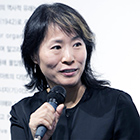
Abstract
Humans have always looked to nature for inspiration. As artists, we have done so in creating a family of “Artificial Natures”: interactive art installations surrounding humans with biologically-inspired complex systems experienced in immersive mixed reality. Through building immersive artificial ecologies, we are questioning how we may coexist with non-human beings in ways that are more abundantly curious, playful, and mutually rewarding. In this talk, from an innate curiosity and aesthetic survival instinct, I will share how we are bringing alternate worlds in superposition to us in order to shatter the perspective of humans as the center of the world and to deepen our understanding of the complex intertwined connections in dynamic living systems.
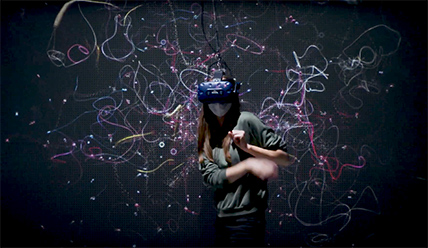
Bio
Haru Hyunkyung JI is a media artist and co-creator of the research project “Artificial Nature”. She holds a Ph.D. in Media Arts and Technology from the University of California Santa Barbara and is an Associate Professor in the Digital Futures, Experimental Animation, and Graduate programs at the OCAD University in Toronto, Canada. She works as jury member for SIGGRAPH Art Papers, ISEA, and SIGCHI DIS and has published articles in Leonardo, Stream04, IEEE Computer Graphics and Applications among others.
Artificial Nature is an installation series and research project by Haru JI and Graham WAKEFIELD, creating a family of interactive art installations surrounding humans with biologically-inspired complex systems experienced in immersive mixed reality. Since 2007, Artificial Nature installations have shown at international venues including La Gaite Lyrique (Paris), ZKM (Karlsruhe), CAFA (Beijing), MOXI and the AlloSphere (Santa Barbara), and City Hall (Seoul, South Korea), festivals such as Microwave (Hong Kong), Currents (Santa Fe), and Digital Art Festival (Taipei), conferences such as SIGGRAPH (Yokohama, Vancouver), ISEA (Singapore), and EvoWorkshops (Tubingen), as well as recognition such as the international 2015 VIDA 16.0 Art & Artificial Life competition and the 2017 Kaleidoscope Virtual Reality showcase.
For more information about the MAT Seminar Series, go to: seminar.mat.ucsb.edu.
For previous seminars, please visit our MAT Seminars Video Archive.
Speaker: Joshua Dickinson
Monday, October 24, 2022 at 1pm PDT. Room 2611 Elings Hall and via Zoom.
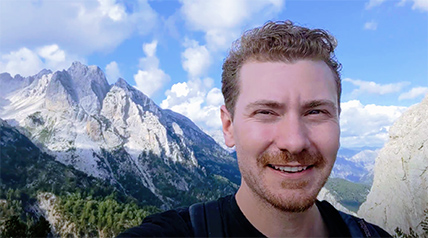
Abstract
In this talk I will show examples of how attempts to simulate and exaggerate the qualities of analog systems have led to new, often unexpected, and unexplored tools for sound design. We will discuss "supernormal stimuli" and hyperreality, and how these concepts can be used as a lens for common sound processing techniques as well as a framework for developing future algorithms. We will cover lesser-known tricks for adding an organic feel into digital systems and what areas seem ripe for future exploration, using examples from our own product line as well as the work of other companies throughout the audio industry. Topics will include new approaches to drum sampling and modeling, vinyl simulation, dynamics processing, neuroaesthetics, analog modeling, non-linearity, and timbral expansion.
Bio
Joshua Dickinson is a founder of Unfiltered Audio, a company specializing in creative audio effects and synthesizers. He is an instructor at Berkeley City College, where he teaches courses on topics such as graphic visualization, HCI, games, and entrepreneurship.
For more information about the MAT Seminar Series, go to: seminar.mat.ucsb.edu.
For previous seminars, please visit our MAT Seminars Video Archive.
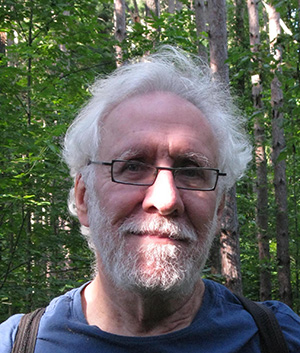
Dates: October 13th and 14th, 2022.
October 13th: free performances at 6pm, 7pm, and 8pm.
October 14th: walk-in installation starting at 6pm.
The AlloSphere is located in the California NanoSystems Institute, Elings Hall, on the UCSB campus. The entrance is located on the second floor.
Musics of the Sphere is a spatial audio composition made expressly for the 54.1 channel sound system of the AlloSphere, with no visuals, featuring the unique audio resolution of the instrument. The work is a 57-minute, fixed-media computer music composition in six tracks of spatially modulated sounds. The Allosphere is the perfect venue to present the piece where loudspeakers are placed around and above and below the listeners.
This new work by Dr. Morris is a celebration of "musics" from all over the world. Over 150 excerpts of all types of music from Africa, the Americas, Asia, and Europe comprise the sounds in each track. These "musics" are presented as such (without modification) to partial and complete transformation via a host of computer music techniques.
Bio
Dr. Robert Morris is an internationally known composer and music scholar, having written over 180 compositions including computer and improvisational music and music to be performed out of doors, as well as four books and over 70 articles and reviews. Since 1980, he has taught at the Eastman School of Music, University of Rochester as Professor of Composition and affiliate member of the Theory and Musicology Departments, and at present interim Chair of the Composition Department. His many compositions have been performed in North and South America, Europe, Australia, and Japan. Morris's music is recorded on Albany Records, Attacca, Centaur, Composers Recordings Incorporated, Fanfare, Music and Arts, Music Gallery Editions, New World, Neuma, Open Space, and Renova.
Speaker: Robert Morris
Wednesday, October 12, 2022 PDT. Room 2611 Elings Hall and via Zoom.
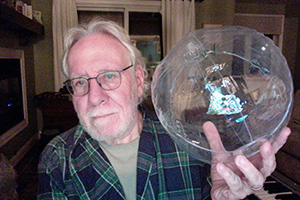
Abstract
I will discuss and describe my new composition, Musics of the Sphere, to be presented in the AlloSphere on Oct 13 and 14, 2022. The work is a 57 minutes-long fixed-media computer music composition in six tracks of spatially modulated sounds. The sounds on each track move between six locations: Up (above) Down (below), North (in front), East (to the right), South (in back), and West (to the left). Therefore, the Allosphere is the perfect venue to present the piece where loudspeakers are placed around the listeners to implement the six spatial locations.
Musics of the Sphere is a celebration of musics from all over the world. Over 150 excerpts of all types of music from Africa, the Americas, Asia, and Europe comprise the sounds in each track. These musics are heard from without modification to complete transformation via a host of computer music techniques. This composition is not the first of mine that uses “world musics.” In 1973, I composed a 45-minute electronic piece in four tracks called Thunder of Spring over distant Mountains. This piece was based on seven pieces of Asian and south-Asian music. The talk I will discuss the differences between Thunder and Musics from three points of view: the technical sound production; the structures of each; and the way each piece implements my thinking about music from a ethnomusical perspective.
Bio
Robert Morris (1943) is an internationally known composer and music scholar, having written over 180 compositions including computer and improvisational music, music to be performed out of doors, four books, and over 70 articles and reviews. Since 1980 he has taught at the Eastman School of Music, University of Rochester as Professor of Composition and affiliate member of the Theory and Musicology Departments, and at present interim Chair of the Composition Department. His many compositions have been performed in North America, Europe, Australia, and Japan. Morris's music is recorded on Albany Records, Attacca, Centaur, Composers Recordings Incorporated, Fanfare, Music and Arts, Music Gallery Editions, New World, Neuma, Open Space, and Renova.
For more information about the MAT Seminar Series, go to: seminar.mat.ucsb.edu.
For previous seminars, please visit our MAT Seminars Video Archive.
Speaker: Bettina Forget
Monday, October 3, 2022, at 1pm PDT via Zoom
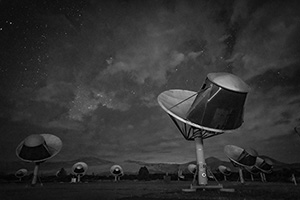
Abstract
Are we alone in the universe? This is the existential question at the heart of the SETI Institute’s research - both for its scientists as well as for the artists in its AIR program. Bettina Forget will discuss various modes of engagement between art, science, and technology by showcasing a selection of projects across the disciplines of new media arts, performance, AI, and storytelling.
Bio
Bettina Forget is the Director of the SETI Institute’s Artist-in-Residence (AIR) program. Her creative practice and academic research examine the re-contextualization of art and science, and how transdisciplinary education may disrupt gender stereotypes. Bettina works with traditional as well a new media arts, focusing on astrobiology, sci-fi, and feminism.
For more information about the MAT Seminar Series, go to: seminar.mat.ucsb.edu.
For previous seminars, please visit our MAT Seminars Video Archive.
Speaker: Jelani Nelson
Monday, September 26th, 2022 at 1pm PDT via Zoom.
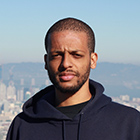
Abstract
Many of us use smartphones and rely on tools like auto-complete and spelling auto-correct to make using these devices more pleasant, but building these tools creates a conundrum. On the one hand, the machine-learning algorithms used to provide these features require data to learn from, but on the other hand, who among us is willing to send a carbon copy of all our text messages to device manufacturers to provide that data? In this talk, we show a surprising paradox discovered roughly 20 years ago: it is possible to learn from user data in the aggregate, while mathematically provably maintaining privacy at the individual level. We then present a recent private mechanism of our own for this task, based on projective geometry (popularized by Brunelleschi during the Italian Renaissance). This talk is based on joint work with Vitaly Feldman (Apple), Huy Le Nguyen (Northeastern), and Kunal Talwar (Apple).
Bio
Jelani Nelson is a Professor in the Department of Electrical Engineering and Computer Sciences at UC Berkeley, and also a part-time Research Scientist at Google. His research interests include sketching and streaming algorithms, random projections and their applications to randomized linear algebra and compressed sensing, and differential privacy. He is a recipient of the Presidential Early Career Award for Scientists and Engineers, a Sloan Research Fellowship, and Best Paper Awards at PODS 2010 and 2022. He is also Founder and President of AddisCoder, Inc., which has provided free algorithms training to over 500 Ethiopian high school students since 2011, and which is co-launching a similar "JamCoders" program in Kingston, Jamaica in Summer 2022.
For more information about the MAT Seminar Series, go to: seminar.mat.ucsb.edu.
For previous seminars, please visit our MAT Seminars Video Archive.
Pilar Wiley and Avi Farber, our 2022 Experimental Clay artists in residence, will be talking about their work. Pilar and Avi will share their earlier work, as well as some details about the work they have undertaken in our lab and the opportunities and limitations they see for digital fabrication within their practice.
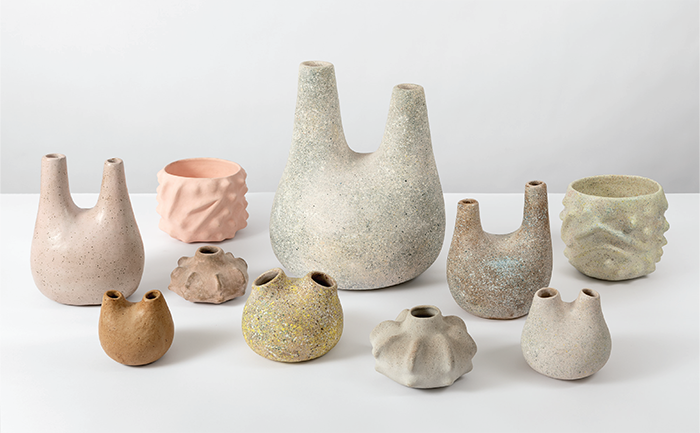
Pilar Wiley
Los Angeles-based Pilar Wiley makes ceramic vessels that serve as canvases for her repeating patterns and pictorial themes. Her surfaces express the idiosyncrasies of mark making, referencing global traditions of decorative abstraction, as well as imagery drawn from plant life and her childhood overseas. Influenced by the forms and techniques of West and South African pottery, Wiley advances a personal mythology through the repetitive ceramic process. Capitalizing on clay’s ritualistic associations, she endeavors to transform the information she consumes.
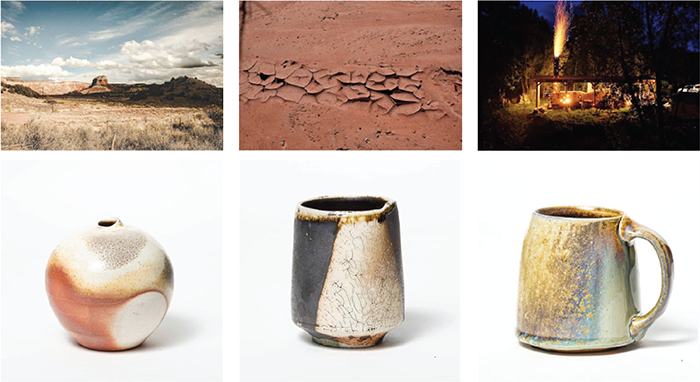
Avi Farber
Avi Farber is a multimedia artist working with woodfired ceramics, documentary photography, 3D Printing, and new media/sound, based in New Mexico, U.S.A. After earning a degree in Philosophy at Bates College, ME, Avi took a job fighting wildfires for the United States Forest Service. This inspired a large body of documentary work as well insights that led him to pursue a Masters degree in Interdisciplinary Design at Emily Carr University of Art and Design (2021).
Working in clay, Avi creates installations, sculptures, and functional wares that explore landscapes and weathering. Working with local clays and firing with wood, his work is raw and refined, subtle and gestural. Drawn to the moments that break through the distractions of daily life, Avi documents people in environmental frontiers. His photos, video, and sound installations reveal a strong sense of place as seen from a quiet observer. His projects explore human relationships with the natural phenomenon of our changing climate and alternative modes of production.
For more information, please visit ecl.mat.ucsb.edu/artisttalks
The Expressive Computation Lab at UCSB
The Santa Barbara Center for Art, Science and Technology (SBCAST)
Friday, July 8, 2022 at 1pm PDT.
Room 1605 Elings Hall and via Zoom.
Abstract
Soft robotics technologies hold substantial promise for use in wearable haptic systems, due to their ability to supply forces to the human body in a compliant, conformal, and safe manner. A challenge at the intersection of soft robotics and wearable haptics is to seamlessly integrate soft components into garments. The overarching goal of my Ph.D. research is to transform textiles into soft robotic haptic garments that are comfortable, ergonomic, and can provide multimodal, affective, and expressive haptic feedback tailored to the human sense of touch. This PhD integrates research on the design, fabrication, and control methods for soft robotic textiles. It contributes new methods for expressive haptic feedback for large areas of the body, and guidelines for the design of haptic feedback delivered via garments, accounting for immersion, emotion, affect, and health-related benefits. This dissertation contributes to the fidelity, ubiquity, and social relevance of wearable haptic systems, by allowing haptics to be seamlessly integrated within garments that are widely used.
The first part of this dissertation reviews emerging advances in soft wearable robotic and haptic technologies, and several promising application areas, including wearable haptic interfaces, assistive robotics, and biomedical devices [1]. It summarizes essential design considerations for such systems based on functional concerns, wearability, and ergonomics. It provides a synthetic review of design strategies that have been adopted in numerous examples from prior research by surveying sensing and actuation technologies, materials, and fabrication methods. The chapter concludes with a discussion of frontiers, challenges, and future prospects for soft, wearable robotics. These findings guided the development of novel wearable technologies and haptic rendering methods in the following parts of the thesis.
The second part of this dissertation presents the development of a new family of soft actuators that are suitable, versatile, and effective for wearable applications. We refer to these actuators as fluidic fabric muscle sheets (FFMS) [2]. These sheet-like actuators can strain, squeeze, bend, and conform to the human body. I designed and fabricated FFMS using fabrics and elastic tubes through facile apparel engineering methods. Though the fabrication process is low-cost and straightforward, FFMS can operate at frequencies of 5 Hz or more, achieve engineering strains exceeding 100%, and exert forces exceeding their weight by more than 10,000%. I further demonstrated several potential use cases of FFMS actuators, including a miniature steerable robot, a glove for grasp assistance, garments for applying compression to the extremities, and devices for actuating small body regions or tissues via localized skin stretch.
The next part of this dissertation demonstrates how FFMS actuators can be used to realize a wearable haptic interface with integrated sensing and multimodal actuation. Using six FFMS actuators, I constructed a forearm sleeve called the PneuSleeve [3]. It is able to render a broad range of haptic feedback types including compression, skin stretch, and vibration, and is able to supply consistent feedback to users with different arm sizes and anatomies by virtue of integrated soft capacitive sensors and a closed-loop force controller. Physical characterizations showed that the actuators generated consistent and perceivable forces at frequencies of 20 Hz, as validated in engineering characterizations. Results of user studies highlight the expressiveness of the haptic effects it provides. The PneuSleeve holds the potential for enabling new interfaces, haptic notifications, navigation, gaming, AR/VR experiences, and many other applications.
In the final part of this dissertation, informed by the preceding results, I designed and investigated a peristaltic soft robotic sleeve for supplying dynamic compression therapy via finger-sized FFMS actuators [4]. The sleeve can produce dynamic compression pressure exceeding 22 kPa at frequencies of 14 Hz or more, meeting the requirements for compression therapy and massage. An array of software-programmable peristaltic compression patterns can be furnished by varying frequency, amplitude, phase delay, and duration parameters. To evaluate the promise this sleeve holds for aiding peripheral hemodynamic flow, I designed a mechanical fixture integrating artificial muscles, skin, and a vein, modeled after the human upper limb. Results showed that the wearable robot was capable of driving fluid flow at rates of up to 1 mL/min. The results matched theoretically derived predictions for peristaltic fluid transport. This dynamic compression garment holds promise for treating disorders affecting lymphatic and blood circulation.
Wednesday June 8th, 2022 at 3pm PDT.
Experimental Visualizaton Lab (room 2611 Elings Hall) and via Zoom.
Abstract
Assemblage is an artistic practice where found or unrelated objects and different materials are juxtaposed to result in new entities, which often suggest non-linear narratives, poetic meanings, and new symbols. The ideas and methods of assemblage widely emerged during the early twentieth century in the early stages of modernism and were closely connected to modern art movements such as Cubism, Surrealism, and Dada. Nowadays, images are programmable databases that are increasingly networked with the advent of operative images and machinic vision, offering new ways to conceptualize assemblages based on authorship, connectivity, data-driven forms, materials, and chance and choice operations. In the field of new media art, few interactive artificial intelligent visual works address the changing notion of images through assembling image data as a real-time generative experience that emphasizes collective voices from artists, intelligent machines, and participants. In this context, I conduct practice-based research and propose a methodology for A Speculative Assemblage: transform the image-making process into a real-time visual experience in an artist-machine-participants collaborative manner.
A Speculative Assemblage proposes interdisciplinary and critical design research, which is at the intersection of experimental visualization, interactive AI art, and immersive media design. This research is demonstrated through three core interactive AI artworks (Cangjie's Poetry, LAVIN, and RAY), along with preliminary research: five image-based immersive art projects ( Fantastic Shredder, Repository, Borrowed Scenery, Astro, and Volume of Voids ). A novel design methodology and conceptual framework are presented to integrate intersections of the real and the virtual through the current methods to engage machine vision in relation to human perception and the impact of automation on originality.
Monday June 6th, 2022. 12pm PDT.
MAT Conference Room (2003 Elings Hall) and via Zoom.
Abstract
Along with the increasing digitization of society, our personal data has been explicitly or implicitly collected and shared through a plethora of digital devices and online social media services. This personal data has become of vital importance for researchers, designers, and artists to represent an impression of our datafied society and depict the images of data subjects through various forms of data representations. Meanwhile, the explosive increase of personal data has also been accelerated by commercial or governmental entities behind services or technology to monetize the customer data or surveil citizens. For that, the data is used to categorize or predict our behavior, preference, and identity through machines, for example, content recommendation and face recognition.
As our society is increasingly datafied, we see ourselves through our data for self-representation and self-understanding, which is collected and processed by the machines. Moreover, responses from the machines also affect us in shaping our behavior and understanding ourselves. Within this data-centered human-machine interrelationship, the Human-Data-Machine Loop, the machines see us through available, measurable data obtained from us and see us through stochastic, algorithmic processes to generalize individuals. Here uncertainty exists because personal data is not an objective representation of oneself and the machines are not perfect; they can be erroneous and biased upon the data or humans. These issues of uncertainty are difficult to estimate and represent, and they are problems to be solved especially in scientific domains. But, this uncertainty perspective can be a creative force or theme in data art. This dissertation proposes artistic approaches to represent this nature of uncertainty in the Human-Data-Machine Loop through data art. To this end, I first define the Human-Data-Machine (HDM) Loop as a main conceptual research framework to view our datafied society along with possible types/sources of uncertainty in the Loop. Second, I propose three types of data art practice based on the HDM framework: Artist-centered Practice, Artist-Machine Collaborative Practice, and Machine-centered Generative Practice. Last, the dissertation explains the author’s data-driven audiovisual art projects as an empirical case study of each data art practice. This dissertation aims to contribute to expanding data art practice with the perspective of uncertainty in data practice and raising concerns about uncertainty in our datafied society through artistic approaches.
Masaki Fujihata is one of the pioneers of Japanese new media art, beginning his career working in video and digital imaging in the early 80s. As an early practitioner of the application of new technologies to the process of artmaking, he was one of the first artists to use stereolithography, a technique in which a laser polymerizes a liquid resin as it sweeps its surface. He also created the worlds smallest sculptures by using the manufacturing techniques for integrated circuits (at 10m and 100m, these works are visible only with an electron microscope). However, he is most recognized for his sophisticated interactive network installations and his primary concern has been to employ multimedia technology in order to examine the possibilities for communication within virtual spaces. His new work BE HERE/1942 is currently being exhibited at the Japanese American National Museum in Los Angeles.
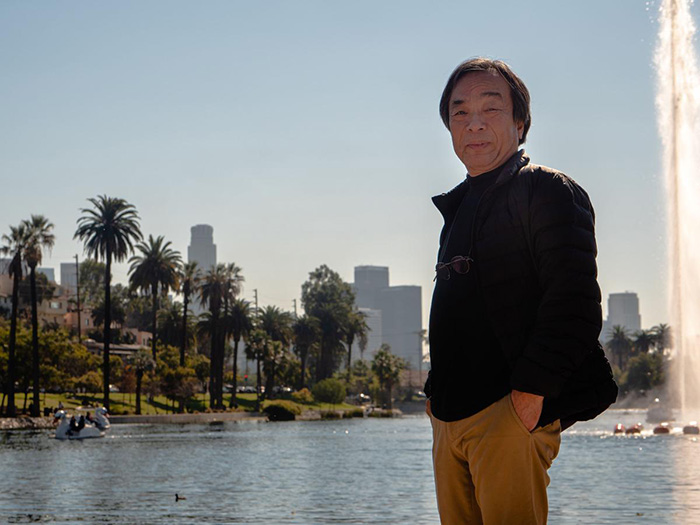
Masaki Fujihata at Echo Park, Los Angeles. Photo by David Leonard.
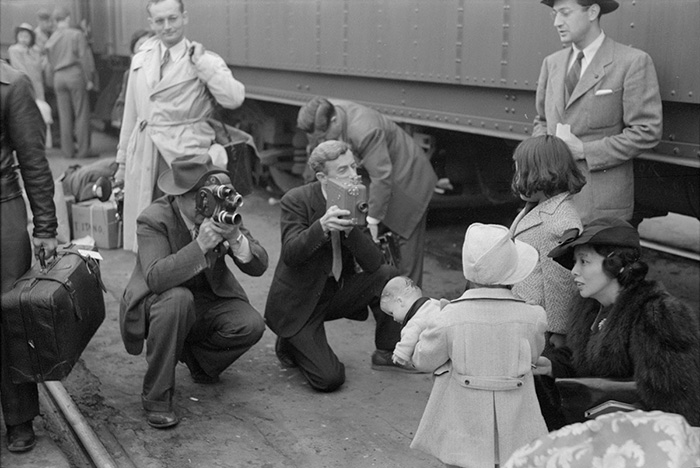
Photo from BeHere/1942 exhibit: Two young girls being filmed as they wait to board a train that will take them to Owens Valley (Manzanar). Photograph by Russell Lee, Los Angeles, California, April 1942. Courtesy of the Library of Congress, loc.gov/resource/fsa.8a31184.
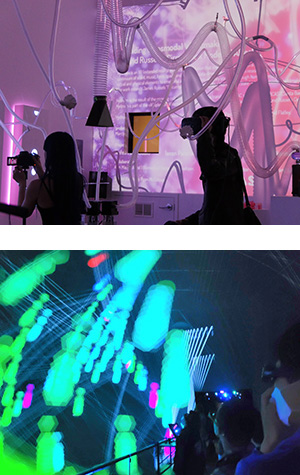
SYMADES (Start of the Year Media Arts Design Engineering and Science) was held on the following dates:
At the event at SBCAST, MAT was pleased to present a guest performance of Song Cycle, first premiered on April 9, 2022 at the Los Angeles Philharmonic. Song Cycle is an immersive performance that describes an emergent world of music, or all the music that could ever happen. The text is randomly generated as a work of process poetry and is set within a texture of mystic drones, the sound of the rain pressed into vinyl, early drum machines, and generous harmonies accompanied by an evolving floral arrangement. Song Cycle is performed by the loose ambient collective superteam and florist Alexandra Rose Franco. The performance is a collaboration between artists Chris Kallmyer and Zoe Aja Moore.
MAT's very own Curtis Roads also performed his piece Always (2013), with visualisation art by Brian O'Reilly (MAT alum).
Both performances were supported by the Systemics Public Events fund and private donors.
MAT is grateful to Alan Macy for his support and generous use of SBCAST in downtown Santa Barbara.
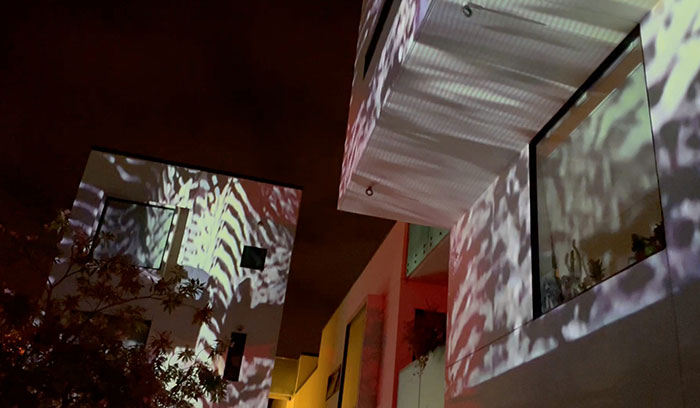
Performance of Always by Curtis Roads at SBCAST. Visualizations by Brian O'Reilly.
Projection mapping by the transLAB.
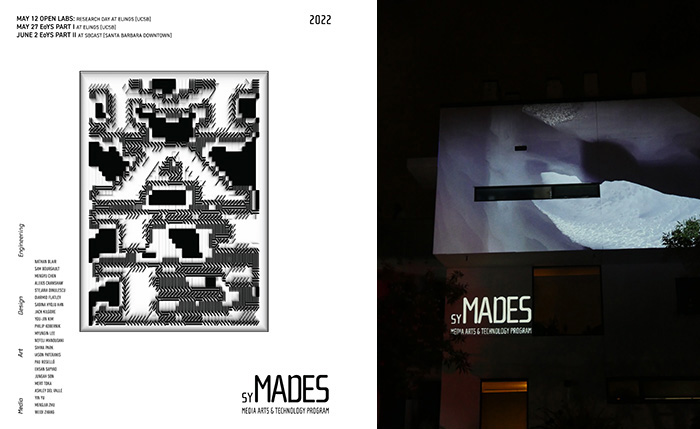
Thursday, June 2nd, 2022
12:00pm (Santa Barbara) / 9:00pm (Berlin) via Zoom
Abstract
In 1958, Iannis Xenakis used a glissandi diagram as the parti for the architectural design of the Philips Pavilion. It was a pioneering example of an architectural form directly derived from the morphology of a sound object. In stark contrast, sound is usually seen as a pollutant, as something to be absorbed, blocked, and diffused in current architectural design and practice. From an architectural design theory perspective, Digital Morphogenesis demonstrates significant theoretical implications in computational design and digital fabrication due to its natural-inspired sustainable methodologies, new forms, fabrication techniques, and multidisciplinary approaches. However, our current architectural and design field does not consider sound material from a morphological perspective in both theory and practice.
My research aims to expand the theory of digital morphogenesis by encompassing sound objects as additional architectural material for computational design and fabrication. I introduce Sound Morphogenesis Design (SMD), a new design framework that uses information theory as a foundation to develop methodologies for architecture and design research. My research explores three main questions: (1) How does architectural practice change when sound is not viewed as pollution but as a design opportunity? (2) How does sound morphology expand the theory of digital morphogenesis and change the approach for architectural design research? And (3) what would be the novel design practice of sound morphogenesis design that enhances aural experiences and aesthetics? By integrating sound morphology in design, this dissertation presents a systematic survey of musical aesthetics in architectural projects and develops two SMD methodologies: WYHIWYW and SoftTectonics. WYHIWYW (What You Hear Is What You Wear) investigates digital domain design techniques such as Digital Design through the Open-Sound-Control Protocol, Computational Design through MIDI, and Computational Design through Modular Synthesizers. Through such techniques, the listening experience enriches and expands the design process. SoftTectonics explores sound morphogenesis from three different approaches using physical prototyping of soft materials: tip-grow, feather-flip, and pneumatic-cavity. SMD methods provide a framework for digital architecture, wearable design, and new media artworks. A novel analysis tool CIMT (Creative-Impact-Musicality-Technology) evaluates the developed research experiments to prove SMD’s contribution as a design theory. The present dissertation paves a path to cross music and architecture for future discovery, design, and human perception.
Speaker: Christina Naomi Tague
Monday, May 16th 2022, at 1pm PDT via Zoom
Abstract
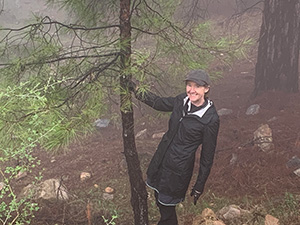
As climate warms, the complex interactions between forests and water also change - and these changes can transform our landscapes. In the Western US, we have already seen increased fire severity, drought, floods, and widespread forest mortality.
Naomi's TagueTeamLab develops a widely used mechanistic model, RHESSys, that simulates interactions among water, carbon, soils and vegetation at scales from a forest plot to a watershed- We use this model to understand our changing landscapes and to predict future changes. Recently she has been collaborating with an artist, Ethan Turpin, and MAT graduate, David Gordon, to translate the data generated by RHESSys into meaningful visualization that can help the public, students and scientists themselves explore how water-trees and climate coevolve. This talk will present this work - and talk about possible future directions.
Bio
Christina Tague's research is focused on the interactions between hydrology and ecosystem processes and, specifically, how eco-hydrologic systems are altered by changes in land use and climate. Much of her work involves developing and using spatial simulation models to integrate data from multiple field-based monitoring studies in order to generalize results to larger watersheds. Reflecting that emphasis, she is one of the principal developers of the Regional Hydro-Ecologic Simulation System (RHESSys), an integrated model of spatially distributed carbon, water, and nitrogen cycling. RHESSys is designed to provide science-based information about spatial patterns of ecosystem health and vulnerability in terms of water quantity and quality. Professor Tague is currently modeling the impacts of climate change on stream-flow patterns in the western United States and examining how urbanization alters drainage patterns and associated biogeochemical cycling in watersheds in Baltimore, Maryland, and Southern California.
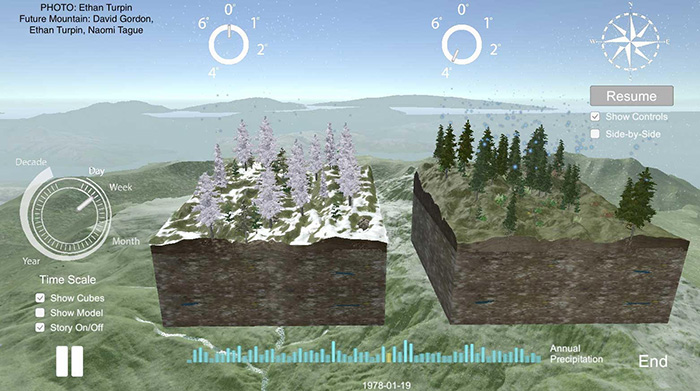
www.geog.ucsb.edu/people/faculty/christina-naomi-tague
For more information about the MAT Seminar Series, go to: seminar.mat.ucsb.edu.
For previous seminars, please visit our MAT Seminars Video Archive.
Speaker: Felecia Davis
Monday, May 16th 2022, at 1pm PDT via Zoom.
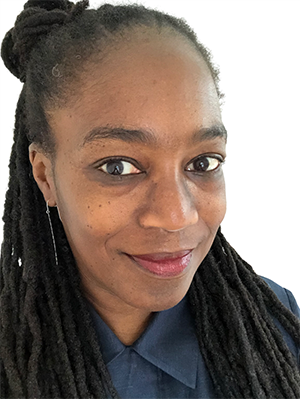
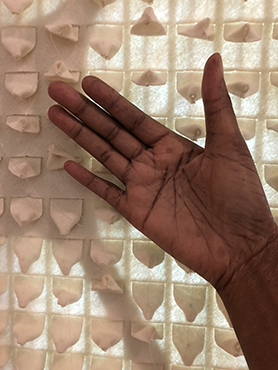
Abstract
Touch of a computational textile on human skin provides a unique opportunity to look at relationships between ambience, emotion and computing. The sense of touch on human skin offers a potential framework to think about ambient computing as the information from skin is multimodal and comes in many forms such as temperature, humidity, sharpness, smoothness, location and movement. Because textiles surround and shelter people in every culture on the planet, they are a culturally embedded and potentially invisible way to create interfaces for people to capture or receive information in ways that engage other senses such as touch. The author of this talk will share work that examines communication of emotion by touch and implications for design computing.
Bio
Felecia Davis’ work in computational textiles questions how we live and she re-imagines how we might use textiles in our daily lives and in architecture. Davis is an Associate Professor at the Stuckeman Center for Design Computing in the School of Architecture at Pennsylvania State University and is the director of SOFTLAB@PSU. She completed her PhD in Design Computation at MIT. Davis’ work in architecture connects art, science, engineering and design and was featured by PBS in the Women in Science Profiles series. Davis’ work was part of the MoMA’s exhibition Reconstruction: Blackness and Architecture in America. She is a founding member of the Black Reconstruction Collective a not-for-profit group of Black architects, scholars and artists supporting design work about the Black diaspora. Davis’ work has been recently recognized by the New York Architectural Leagues’ 2022 Emerging Voices in Architecture program.
www.blackreconstructioncollective.org
For more information about the MAT Seminar Series, go to: seminar.mat.ucsb.edu.
For previous seminars, please visit our MAT Seminars Video Archive.
Speaker: Yasaman Sheri
Monday, May 9th, 2022 at 1pm PDT via Zoom.
Abstract
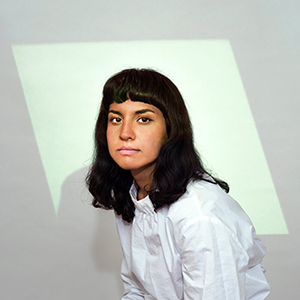
2020 marked an entry into a new era signifying a powerful moment to support aesthetic and political engagements in life sciences and ecology. With rapid advances made in biotechnologies and instruments in perception & sensing technology, artists and designers are an increasingly important voice in shaping how such technologies get rendered at societal level. From ecological awareness around climate change, ethics of geo-engineering, creation of sensing systems, providing glimpses into techno-biological futures, to making with a multitude of species and living systems, the creative inquiry explores the poetic entanglements of living systems & contextualizes conceptually our everyday living. This talk explores sheri’s on-going research & investigation in life sciences through artistic intervention & critical inquiry.
Bio
Yasaman Sheri is a Design Director, Artist & Researcher investigating human relationship to biology & technology and the creative inquiry into life sciences. Her artistic and critical practice explores the plurality of senses and sensing, perception and the invisible scales at which humans frame and reframe ecology through culture, society and technology. She is the founder and Principal Investigator of Serpentine Galleries Synthetic Ecologies Lab and also an educator and design leader with more than a decade of experience in building platforms and novel interfaces in mixed reality and immersive computing as well as life sciences. Yasaman is passionate about sharing her expertise and continues to uplift women identifying communities of color and folks less represented.
For more information about the MAT Seminar Series, go to: seminar.mat.ucsb.edu.
For previous seminars, please visit our MAT Seminars Video Archive.
Speaker: Memo Akten
Monday, May 2nd 2022, at 1pm PDT, ExpVisLab (room 2611) Elings Hall and via Zoom.
Abstract
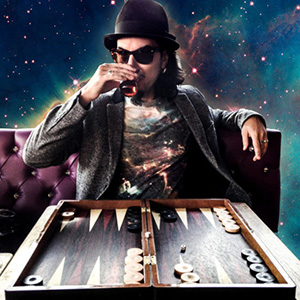
In this talk, Memo discusses the conceptual motivations behind some of his recent works and research involving computational technologies, with a focus on artificial intelligence and machine learning, embodied interaction, and mixed reality. From a practical perspective, this includes explorations in real-time, interactive computational systems for artistic, creative expression; and 'intelligent' systems for human-machine collaborative creativity. From a more conceptual perspective, this involves investigations into how we make sense of the world and project meaning onto noise; and more broadly speaking, the collisions between nature, science, technology, ethics, ritual, tradition and religion; particularly in the context of the current social and political polarizations, moral crises and technological submission.
Bio
Memo Akten is a multi-disciplinary artist, experimental filmmaker, musician and computer scientist from Istanbul, Turkey. He works with emerging technologies and computation as a medium, to create images, sounds, films, large-scale responsive installations and performances. Fascinated by trying to understand the nature of nature and the human condition, he draws from fields such as biological and artificial intelligence, computational creativity, consciousness, neuroscience, physics, biology, ecology, philosophy, ritual and religion. He has a PhD in Artificial Intelligence and expressive human-machine interaction from Goldsmiths University of London, and is Assistant Professor of Computational / New Media Art at University of California, San Diego (UCSD). Akten is a frequent keynote speaker on topics involving art, science, technology and culture. As part of his PhD, he specializes in expressive human-machine interaction and creative explorations of Artificial Intelligence, and in this field he is considered one of the world’s leading pioneers.
For more information about the MAT Seminar Series, go to: seminar.mat.ucsb.edu.
For previous seminars, please visit our MAT Seminars Video Archive.
Speaker: Warren Sack
Monday, April 25th, 2022 at 1pm PDT via Zoom
Abstract
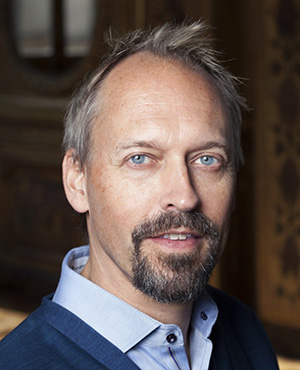
Miniatures, demos and artworks (MDAs) are three kinds of software produced in universities, research laboratories, and the art world. Primarily they are created for teaching, arguing, selling, and sparking the imagination to show a larger public what is possible for the future of software. The most well-known miniature is Minix developed by Andrew Tanenbaum (Vrije Universiteit Amsterdam) to teach students about the workings of the Unix. “The mother of all demos” was produced in 1968 by Douglas Engelbart (SRI) introducing the computer mouse, resizable windows, teleconferencing, hypertext, word processing, and collaborative editing — and basically everything we have today in personal computing. The best-known software artwork is probably Spacewar!, a computer game created by Steve Russell in collaboration with several others at MIT in 1962. In this talk I will describe how MDAs are similar and different from one another, have been used and abused in imagining the future of software. Examples include those from the Yale AI Project of the 1980s (where the design of miniatures was a vital concern); demos from the MIT Media Laboratory of the 1990s (an agonistic environment of “demo or die”); and contemporary artworks from the Whitney Museum of American Art, NYC.
Bio
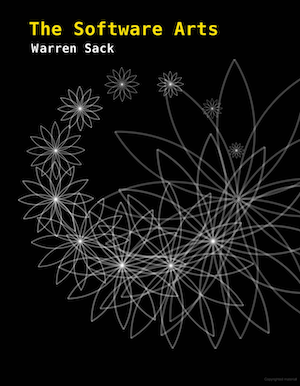
Warren Sack is a media theorist, software designer, and artist whose work explores theories and designs for online public space and public discussion. He is Professor of the Software Arts in the Film + Digital Media Department at the University of California, Santa Cruz where he teaches digital arts and digital studies. He has been a visiting professor in France at Sciences Po, the Fondation Maison des sciences de l'homme, and Télécom ParisTech. His artwork has been exhibited by SFMoMA (San Francisco), the Whitney Museum of American Art (New York), the New Museum of Contemporary Art (New York), the Walker Art Center (Minneapolis), and the ZKM (Karlsruhe, Germany). His scholarship and research has been supported by the Paris Institute for Advanced Study, the American Council of Learned Societies, the Sunlight Foundation, and the National Science Foundation. Warren received his PhD from the MIT Media Lab and was an undergraduate at Yale College.
More about his 2019 book, The Software Arts (MIT Press) can be found at http://softwarearts.info.
For more information about the MAT Seminar Series, go to: seminar.mat.ucsb.edu.
For previous seminars, please visit our MAT Seminars Video Archive.
Tuesday April 19th at 6pm PDT. Studio Xenakis (Music 2215)
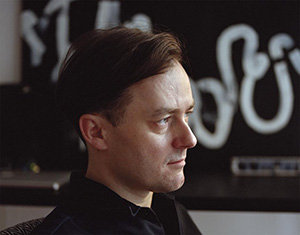
This talk is an introduction to the New Pulsar Generator (nuPG) program. Developed in SuperCollider 3 programming language and using the SuperCollider Server for sound synthesis, nuPG builds upon and extends historical Pulsar Generator (2001) by Curtis Roads and Alberto de Campo. After a brief overview of the program design, the key objective of the talk is to demonstrate a set of formal methods developed by Marcin Pietruszewski as part of his compositional praxis. This includes techniques of sieves, per-pulsar processing, and pulsar- wavelet transform are discussed. The nuPG program offers an established visual mode of data representation and editing. It also provides a text-based (live coding) extension enabling a fast implementation of new algorithmic processes. As a prelude to this talk, the composer encourages the audience to learn about fundamental notions of pulsar synthesis as described in Microsound by Curtis Roads.
Marcin Pietruszewski (b. 1984, Poland) is a composer and researcher. He is engaged in sound synthesis and composition with computers, exploring formal developments in the tradition of electroacoustic music and contemporary sound art. He works across composition, installation, and radio production. Works exhibited at West Court Gallery (Edinburgh, 2019), Remote Viewing (Philadelphia, 2019), and Institute of Contemporary Arts (London, 2017). Commissions by CTM Festival (2021), ZKM Karlsruhe (2018) and Deutschlandradio Kultur (2016). As an educator, Marcin has given courses focused on digital instrument design, digital signal processing, sound theory, and practice. He has taught at The Reid School of Music (Edinburgh College of Art) and Design Informatics (The University of Edinburgh). He also writes on issues related to computer music histories, aesthetics, and technology. His texts have been published by Hatje Cantz and ZKM among others. Currently, Marcin is a Research Fellow in the Department of Computer and Information Sciences of Northumbria University, Newcastle. Marcin lives and works in Berlin.
Speaker: Ekene Ijeoma
Monday, April 18th, 2022 at 1pm PDT via Zoom.
Abstract
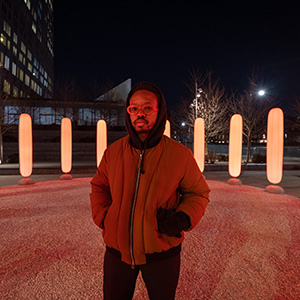
Ekene will share how he works across his studio and lab practices to address social issues through various mediums and scales.
Bio
Ekene Ijeoma is an artist who focuses on the overlooked or shared aspects of sociopolitical trends and interpersonal dynamics through the lenses of personal observation and analytical exploration. He works across various mediums including sound, video, sculpture, installation, and performance.
His work has been exhibited and performed at Bemis Center for Contemporary Art (2021), Contemporary Art Museum of St. Louis (2021), Museum of Contemporary Art Denver (2020), Contemporary Art Museum of Houston (2020), The Kennedy Center (2019, 2017), Museum of the City of New York (2019, 2018), Neuberger Museum of Art (2016), Storefront for Art and Architecture (2015) and Museum of Modern Art (2015) among others.
His practice has been supported by grants and fellowships, including The New York State Council on the Arts (2021); Creative Capital (2019); Map Fund (2019); The Kennedy Center (2017); and New York Foundation for the Arts (2016) among others.
Ijeoma is a first-generation Nigerian-American born and raised in Fort Worth, TX. He lives and works between his studio in Brooklyn, NY, and lab in Cambridge, MA. He earned his BS in Information Technology at Rochester Institute of Technology in 2006 and MA in Interaction Design from Domus Academy (Milan, IT) in 2008. He is an Assistant Professor of Media Arts and Sciences at Massachusetts Institute of Technology and the Founder and Director of the Poetic Justice Group at Media Lab. Currently, his work with Poetic Justice Group focuses on how art can address the scale of sociopolitical issues through multisite participatory public artworks. These works are accessible over the phone, online, and soon on the streets.
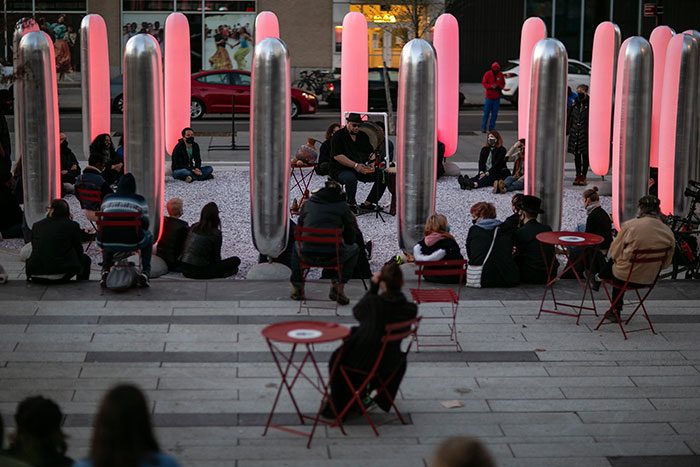
Photo: Kris Graves
For more information about the MAT Seminar Series, go to: seminar.mat.ucsb.edu.
For previous seminars, please visit our MAT Seminars Video Archive.
Speaker: Scott Snibbe
Monday, April 11, 2022 at 1pm PDT, Experimental Visualization Lab (room 2611) Elings Hall and via Zoom.
Abstract
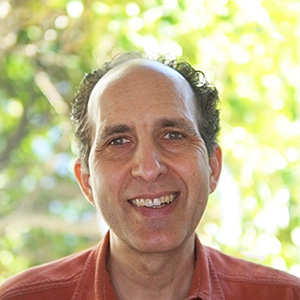
Scott Snibbe will talk about three decades of interactive art that connect people through augmented reality, interactive apps, and embodied social interaction. He’ll touch on the uneasy adoption of interactive art techniques into corporate products, and the way digital art can connect us to others, help us better know ourselves, and even respect respecting privacy in the age of the surveillance state.
Bio
Scott Snibbe is a pioneering interactive artist, augmented reality entrepreneur and the host of the meditation podcast A Skeptic’s Path to Enlightenment. Snibbe’s interactive art installations have been incorporated into concert tours, museums, and airports; and he has collaborated with musicians and filmmakers including Björk, Philip Glass, Beck, and James Cameron. His work can be found in the collections of New York MoMA, the Whitney Museum of American Art, and other institutions. Snibbe has produced several bestselling mobile apps including Gravilux and the world's first “app album” Björk: Biophilia, and was one of the early creators of the special effects animation software Adobe After Effects.
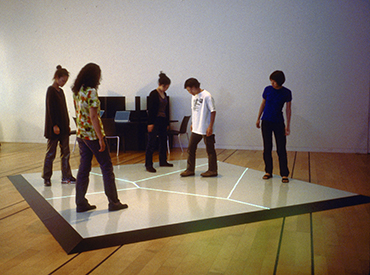
For more information about the MAT Seminar Series, go to: seminar.mat.ucsb.edu.
For previous seminars, please visit our MAT Seminars Video Archive.
Speaker: Marcella Del Signore
Monday, April 4th at 1pm PST via Zoom
Abstract
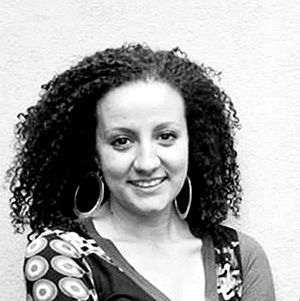
The exploration of the public domain is an important parameter to define how we live as collective and how we can rethink the fundamentals of living. The public realm is an expanded field where the deployment of collective ecologies is inherently connected to the socio-cultural production of space and forms of cohabitation of living systems. The talk addresses the intersection of technologies with the public/social/cultural realm through prototyping, material and fabricated systems, data-driven protocols, and mediated environments. Starting from Aério, an installation recently exhibited at the 17th Venice Architecture Biennale, a series of projects will be the vehicle to speculate on the current and future states of socio-technical apparatuses, interlaced ecosystems, and planetary entanglements.
Bio
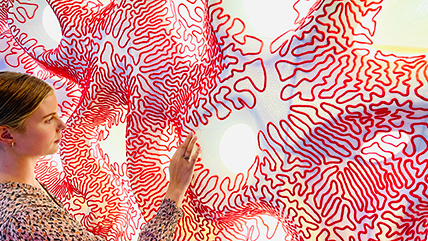
Marcella Del Signore is an architect, urbanist, educator, scholar, and the principal of X-Topia, a design-research practice that explores the intersection of architecture and urbanism with technology and the public, social and cultural realm. She is an Associate Professor and Director of the MS. in Architecture, Urban Design at New York Institute of Technology, School of Architecture and Design. Her research focuses on interscalar design approaches that engage the notion of socio-technical systems through computation, prototyping, material and fabricated assemblies, data-driven protocols, and adaptive environments. Her work investigates architecture, environments, and cities not as isolated entities but as part of an extended field mediated through the discursive application of technology. In her design practice, she has built a wide array of urban interventions and small-scale prototypes recognized through awards, grants, and publications. In 2018, she co-curated the ‘Data & Matter’ exhibition at the ECC during the 2018 Venice Architecture Biennale, and in 2021 she exhibited “Aério” at the 17th Venice Architecture Biennale. She also exhibited her work at the Gardiner Museum, Ogden Museum of Southern Art, MIT Media Lab, Columbia University Buell Center, Rotterdam Biennale of Architecture, Arte Sella, Milan Design Week, Zero1 Biennal, Brooklyn Navy Yard, Duncan Plaza, Architekturzentrum Wien, EME3, and a series of festivals including LunaFete, Urban Prototyping, DesCours, Think Town, Northern Spark, Verdecoprente, and Conflux among others.
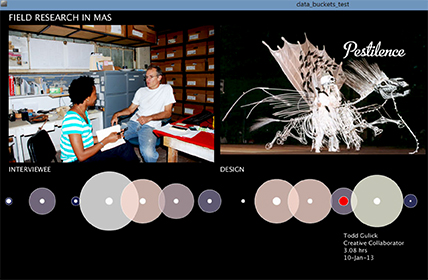
For more information about the MAT Seminar Series, go to: seminar.mat.ucsb.edu.
For previous seminars, please visit our MAT Seminars Video Archive.
Tuesday, March 15th, 2022
2pm PST, transLAB (room 2615), Elings Hall
Abstract
Paideia, a Classical ancient Greek notion of education, encompassed both holistic formal instruction and art (particularly poetry) as means to develop cultural values and understanding. This dissertation examines how the new media arts—as a transdisciplinary and computational field—can be leveraged to fulfill a contemporary notion of paideia in both its practice and instruction, demonstrated through respective artistic and pedagogical proofs-of-concept. Specifically, we analyze the ways in which the computational platform can facilitate the creation and readability of causal relationships across information to embody value, meaning, and holistic thought. To start, we examine how we design affordances—formal qualities that constrain an object’s possible uses by an agent—for guiding participant behavior (observed or enacted) and interpreting meaning as part of experiential learning. We will achieve this through artistic installations and objects. Next, we discuss pedagogical strategies with a cross-disciplinary conceptual framework to support holistic thinking through digital design-based learning. We compare these new efforts toward paideia with ancient Greek media and approaches.
Toward imparting values, the cybernetic nature of physical computing and other interactive systems offer a means to model or to incentivize (and thus train for) certain kinds of participant actions and behaviors. We present an original body of performance and installation work designed to cultivate the values of social cooperation and attention to nuance.
Toward shaping meaning, we propose that complex non-verbal ideas may be communicated by strategic formal design that 1) follows “natural [somatic] mappings” or culturally established associations and/or 2) explicitly defies them, directing attention through “strangeness.” To this end, through a theoretical framework and artistic proofs-of-concept, we explore how computation facilitates abstraction and metaphor via operations of mapping, analysis, and execution.
Lastly, to promote trans-paradigmatic thinking, media arts education and practice through fictional worldmaking can provide a means for organizing complex knowledge and systems. We discuss conceptual framework contributions within the THEMAS (STEAM + creative Humanities) pedagogical model (as originally conceptualized by Marcos Novak).
In these ways, building upon ancient roots, this research both informs the field of media arts and technology and informs education through design strategies for (artistic) experiential and making-based learning.
Monday, March 14th, 2022
10am PST via Zoom
Abstract
Digital fabrication is a rich space for creative production. Many computational tools, including those that support automation, precision, generativity, and parameterization, have been developed to support creativity in fabrication. Emerging digital fabrication tools hold the potential to further expand practices and experiences in digital fabrication, by facilitating more fluid, interactive, and experiential forms of making, in ways that may resemble tools for dynamic digital drawing or real-time audiovisual performance.
However, digital fabrication involves physical materials that introduce constraints that are not present in creative processes involving strictly digital media. For example, creative digital fabrication practices are constrained by the substantial fabrication times that are required. New technologies, tools, and workflows that circumvent such challenges could enable new forms of making, and expand expressive opportunities for creation, by allowing makers to engage more fluidly and interactively with machines and with physical media.
This dissertation investigates this emerging space of opportunity through three key questions: (1) How do current digital fabrication workflows support or constrain aspects of efficiency, iteration, interaction, and expression? (2) How do fabrication modalities with different timescales shape the experience and outcomes of making? (3) How can shorter fabrication timescales be supported given the time constraints of digital fabrication, especially additive digital fabrication?
A first part of the PhD research applies qualitative research methods in examining and analyzing digital fabrication workflows used by professional designers. This analysis characterizes the ways that digital fabrication practitioners apply their knowledge of materials, develop custom software, and leverage incomplete design representations to realize creative and commercially viable products. The analysis highlights the ways that expertise with materials and machine processes are applied in expressive practices that yield feasible products, and how designing viable customizable products influences decisions about geometry, materials, and manufacturing processes, while accounting for costs, effort, and marketability.
The next part of the thesis applies autobiographical research methods in order to investigate how unconventional digital fabrication workflows can facilitate interactive making processes. This research highlights the potential for custom software to integrate digital fabrication with real-time interaction. The results demonstrate how shared human and computer control of fabrication processes can expand opportunities for creative expression, and how constraints of time scale impact the development of digital fabrication workflows for interactive art.
Motivated by such opportunities, and the temporal constraints arising in conventional 3D printing processes, the third part of this dissertation presents a novel additive digital fabrication system, the Liquid-Crystal Printer (LCP), that leverages supercooled liquid solutions to enable rapid 3D fabrication. This printing process is based on the deposition and rapid crystallization of supercooled sodium acetate trihydrate solution. The results illustrate how the parameters of this process provide unique opportunities for controlling the attributes and aesthetics of 3D printed artifacts.
This dissertation contributes new knowledge and methods that highlight the influence of process constraints, including timescales for digital fabrication, on workflows used by professionals designers and artists, and the works they create. It also highlights the potential for new processes and interactive techniques that can leverage emerging technologies for rapid fabrication, and demonstrates the expressive opportunities that such systems can provide.
Speaker: Vernelle A. A. Noel
Monday, March 7th at 1pm PST via Zoom
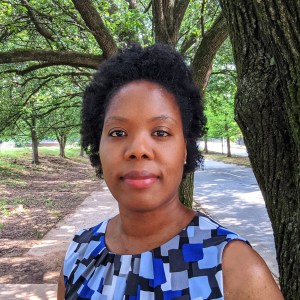
Abstract
Craft practices, knowledges, and communities are disappearing. These practices carry with them histories and cultures of people, knowledges, and social ties to communities. Some reasons for their disappearance include dying practitioners, lacking pedagogy, changing practices, and technocentric developments. How might we employ computation in the restoration, remediation, and reconfiguration of these practices, knowledges, and communities? Additionally, how might knowledges and innovations in these crafts, repair problems and improve research, practice, and pedagogy in computational design? This presentation will share my research into craft and computation such that our field touches the ground, communities, and critically considers access.
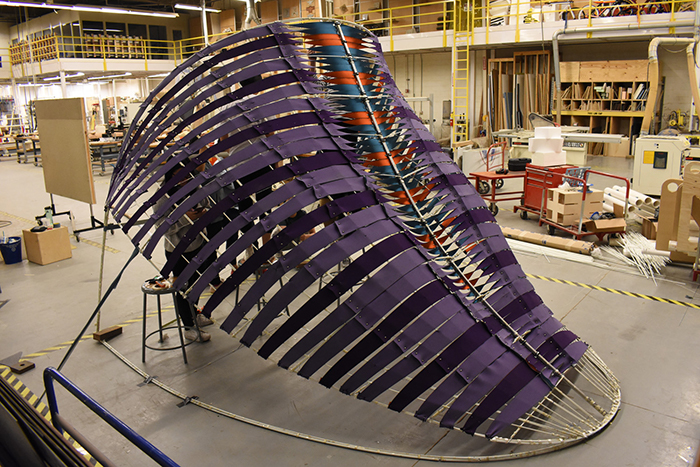
Bio
Vernelle A. A. Noel, Ph.D. is a design scholar, architect, artist, and Founding Director of the Situated Computation + Design Lab at the Georgia Institute of Technology. Currently an Assistant Professor in the School of Architecture and the School of Interactive Computing, her research examines traditional and automated making, human-computer interaction, interdisciplinary creativity, and their intersections with society. She builds new expressions, tools, and methodologies to explore social, cultural, and political aspects of computational design, and emerging technologies for new reconfigurations of practice, pedagogy, and publics. Her work has been supported by the Graham Foundation, the Mozilla Foundation, and ideas2innovation, among others, and she is a recipient of the 2021 DigitalFUTURES Young Award for exceptional research and scholarship in the field of critical computational design. Dr. Noel has been a Visiting Professor, researcher, and educator at the Cluster of Excellence in Computational Design (IntCDC) at the University of Stuttgart, the University of Florida, Penn State, MIT, the Singapore University of Technology & Design, and has practiced as an architect in the US, India, and Trinidad & Tobago.

For more information about the MAT Seminar Series, go to: seminar.mat.ucsb.edu.
For previous seminars, please visit our MAT Seminars Video Archive.
Tuesday, March 8th, 2022
12 noon PST via Zoom
Abstract
Vishnu Narayan Bhatkhande (1860 – 1936) was one of the most prominent musicologists in the history of India who wrote the first modern treatise on North Indian Classical Music, an art which had been propagated earlier mostly through oral tradition. Early in the 20th Century CE, he wrote a series of books of great current renown; perhaps the best-known of these is his Hindustānī Sangīt Paddhati – Kramik Pustak Mālikā (System of Hindustani Music - Book Series), written in the North Indian language Marathi, in which he outlined his system of the categorization of the North Indian modal system: he classified the hundreds of known rāga-s (scales replete with instructions for melodic movement) into ten modes called thāṭ-s which form the basis of current North Indian Classical Music theory. This six-volume work illustrates the rāga-s and their thāṭ-s by the inclusion of ~1900 different short Hindustani classical music compositions. In 1968 the Czech-born composer Walter Kaufmann, then professor of musicology at Indiana University, Bloomington, published his book The Ragas of North India, in which he transcribed into Western staff notation a generous selection of the compositions in Bhatkhande’s Kramik Pustak Mālikā. However, Bhatkhande’s work – apart from Volume I, a very brief introductory booklet comprising only 68 pages – has never been translated into English. This project has as its goal the porting into Western staff notation of all ~1900 compositions in the 3,500-odd pages of the Kramik Pustak Mālikā to make it accessible to the Western music community. Given the large scope of the work, the solution is to leverage and build technology into the software platform - InSargam - Indian Classical Music Notation Editor that can export Western staff notation and accomplish this task.
Wednesday, March 9th, 2022
3pm PST via Zoom
Abstract
When a sound source is spatialized over loudspeakers, the source undergoes a series of transformations before it ultimately reaches the listener. The source is first transformed by panning and other spatialization algorithms based on its spatial parameters in what this dissertation calls the virtual field. Next, the source is projected by the loudspeaker array into the acoustic field further transforming the source. The virtual field, loudspeaker array, and acoustic field form the spatial audio field (SAF) which significantly influences how a spatial composition is perceived.
The majority of current spatial techniques focus on manipulation of a source's spatial parameters and parameters of the spatial image. While sources in spatial audio compositions are assigned positions and trajectories that often change throughout the work, the spatialization algorithms of the virtual field are usually fixed, the loudspeaker array does not change, and the acoustic field rarely changes during the performance. Thus the specific SAF used in a given work, whether constructed deliberately as part of the compositional process, or constructed arbitrarily, is usually static.
The SAF is largely unexplored for new compositional techniques on short musical timescales. As the loudspeakers and acoustic field are physical components of the SAF, changes to each are only practical on larger timescales from musical phrases to form. However, as the virtual field is usually constructed digitally, it can be changed on timescales down to the sample rate. Therefore, the focus of this research is on developing compositional techniques in the virtual field.
To carry out this research, an experimental software program was developed that not only allows for realtime spatialization of multiple audio sources, but also allows for realtime changes to the virtual field. This research has led to the development of new compositional elements, methods of synthesis, and spatial extensions to traditional compositional techniques.
Speaker: Sharon Daniel
Monday, February 28th at 1pm PST via Zoom
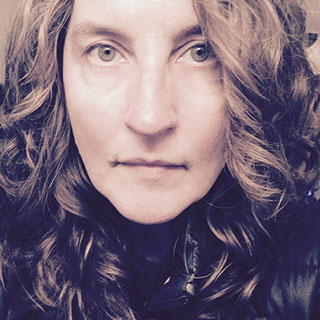
Abstract
In the 15th century, Venetians invented Quarantine as a protection against the plague. In the Mid-20th century, Americans invented a criminal punishment system based on the model of Quarantine in which the disproportionately poor, Black, or Brown ‘offender” is treated as a pathogen to be isolated and contained. In the 21st century, COVID-19, an actual pathogen, has both exposed and intensified the brutality of that system — prisoners have been stranded in quarantine without adequate food or medication, abandoned and unseen. In the US over 2 million people are confined in overcrowded, unsanitary, and unsafe environments. Prisoners cannot practice social distancing or use hand sanitizer and are regularly subjected to medical malpractice and neglect. In this seminar presentation, I will focus on the interactive documentary EXPOSED, which provides a cumulative public record and evolving history of the coronavirus pandemic’s impact on incarcerated people. EXPOSED, documents the spread of COVID-19, over time, inside prisons, jails, and detention centers across the US, from the perspective of prisoners and their advocates. Original interviews, along with quotes, audio clips, and statistics collected from a comprehensive array of online publications and broadcasts, are assembled into an interactive timeline that, on each day, offers abundant testimony to the risk and trauma prisoners experience under coronavirus quarantine. The scale of the project is intended to reflect the scale of the crisis. There are now over 11,000 entries in the project database. The monochrome, image-less, headline-styled interface, which allows viewers to step through thousands of prisoners’ statements, is designed to visualize their collective suffering and signal that the injustices they endure are structural.
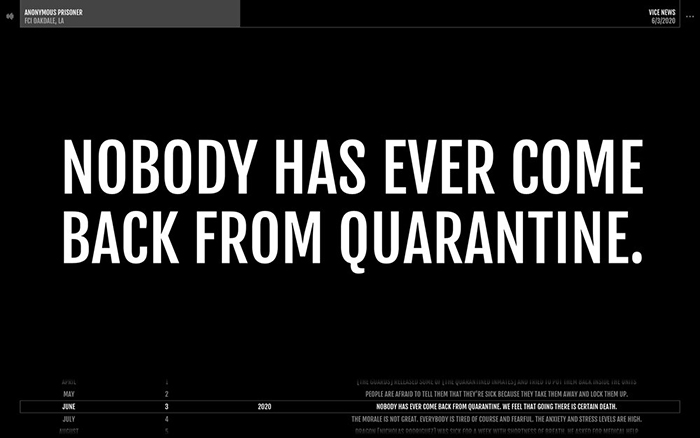
Bio
Sharon Daniel is a media artist who creates interactive and participatory documentary artworks addressing issues of social, racial, and environmental injustice, focusing principally on mass incarceration and the criminal legal system. She develops innovative online interfaces and multi-media installations that visualize and materialize the testimony of incarcerated people. Her work has been exhibited in museums and festivals internationally. Her work has been honored by the Webby Awards, a Rockefeller/Tribeca Film Festival New Media Fellowship, and a Fulbright Fellowship. She was named in the Yerba Buena Center for the Arts “YBCA 100” – a list of “the creative minds, makers, and pioneers that are asking the questions and making the provocations that will shape the future of American culture.” Daniel is a Professor of Film and Digital Media at the University of California, Santa Cruz.
For more information about the MAT Seminar Series, go to: seminar.mat.ucsb.edu.
For previous seminars, please visit our MAT Seminars Video Archive.
Speaker: Sofian Audry
Monday, February 14th at 1pm PST via Zoom
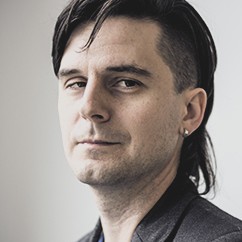
Abstract
A talk by transdisciplinary artist-researcher Sofian Audry on machine learning art and its practice in new media art and music, presenting as an overview of Audry's new book at MIT Press.
Bio
Sofian Audry is an artist, scholar, Professor of Interactive Media within the School of Media at the University of Quebec in Montreal (UQAM) and Co-Director of the Hexagram Network for Research-Creation in Art, Culture and Technology. Audry's work explores the behavior of hybrid agents at the frontier of art, artificial intelligence, and artificial life, through artworks and writings. Audry's book Art in the Age of Machine Learning examines machine learning art and its practice in art and music (MIT Press, 2021). Their artistic practice branches through multiple forms including robotics, installations, bio-art, and electronic literature.
For more information about the MAT Seminar Series, go to: seminar.mat.ucsb.edu.
For previous seminars, please visit our MAT Seminars Video Archive.
Speaker: Simon Penny
Monday, February 7th at 1pm PST via Zoom
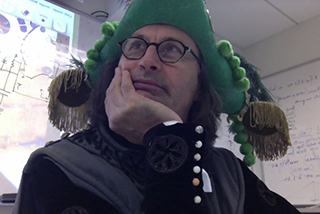
Abstract
This presentation will focus on my research into distributed, inactive, and embodied cognition as it relates to the arts, and on my critical interrogation of computing history and rhetoric - all of which has arisen out of, and in parallel with, my practice as an artist in interactive, robotic and virtual media. The presentation will begin with an introduction to two works, followed by a discussion of the philosophical ideas that have informed computing and the mind. Questions will gravitate around the issues raised during the presentation and around the two assigned papers: One examines the history of digital media arts in the 90s, the other addresses issues of cognition related to contemporary digital media.
Bio
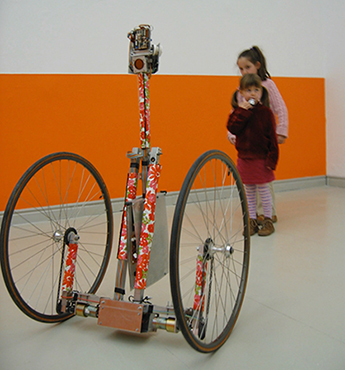
Simon Penny is an artist, theorist, and teacher with a longstanding focus on emerging technologies and on embodied and situated aspects of artistic practice. He has built interactive installations and robotic art since the mid-1980s. He explores - in artistic and scholarly work and in technical research - problems encountered when computational technologies interface with cultural practices. His longstanding concern for embodied and situated aspects of aesthetic experience, along with a critical analysis of computer culture, is the focus of his book Making Sense: Cognition, Computing, Art and Embodiment (MIT press 2017). He was director of A Body of Knowledge: Embodied Cognition and the Arts conference UCI 2016, and An Ocean of Knowledge: Pacific Seafaring, Sustainability and Cultural Survival at UCI in 2017. He is co-director of the Industrial Crafts Research Network. He was Professor of Art and Robotics at Carnegie Mellon (1993-2000). He founded the Arts Computation Engineering (ACE) graduate program at the University of California Irvine, 2001-2012. He was visiting professor in media theory, Cognitive Systems, and Interactive Media masters, University Pompeu Fabra, Barcelona, 2006-2013, and Labex International Professor, University Paris8 and ENSAD in 2014. Penny is currently a professor in Electronic Art and Design (Dept of Art) at the University of California, Irvine, with appointments in the dept of Music and in Informatics (School of Information and Computer Science). He is a guest professor at the School of Art and Design, Nottingham Trent University UK, 2021-2024.
For more information about the MAT Seminar Series, go to: seminar.mat.ucsb.edu.
For previous seminars, please visit our MAT Seminars Video Archive.
Speaker: Maja Smrekar
Monday, January 31st at 1pm PST via Zoom
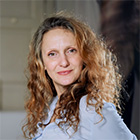
Abstract
Artist talk on Maja Smrekar’s work that derives on an interdisciplinary artistic research, exploring intersections between the human and the animal and intertwines these contexts with technology. Her work stems from the premise that human life is above all, about other than human entities that disrupt the division into subject and object. In her attempts to challenge these relations, she establishes contexts beyond the laws of genus and species or race or gender, constructing situations that happen on a (micro-)political level and furthermore on a molecular one. Drawing inspiration from different media, including performative elements, such as durational and photo performance; Smrekar extends her work into micro performativity that emphasizes on the processes within the human body and also includes nonhuman subjectivities.
Bio
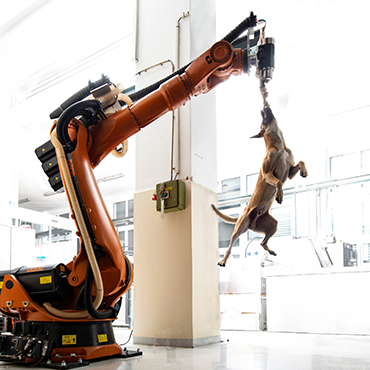
Smrekar's work has been established in the international art and science milieu. Her projects explore the potentials of technologically and scientifically rooted processes and materials, such as from biotechnology, molecular biology, reproductive biomedicine, ecology, ethology, artificial intelligence, soft robotics, etc. Her practice has allowed her to lead strong collaborations in developing productions that include cross-conceptual staging of hybrid art, performance, installations, site-specific, and video as well as contributions to knowledge exchanged within lectures, talks and texts. She exhibited in the following spaces: ZKM Karlsruhe (Germany), Hyundai Motorstudio Beijing (China), MAXXI - National Museum of 21st Century Art in Rome (Italy), Zuercher Gallery / Frieze New York (USA), RMIT Gallery Melbourne (Australia), etc. and festivals: Ars Electronica (Linz, Austria), Click festival (Elsinore, Denmark), Transmediale (Berlin, Germany) ... In 2017 she was the recipient of the Prix Ars Electronica - Golden Nica 2017 in the Hybrid Arts Category (Linz / Austria).
For more information about the MAT Seminar Series, go to: seminar.mat.ucsb.edu.
For previous seminars, please visit our MAT Seminars Video Archive.
Speaker: Jonas Jørgensen
Monday, January 24th at 1pm PST via Zoom
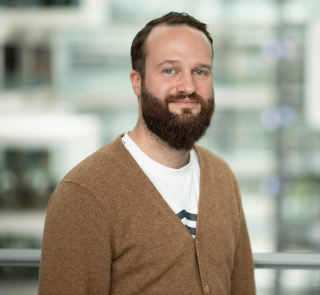
Abstract
Soft Robotics designates a novel approach to designing robots anchored in the simple idea of using compliant structures and elastic materials rather than rigid metal or plastic parts. In this seminar talk, I introduce the research and creation program of Soft Robot Aesthetics that seeks to unite interests and methodological approaches drawn from artistic research, art history, human-robot interaction, and technical soft robotics research. The broad overall aim of this body of work is to explore alternative versions of what soft robotics might be or become if approached from the point of view of art and aesthetics, and how a more nuanced understanding of the potentials and consequences of rendering a robot soft can be attained through aesthetic practices. The talk describes selected work done at the Center for Soft Robotics at the University of Southern Denmark, including our ongoing collaboration with Maja Smrekar on the final chapter of the !brute_force series. Through methodological considerations and reflections on case study projects, I aim to illustrate how artistic and aesthetic perspectives may generate distinct types of questions and insights about soft robots, as well as singular outcomes, of which some are useful for robotics research more broadly.
Bio
Jonas Jørgensen is Assistant Professor at the Center for Soft Robotics at the Biorobotics section of the University of Southern Denmark. Jonas was originally trained as a physicist (BSc) and an art historian (BA, MA) at Univ. of Copenhagen and Columbia University (New York). He received a Ph.D. degree at the IT University of Copenhagen as a member of the Robotics Evolution and Art Lab (REAL). Jonas’s research and practice span the fields of robotic art, soft robotics, human-robot interaction, and media art history. He has presented papers and organized workshops at several high-ranking international conferences and is the author of more than 20 peer-reviewed publications. With different collaborators, Jonas has created robotic art projects that have been exhibited internationally at institutions including Ars Electronica (Linz, Austria), Chronus Art Center (Shanghai, China), and Science Gallery Dublin. Jonas currently serves as a management committee member representing Denmark in the EU COST action CA18136 “European Forum for Advanced Practices” (2019-2023) that focuses on emerging practice-based transdisciplinary practices. Together with Maja Smrekar, he is also a partner in the EU’s STUDIOTOPIA program.
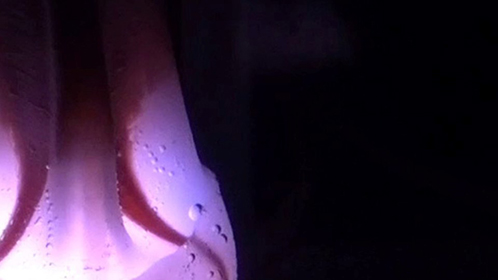
For more information about the MAT Seminar Series, go to: seminar.mat.ucsb.edu.
For previous seminars, please visit our MAT Seminars Video Archive.
Speaker: Marcos Lutyens
Monday, January 10th at 1pm PST via Zoom
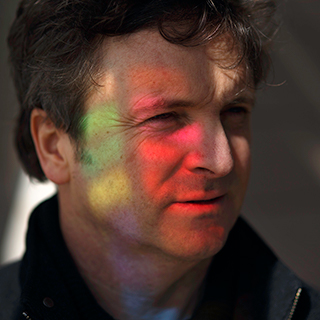
Abstract
A talk by internationally recognized artist Marcos Lutyens covering the trajectory of his work that centers around consciousness. His emergent work spans neuroscience, shamanism, performance art, hypnosis, networked video, augmented reality, and various other art forms, seeking to expand what we consider to be the roots of consciousness.
Bio
In his explorations of consciousness, Lutyens has collaborated with celebrated neuroscientists V. Ramachandran and Richard Cytowic, as much as studying under shamans from different cultures. His works take form in installations, sculptures, drawings, short films, writings, and performances. Lutyens has exhibited internationally in numerous museums, galleries, and biennials, including the Royal Academy of Arts, Centre Pompidou, National Art Museum of China, Documenta, and the Biennials of Venice, Istanbul, Liverpool, São Paulo.
For more information about the MAT Seminar Series, go to: seminar.mat.ucsb.edu.
For previous seminars, please visit our MAT Seminars Video Archive.
Thursday January 13th at 6pm Pacific Time via Zoom.
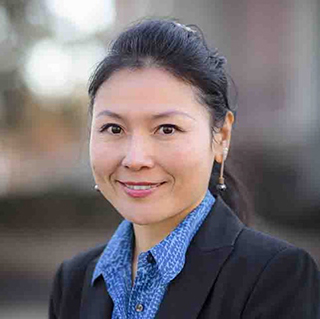
This lecture introduces an innovative online teaching pedagogy in sound design and modular synthesis. It uses open-source software to improve student-centered learning outcomes during the ongoing COVID-19 pandemic. We wanted to achieve a similar level of engagement as in-person classes, inspire a diverse student body, offer ample technical and mental support, as well as open the possibility of learning sound design through Eurorack modular synthesizers without investing money in expensive hardware. Human subjects research was conducted during the course to improve the students’ learning experience and shape the pedagogy. The qualitative and quantitative data indicates the effectiveness of student-centered pedagogy. We promoted social interaction and student well-being while teaching challenging topics during challenging times.
Dr. Jiayue Cecilia Wu is a scholar, composer, vocalist, multimedia technologist, and audio engineer. She earned her Bachelor of Science degree in Design and Engineering in 2000. She then worked as a professional musician at Universal Music Group and EMI Records for ten years. In 2013, she obtained a Master of Arts degree in Music, Science, and Technology at Stanford University. In 2018, she received a PhD in Media Arts and Technology from the University of California Santa Barbara. Dr. Wu's work focuses on designing and using media technology to compose music for meditation and healing. Her work has been exhibited at museums and arts/science societies such as the National Museum of China, Denver Art Museum, IEEE, Linux Audio, ISEA, ICMC, NIME, AES, and SEAMUS. She is the chairperson of the Diversity, Equity, and Inclusion Committees for both AES and Colorado MahlerFest. She also serves as a voting member of the Recording Academy (Grammy), the Editor-in-Chief of SEAMUS, and the board director-at-large of ICMA. Currently, Dr. Wu is an assistant professor at the University of Colorado Denver’s College of Arts and Media.